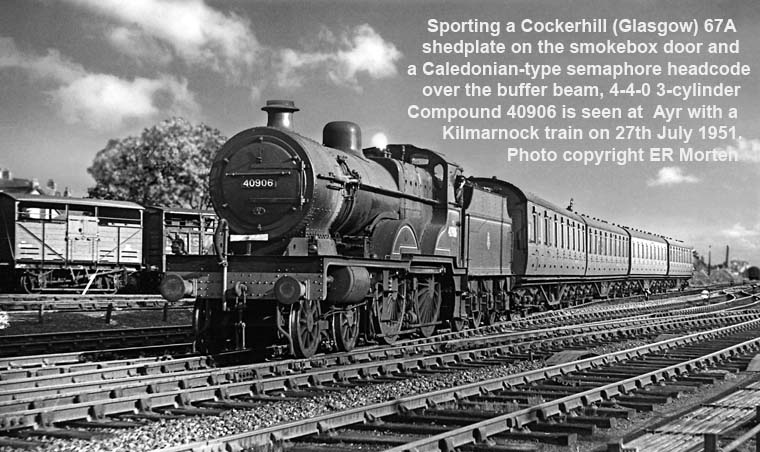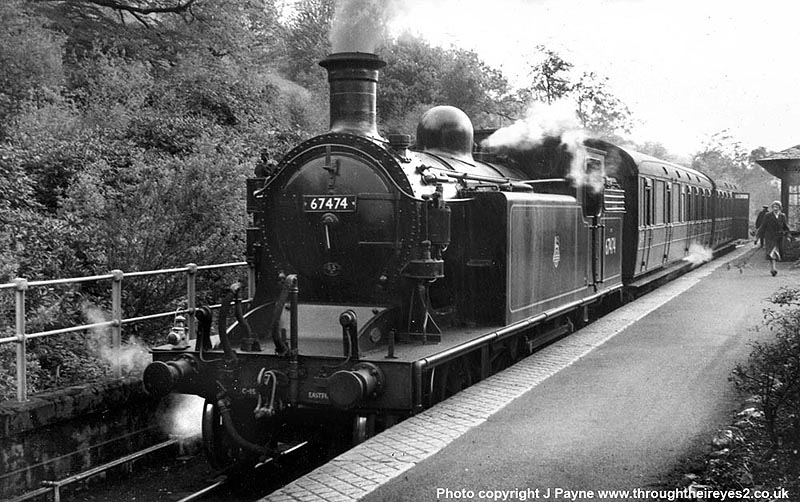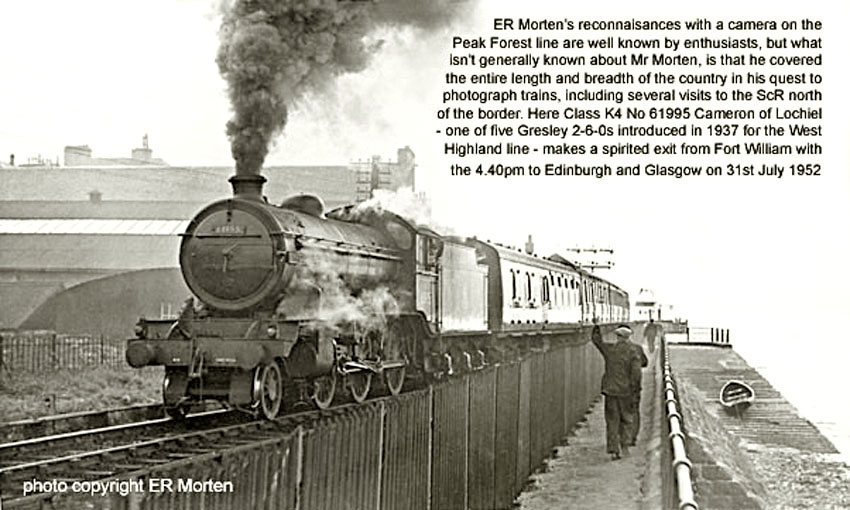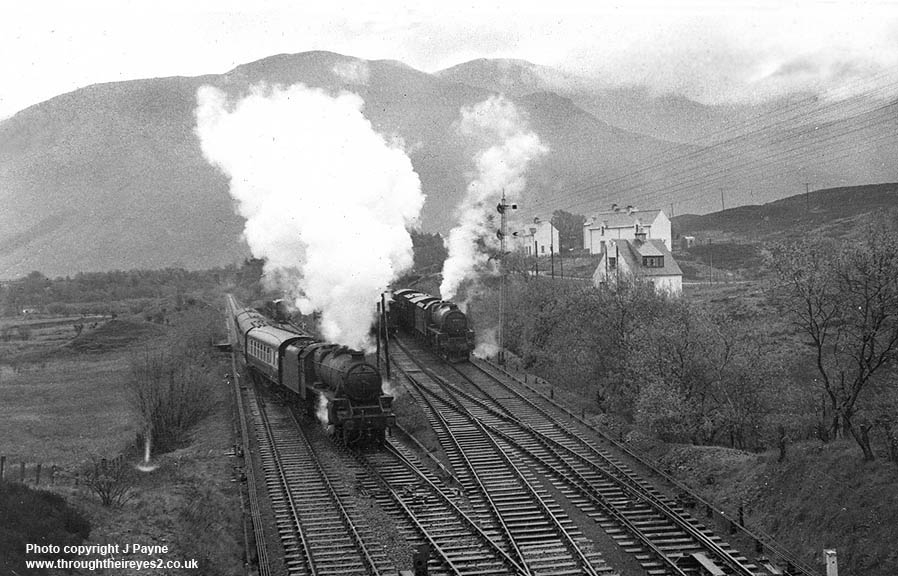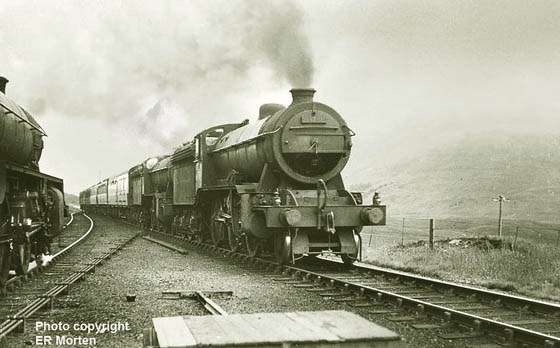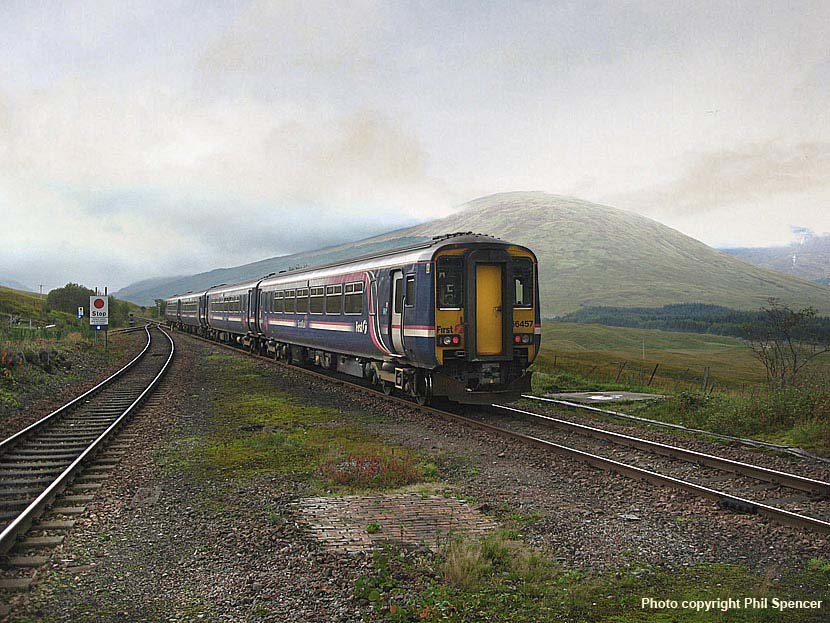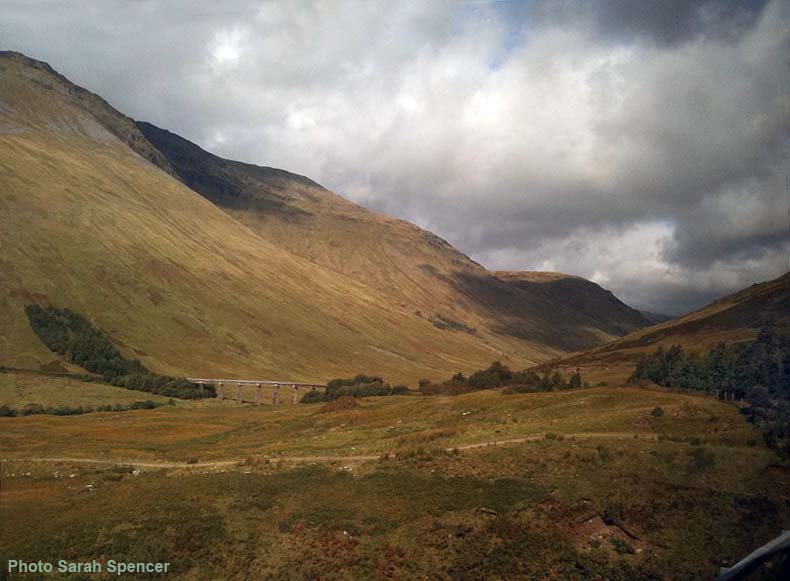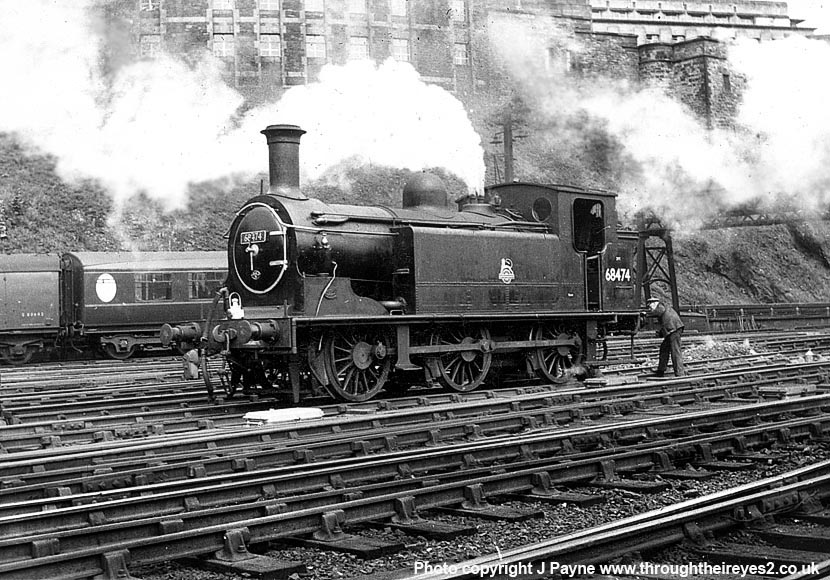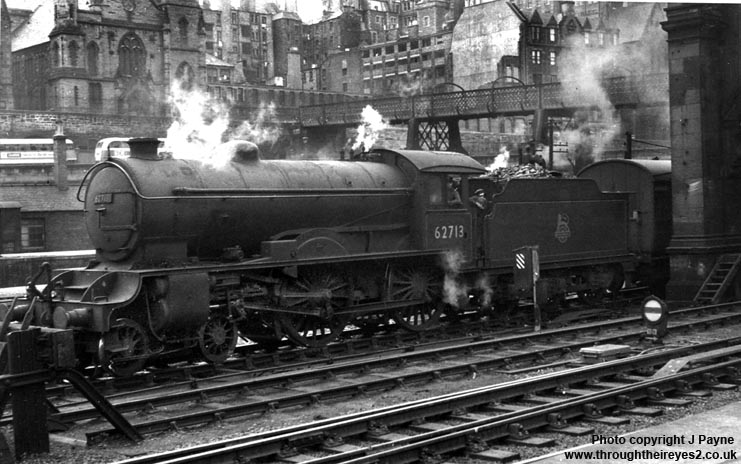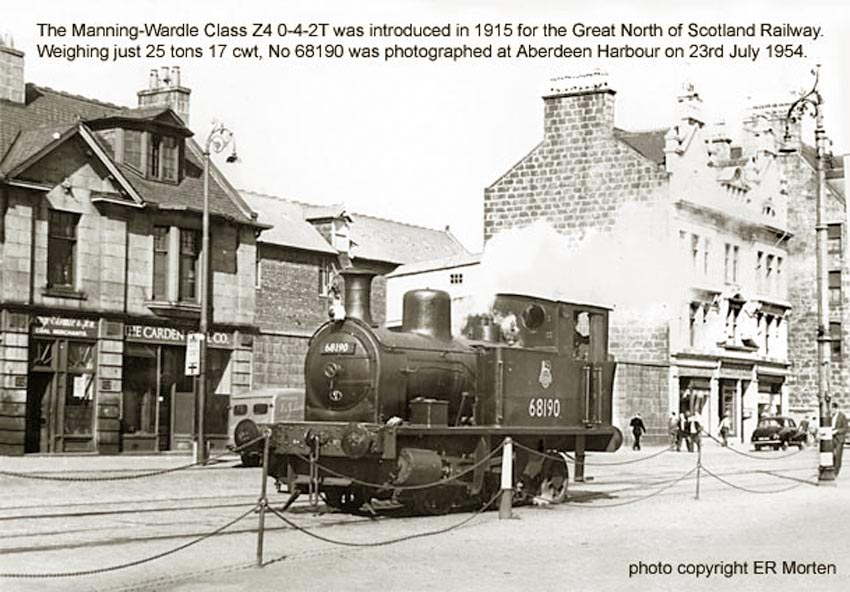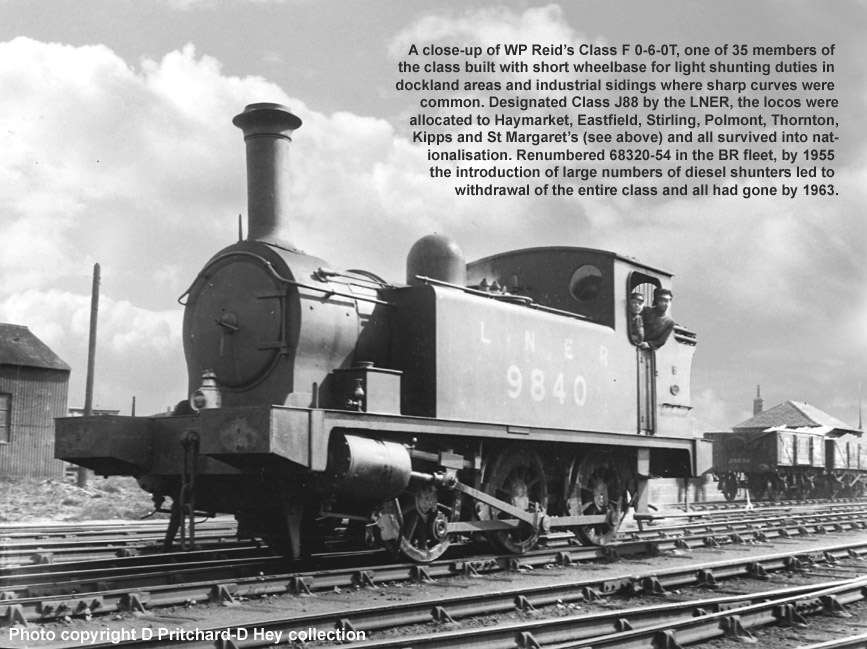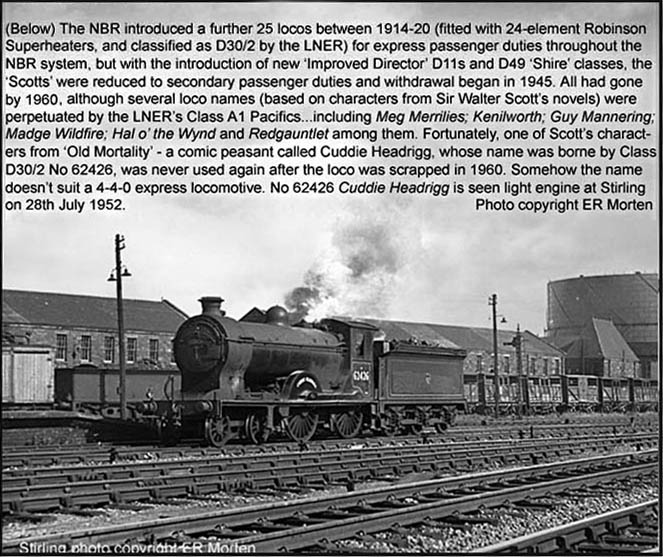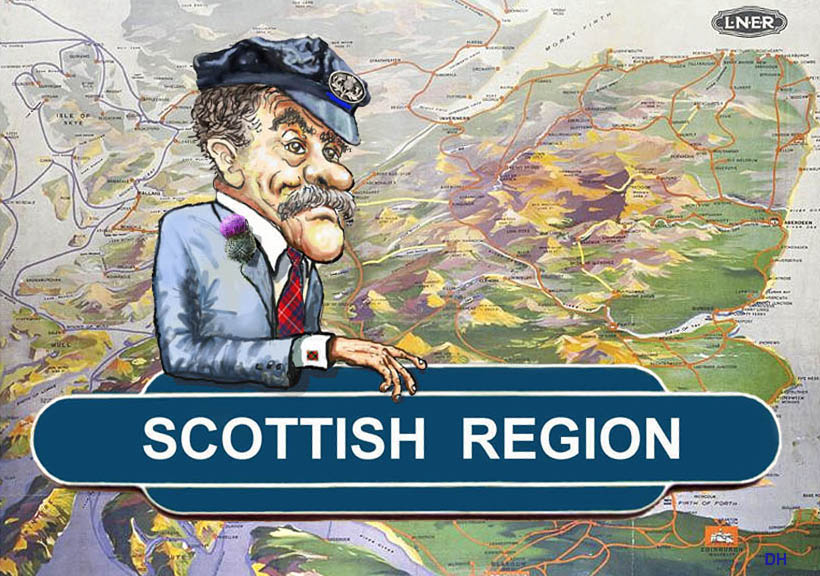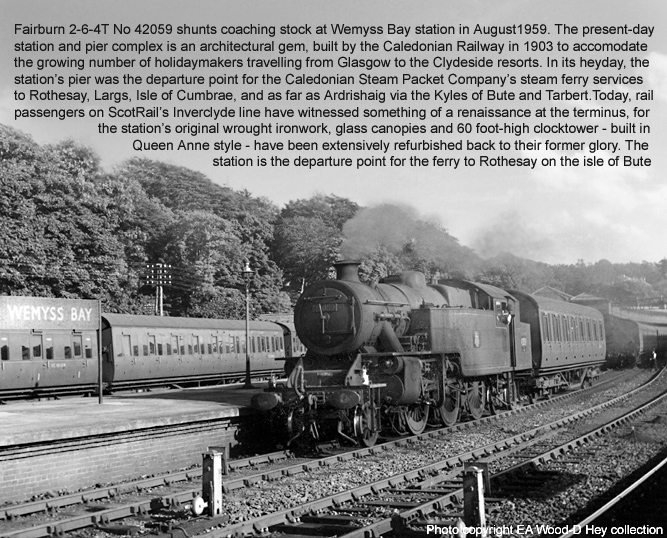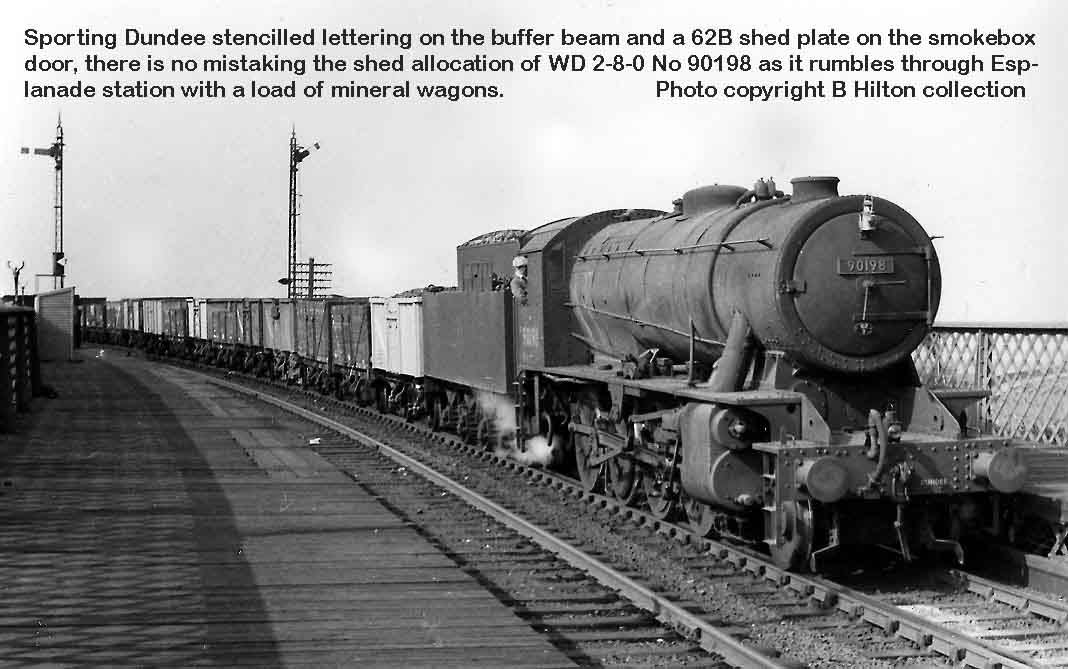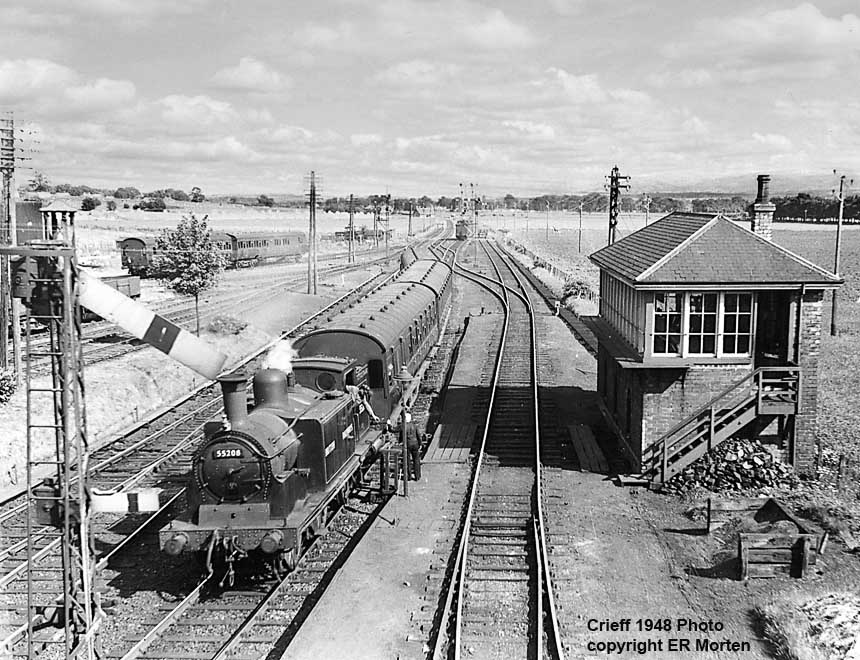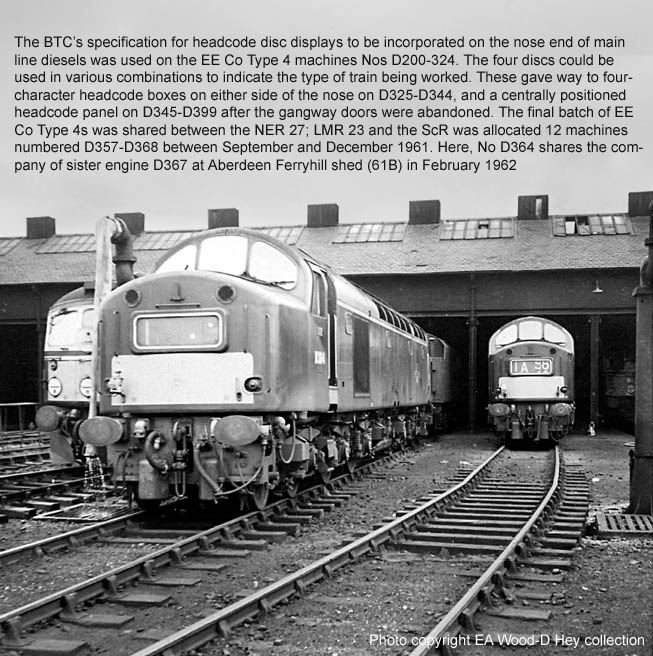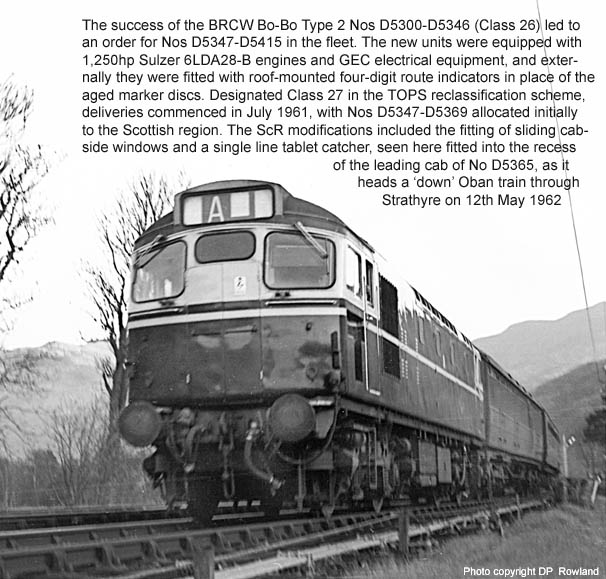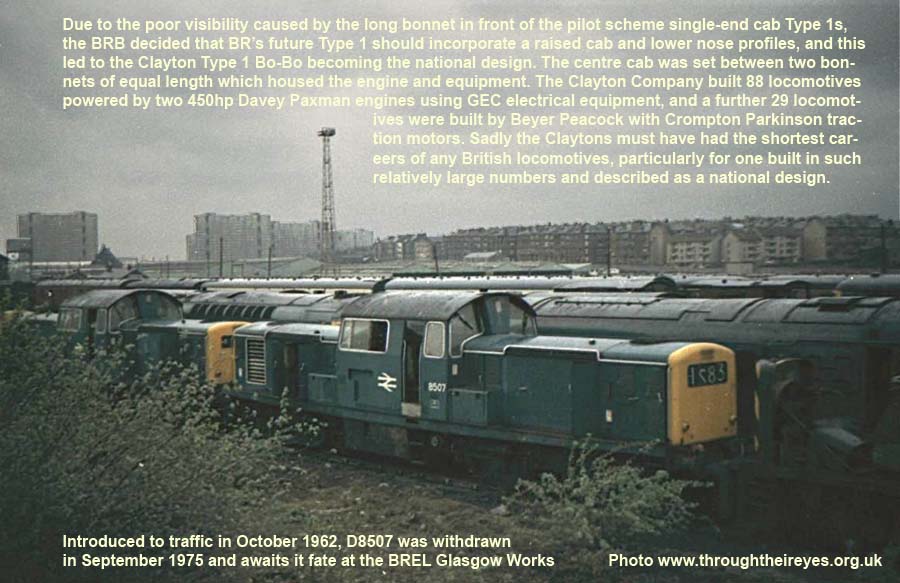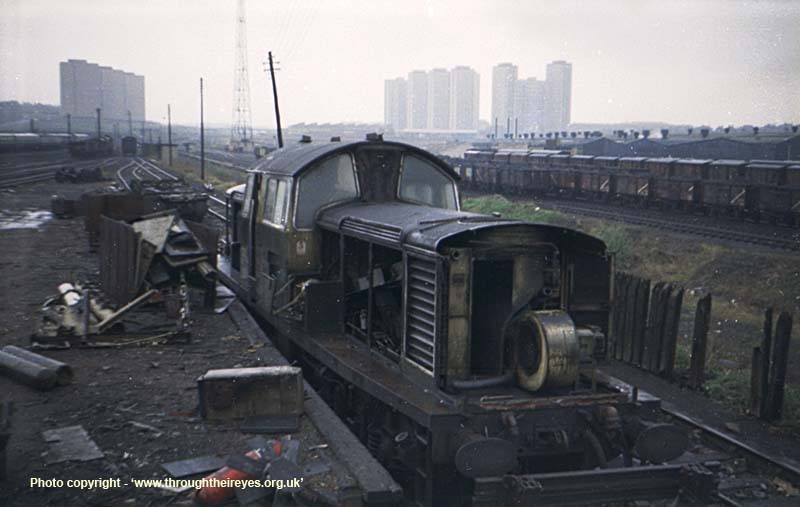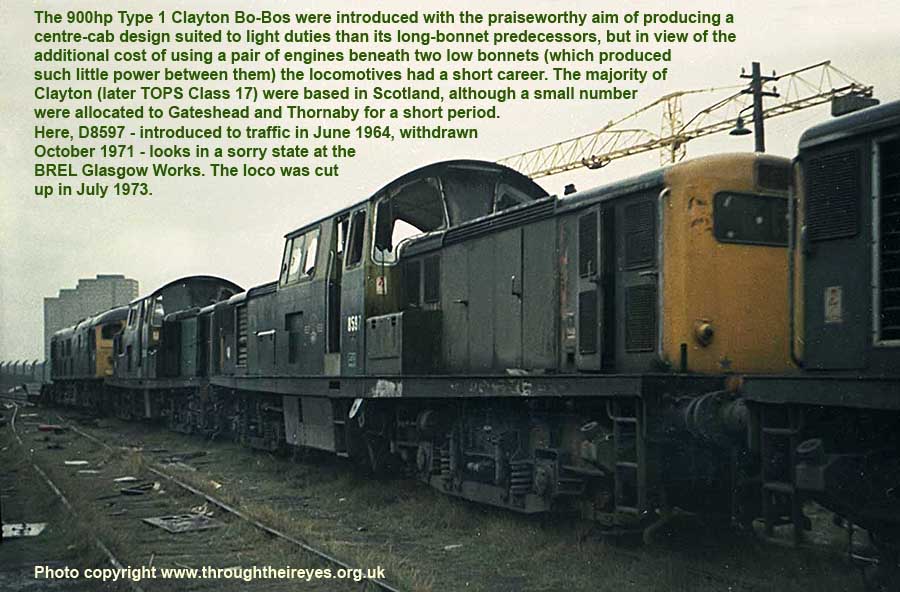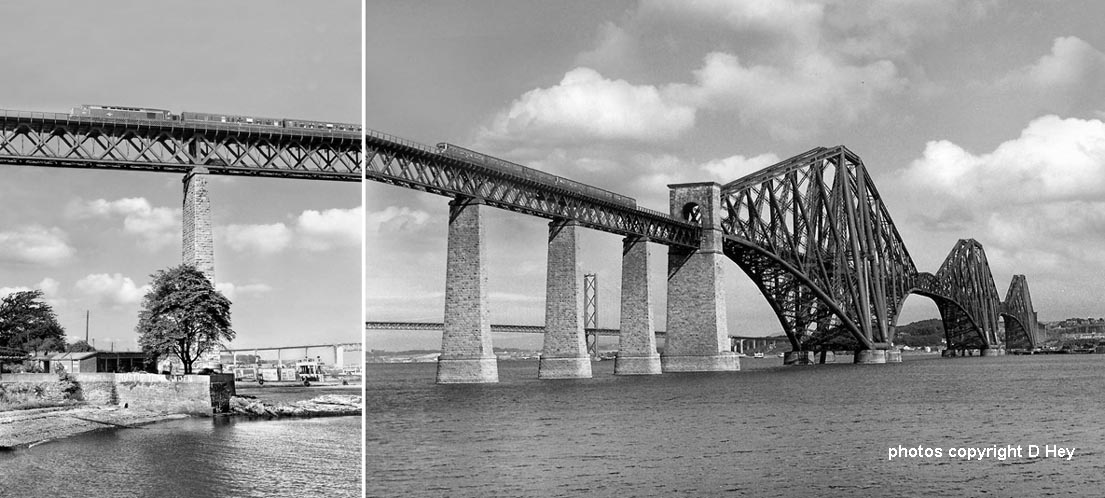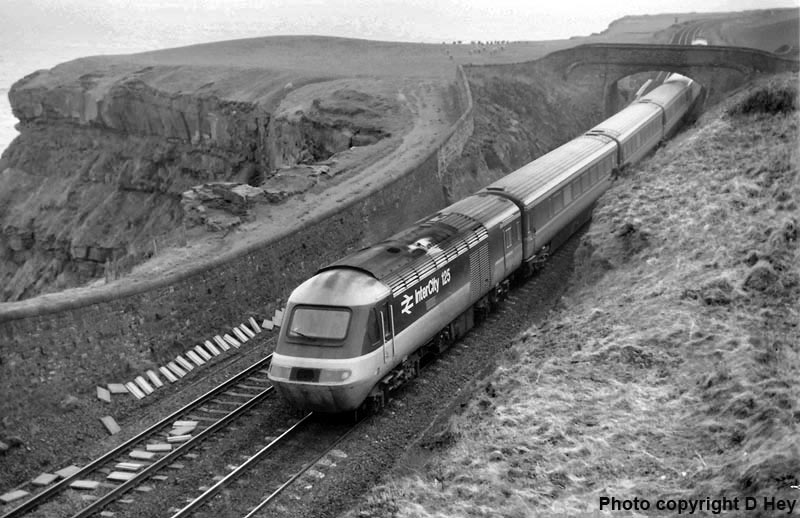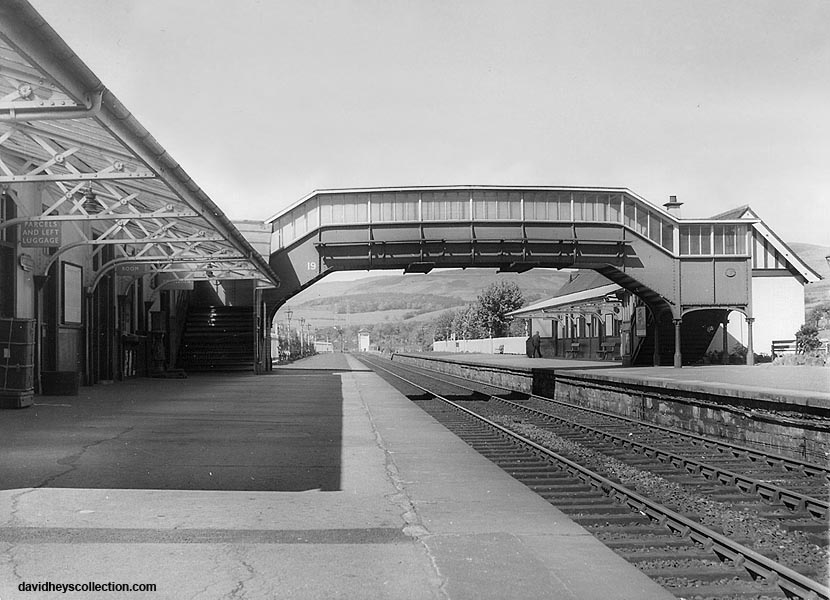On January 1st 1948, the former 'Big Four' railway companies: London North Eastern Railway (LNER); London Midland & Scottish Railway (LMSR); Great Western Railway (GWR) and Southern Railway (SR) were amalgamated to form the new British Railways. A total of 20,211 steam locomotives were taken into State ownership consisting of: 1,838 from the SR, 3,856 from the GWR, 6,525 from the LNER, and 7,805 from the LMSR. The rest was made up of service engines and Departmental locomotives.
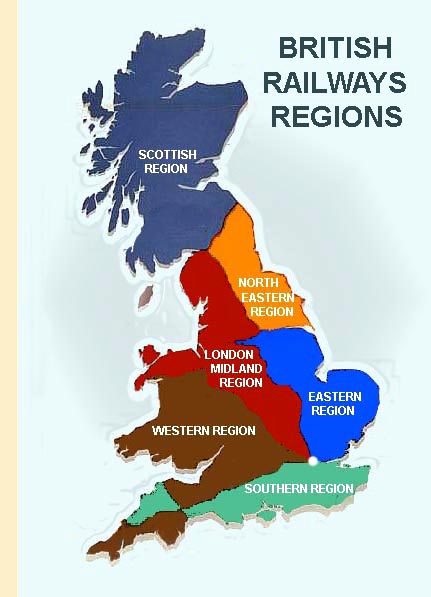 In 1948, six new BR Regions were formed, their new boundaries corresponding closely to the lines of the former 'Big Four' railway companies. Britain's railways was now made up of the Western Region, Southern Region, Scottish Region, Eastern Region, North Eastern Region and London Midland Region - the old LNER being divided amongst the two newly-formed Regions - Eastern and North Eastern, whilst the Scottish Region was composed partly of the former LMS and LNER. Over the years, the Regional boundaries diminished significantly as many locomotives (from an operational standpoint) worked beyond their arbitrary Regions, so in many ways it is meaningless to classify any particular class of locomotive as belonging to any one of the six Regions during the transition from steam. For example, it was not unusual for the Stanier 'Black 5s' to be found working hundreds of miles from the Region they were initially allocated.
In 1948, six new BR Regions were formed, their new boundaries corresponding closely to the lines of the former 'Big Four' railway companies. Britain's railways was now made up of the Western Region, Southern Region, Scottish Region, Eastern Region, North Eastern Region and London Midland Region - the old LNER being divided amongst the two newly-formed Regions - Eastern and North Eastern, whilst the Scottish Region was composed partly of the former LMS and LNER. Over the years, the Regional boundaries diminished significantly as many locomotives (from an operational standpoint) worked beyond their arbitrary Regions, so in many ways it is meaningless to classify any particular class of locomotive as belonging to any one of the six Regions during the transition from steam. For example, it was not unusual for the Stanier 'Black 5s' to be found working hundreds of miles from the Region they were initially allocated.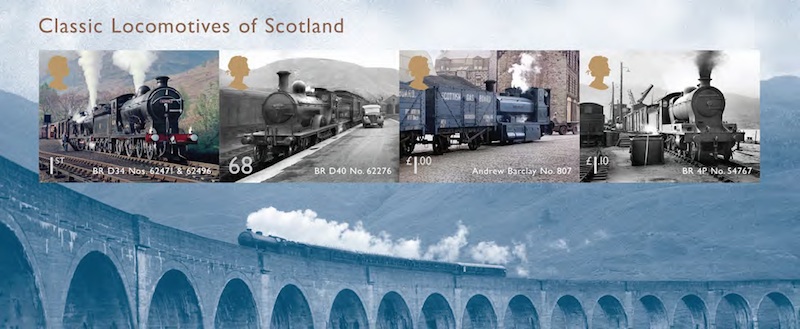
 (Above) Congratulations to Brian Delaney of Delaney Design Consultants in producing a third series of Royal Mail stamps celebrating Britain's steam locomotive heritage. The first series of stamps issued in 2010 represented the 'Big Four' railway companies prior to the formation of British Rail in 1948 whilst the second series celebrated classic steam locomotives of England. Now Royal Mail has travelled north of the border to honour Scottish steam. The four new stamps are based upon archive photographs of WP Reid's Class D34 4-4-0s Nos 62471 Glen Falloch and 62496 Glen Loy at Ardlui on the West Highland Line; BR D40 No 62276 Andrew Bain at Macduff in Aberdeenshire in 1950; the Andrew Barclay 0-4-0ST No 807 Bon Accord propelling
(Above) Congratulations to Brian Delaney of Delaney Design Consultants in producing a third series of Royal Mail stamps celebrating Britain's steam locomotive heritage. The first series of stamps issued in 2010 represented the 'Big Four' railway companies prior to the formation of British Rail in 1948 whilst the second series celebrated classic steam locomotives of England. Now Royal Mail has travelled north of the border to honour Scottish steam. The four new stamps are based upon archive photographs of WP Reid's Class D34 4-4-0s Nos 62471 Glen Falloch and 62496 Glen Loy at Ardlui on the West Highland Line; BR D40 No 62276 Andrew Bain at Macduff in Aberdeenshire in 1950; the Andrew Barclay 0-4-0ST No 807 Bon Accord propelling 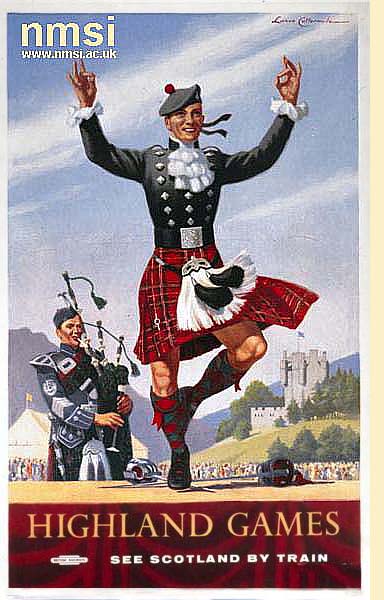 wagons along Aberdeen's Miller Street in 1960 and BR 4P No 54767 Clan Mackinnon at Kyle of Lochalsh with a fish train in 1948. The miniature sheet (above) also features a 1947 photo of a Class K2 crossing the Glenfinnan
wagons along Aberdeen's Miller Street in 1960 and BR 4P No 54767 Clan Mackinnon at Kyle of Lochalsh with a fish train in 1948. The miniature sheet (above) also features a 1947 photo of a Class K2 crossing the Glenfinnan
(Inset) The stunning images from the NMSI collection show the quality of poster art to be seen on station platforms across the country during the 1950s and 1960s. For the record, the NMSI family is comprised of four award-winning museums, each with their own diverse identity: the Science Museum, the National Media Museum and, of course, the National Railway Museum (NRM) at York which houses the world's pre-eminent railway collection. The NRM is spread across three halls: the Great Hall - formerly the steam engine shed (50A) - complete with a working turntable, while the Station Hall (previously York's central goods depot) is now laid out like a 'period' railway station. However, the NMSI's full collection is so big that only 8% of the artefacts are on public view, but enthusiasts are amply compensated by the NMSI Collections Online, which is a superb website displaying countless thousands of objects including a range of fabulous railway travel posters...a visit is highly recommended. This British Railways ScR poster - 'Highland Games' (left) by Lance Cattermole was published in 1960. The coloured lithograph depicts a Scottish dancer in a kilt performing a sword dance. Behind him is a piper, watching crowds, marquees and a castle, probably 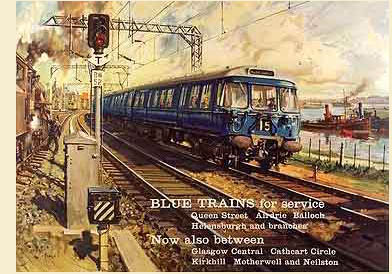 intended to represent Craigievar Castle. The accompanying text reads 'See Scotland by Train'. Signed by the artist at top right. (Below) This poster - 'Scotland for your Holidays' was painted by Terence Cuneo for British Rail (Scottish Region) depicting Class A4 60031 Golden Plover crossing the world-famous Forth Railway Bridge.This link will take you to the NMSI posters featuring the railway paintings of Terence Cuneo whose career spanned more than half a century, by which time he had established himself the No 1 spot (my personal view) among the highest echelons of twentieth century British art…he was the Master, of that there is no question...Cuneo's Tay Bridge painting and Glasgow Electric poster (right) is featured further down the page.
intended to represent Craigievar Castle. The accompanying text reads 'See Scotland by Train'. Signed by the artist at top right. (Below) This poster - 'Scotland for your Holidays' was painted by Terence Cuneo for British Rail (Scottish Region) depicting Class A4 60031 Golden Plover crossing the world-famous Forth Railway Bridge.This link will take you to the NMSI posters featuring the railway paintings of Terence Cuneo whose career spanned more than half a century, by which time he had established himself the No 1 spot (my personal view) among the highest echelons of twentieth century British art…he was the Master, of that there is no question...Cuneo's Tay Bridge painting and Glasgow Electric poster (right) is featured further down the page.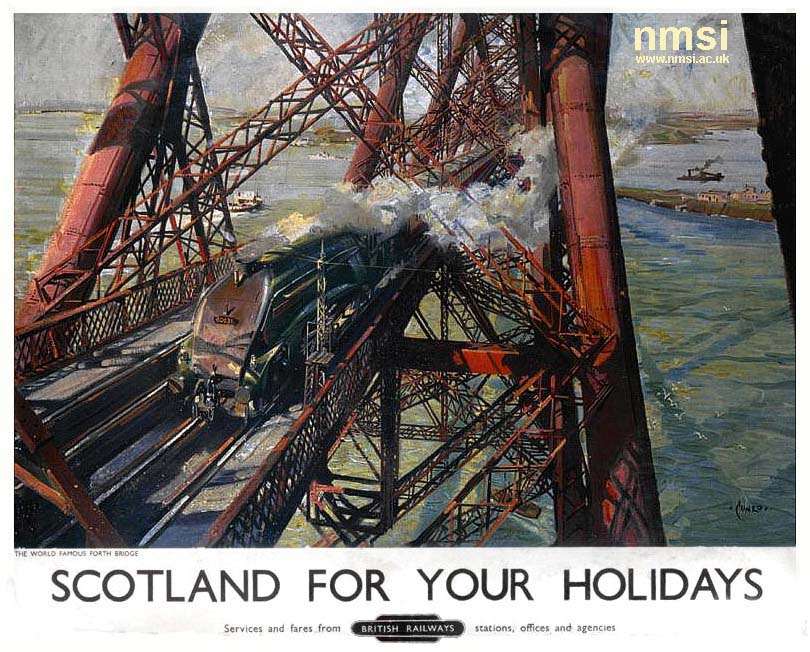
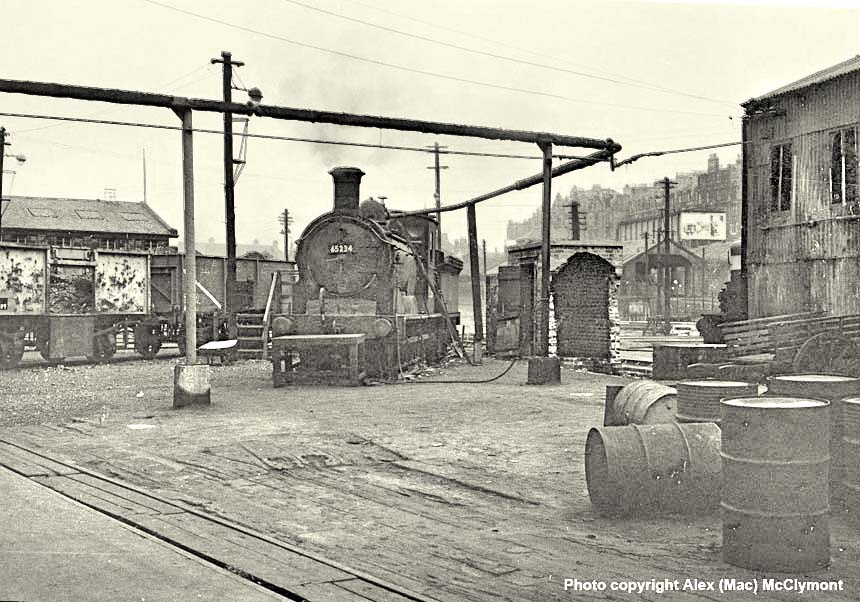
(Above) This photo of Holmes's Class J36 65234 (NBR Class C) on stationary boiler duties at St Margarets shed (64A) was taken by Glasgow-born Alex (Mac) McClymont, whose family moved south to London in  1947. After leaving school Mac joined the Southern Region, working his way through the ranks to driver based at Guildford shed. Mac took the shot in 1964 during a busman's holiday...or should that be engineman's sabbatical?
1947. After leaving school Mac joined the Southern Region, working his way through the ranks to driver based at Guildford shed. Mac took the shot in 1964 during a busman's holiday...or should that be engineman's sabbatical?
(Below) Stanier Pacific No 46239 City of Chester makes a spirited departure from Glasgow Central at the start of its journey to London Euston with the 1.15pm 'Mid-day Scot'. This powerful study by Bill Jamieson will evoke fond memories for a legion of ScR spotters who remember the days when steam still reigned supreme on the WCML's Anglo-Scottish expresses prior to the arrival of the EE Co Type 4 diesels (Class 40s). Alas Bill is unable to pin the date of this one down; the closest he can come is during the Easter holidays in 1960 when he was a regular visitor to the station; perhaps Monday 11th or Tuesday 12th April, but these dates are rather speculative…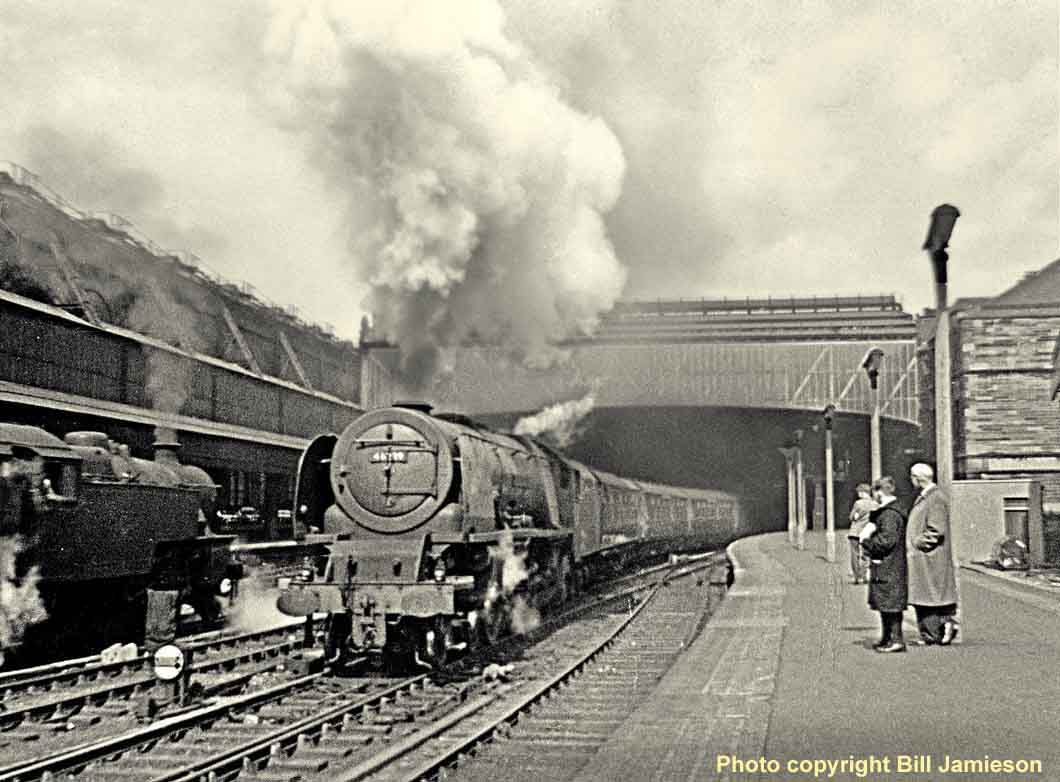
(Below) Sporting a Carlisle Canal (12C) shedplate on the smokebox door, Gresley Class J39 0-6-0 No 64895 awaits departure at Langolm station in 1961. Opened by the Border Union Railway on 18 April 1864, the seven-mile branch from Riddings Junction fell victim to the Beeching axe and the last passenger train departed Langholm for Carlisle on Saturday 13 June 1964. Although the track serving the passenger platform had been lifted, the station remained open for freight until 18th September 1967; the branch then closed the following year followed by demolition of the station buildings in 1970. Today the whole site has been cleared to make way for a residential and industrial development. Click HERE to visit the Disused Stations website. 
A BRIEF LOOK AT THE WAVERLEY ROUTE
(Below) Designed by Sir Nigel Gresley, Chief Mechanical Engineer for the Great Northern Railway (later to become CME of the LNER) the first Class A1 Pacifics Nos 1470 and 1471 were built at Doncaster in 1922. The first, No 1470, was named 'Great Northern' after its parent company and No 1471 was named 'Sir Frederick Banbury' in honour of the final Chairman of the Great Northern Railway (the GNR was absorbed by the LNER at Grouping in 1923). Between 1923 and 1925, a further 50 A1 locomotives were built; twenty by the North British Locomotive Company and the remainder by Doncaster Works. Sporting Carlisle Canal stencilled lettering on the buffer beam, No 60079 Bayardo, a North British loco (built as 2578 in 1924, rebuilt as Class A3 in May 1928) awaits departure at Edinburgh Waverley on an express for Carlisle in 1959. 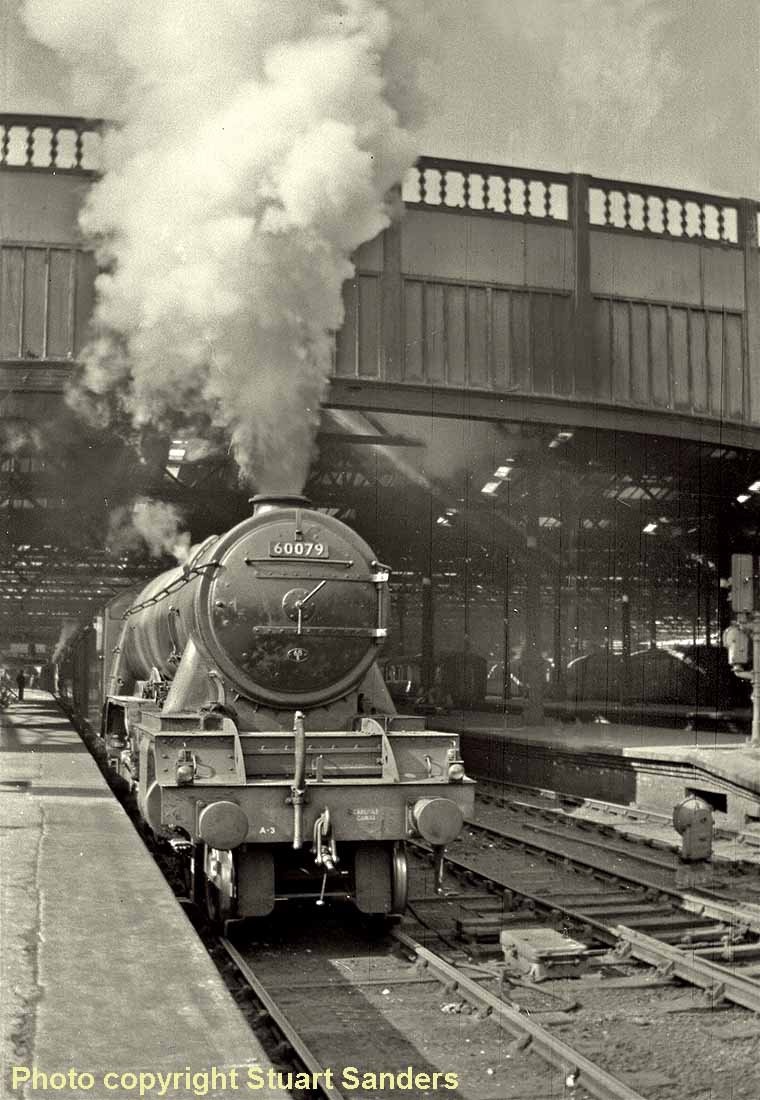

(Above-Below) The NBR's Waverley route was opened between Edinburgh and Carlisle in 1862. A little over 100 years later - what can only be described as a barbaric act of vandalism - this scenic line through the beautiful Midlothian and Scottish Border landscape fell victim to Beeching Axe; the last passenger train to traverse the route being the 21.56 Edinburgh-St Pancras sleeper headed by Class 45 D60 Lytham St Annes on Sunday 5 January 1969. During the 1950s expresses were limited-stop and covered the mileage from Carlisle to Edinburgh in roughly two-and-a-half hours. Motive power was usually in the form of a Gresley A3 Pacific locomotive, a class unsuited to hill climbing. With their large driving wheels and three cylinders they were designed for running long stretches in excess of 80 mph on heavy expresses; however most expresses on the Waverley route were typically eight coaches, and speeds were limited to 70 mph due to the tight curves involving severe speed restrictions. On the 1 in 75 climb to Whitrope Summit trains were down to 30 mph with the locomotive working flat out. These brief details were gleaned from Nick Catford's excellent 'Disused Stations' website, a comprehensive database of Britain's railway heritage with details of closed stations, each one featuring a full history, photographs, tickets, timetables and handy map references showing the location of every station. The research material will eventually be affiliated to the Subterranea Britannica web site. Click HERE to visit 'The Waverley Route and Related Branch Lines'…highly recommended. (Above) 60035 Windsor Lad heads north through Steele Road on 2nd June 1961. (Below) 60043 Brown Jack heads south at Steele Road on a stopping train for Carlisle. 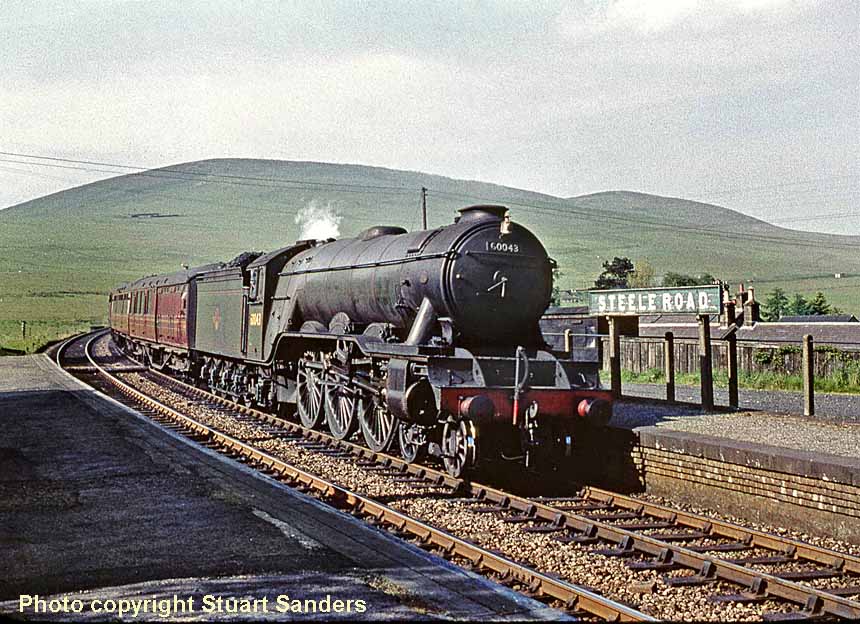
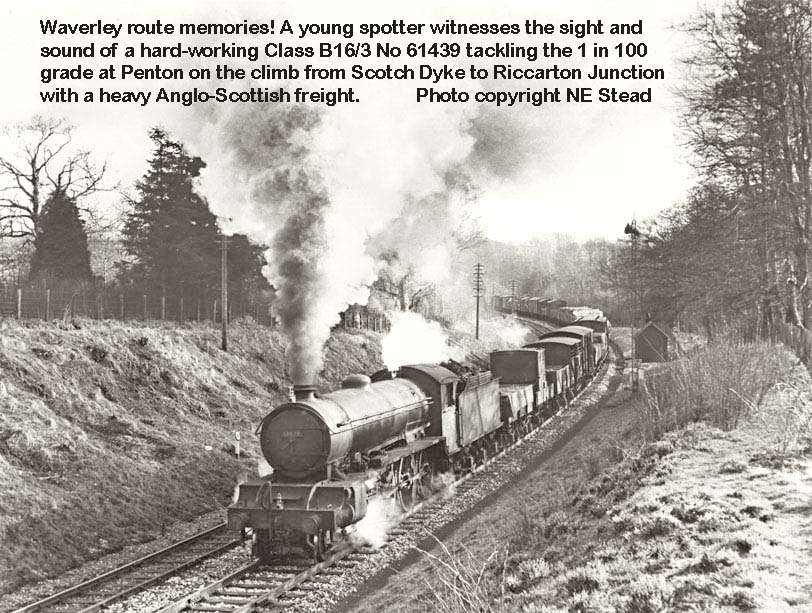
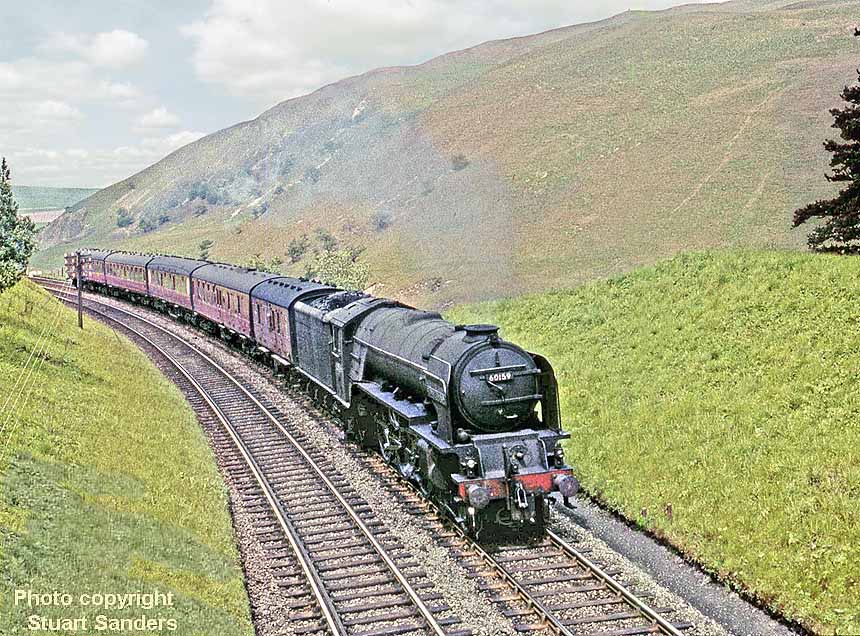
(Above-Inset-Below) Peppercorn Class A1 No 60159 Bonnie Dundee (named after the poem and song written by Sir Walter Scott) leans to the curve at Shankend with a train from Edinburgh to Carlisle. (Below) Class A1 60160 Auld Reekie (confessional time...this quaint-sounding soubriquet for the city of Edinburgh ![]() had this young spotter flummoxed back in the 1950s!) The A1 is climbing away from Hawick with a train for Carlisle. (Inset) A cast brass, measuring 58" long, from the Peppercorn A1 Class 4-6-2 No 60160 Auld Reekie went under the hammer for £12,600 at a Great Central Railwayana Auction in September 2016. Built at Doncaster, Works in December 1949, the engine took its name from the nickname for the odorous Old Town in Edinburgh. A ScR engine from new, No 60160 was allocated to Haymarket on 2 December 1949, where it spent virtually all its working life with a short spell at Polmadie and a final few months at St Margarets from where it was withdrawn on 12 December 1963 and cut up at Darlington Works. Click HERE to visit the fascinating GCRA website.
had this young spotter flummoxed back in the 1950s!) The A1 is climbing away from Hawick with a train for Carlisle. (Inset) A cast brass, measuring 58" long, from the Peppercorn A1 Class 4-6-2 No 60160 Auld Reekie went under the hammer for £12,600 at a Great Central Railwayana Auction in September 2016. Built at Doncaster, Works in December 1949, the engine took its name from the nickname for the odorous Old Town in Edinburgh. A ScR engine from new, No 60160 was allocated to Haymarket on 2 December 1949, where it spent virtually all its working life with a short spell at Polmadie and a final few months at St Margarets from where it was withdrawn on 12 December 1963 and cut up at Darlington Works. Click HERE to visit the fascinating GCRA website. 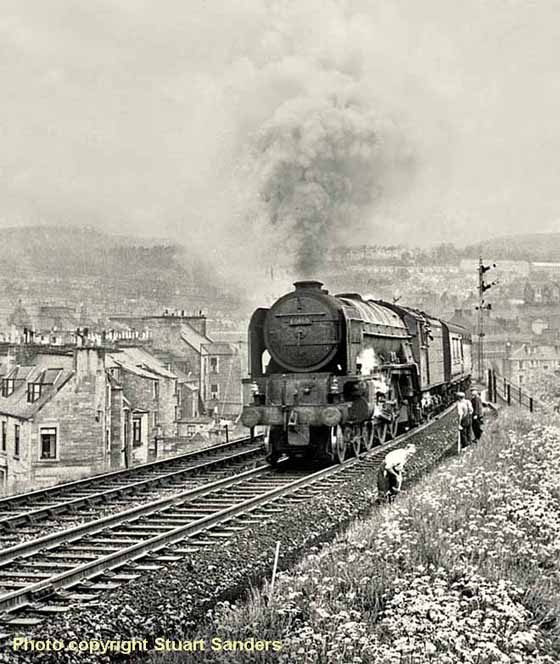
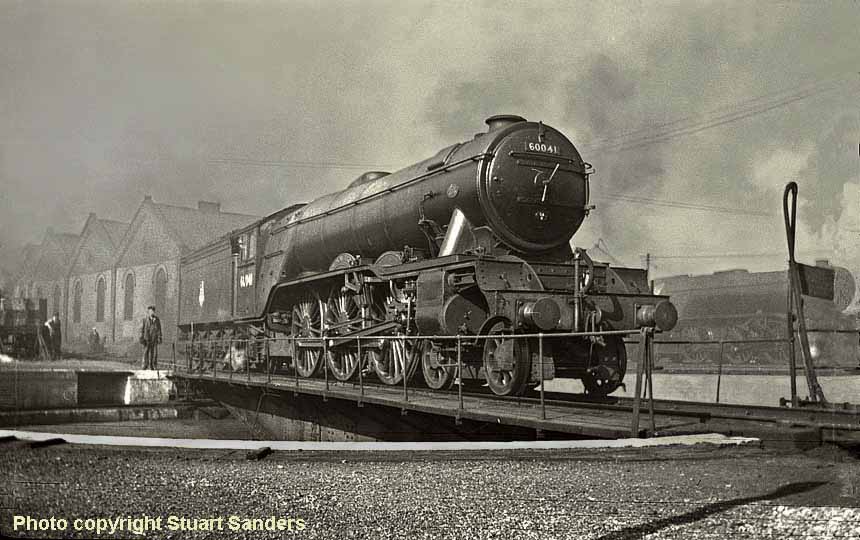
(Above-Below) Stuart Sanders took these evocative shots of Class A3s at Edinburgh Haymarket shed in 1959: No 60041 Salmon Trout poses on the turntable with a V2 in the background and (below) 60090 Grand Parade shows the classic lines of Gresley's design...more shots of Class A3s are featured on Stuart's new Rail Cameraman page HERE. 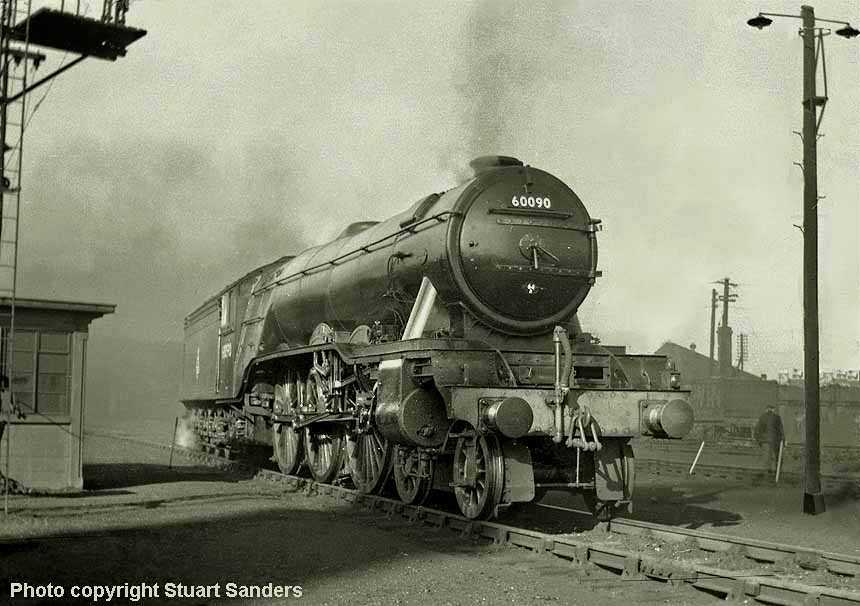
SCOTTISH REGION SHED BASH 1962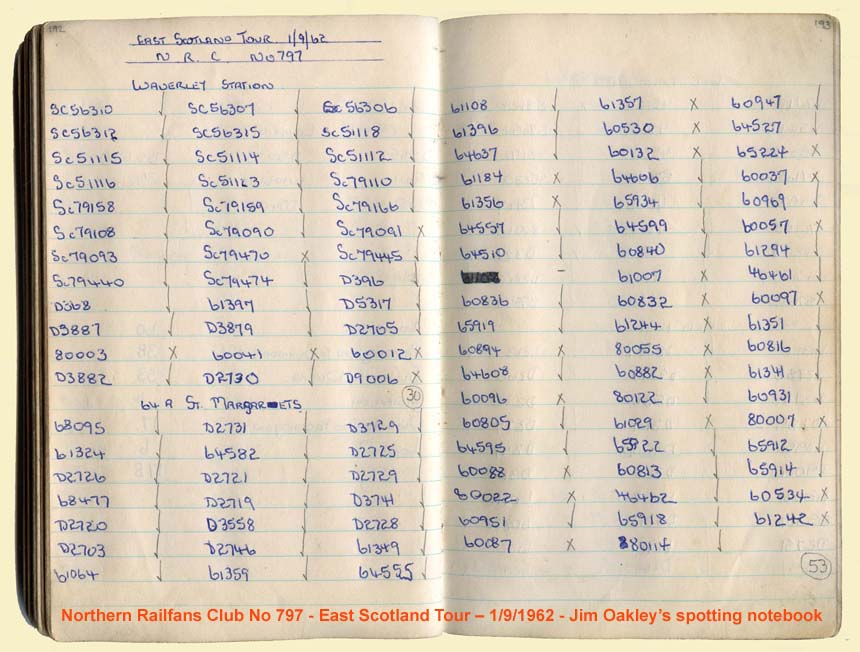
(Above-Insets-Below) By way of a change here are ten pages from Jim Oakley's spotting notebook which records a ScR shed bash in 1962. Jim was then a member of the Northern Railfans Club, and the No 797 'East Scotland Tour' took place on 1st September 1962. 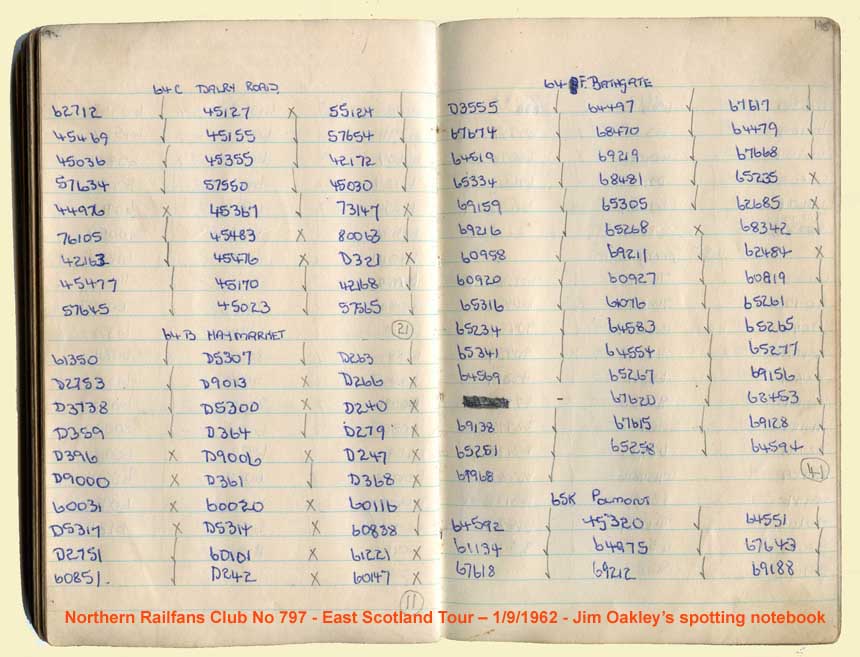 Now it has to be said I'm a tad nervous about captioning this section because my knowledge of the ScR is limited, however Jim's notebook is of great interest because the pages cover a period of BR history that we are all too familiar with; the transition from steam.
Now it has to be said I'm a tad nervous about captioning this section because my knowledge of the ScR is limited, however Jim's notebook is of great interest because the pages cover a period of BR history that we are all too familiar with; the transition from steam.
By September 1962 the onset of dieselisation was well to the fore and these pages are a virtual snapshot in time. The first page (above) begins at Waverley station where he observed unnamed Deltic No D9006, which entered traffic at Gateshead in June 1961 (D9006 wasn't named The Fife and Former Yeomanry until December 1964). At the same time he spotted Class A4 60012 Commonwealth of Australia - a ScR engine all its life, which was allocated to Haymarket in June 1936 and ended its days at Aberdeen Ferryhill in August 1964, just four months before the naming ceremony of D9006 at Leuchars in December. 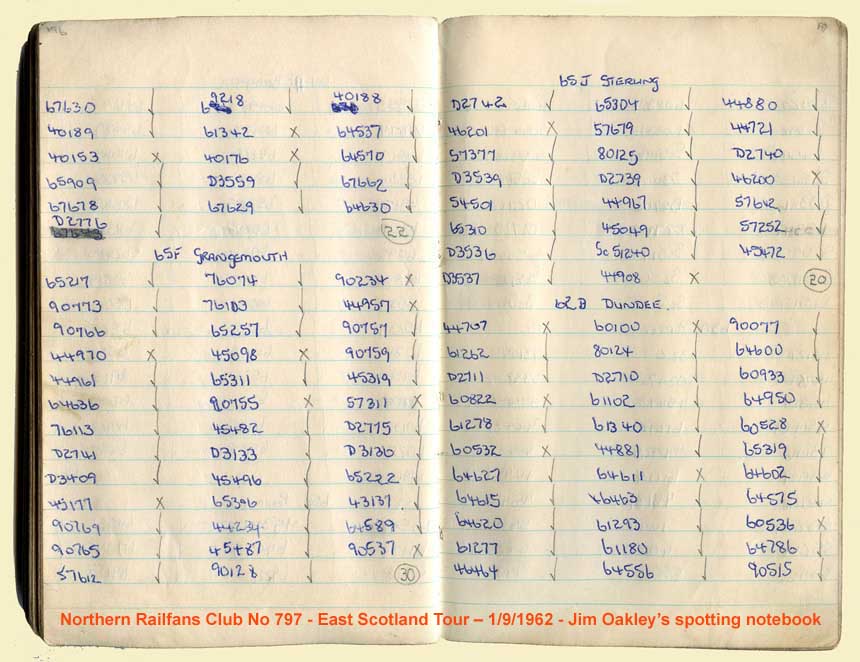 Clearly the times they were a changing; in place of the dwindling file and rank of the J83 0-6-0Ts and Y9 Saddle Tanks, Jim noted several diesel shunters, including the short-lived North British hydraulic 0-4-0s numbered D2700-D2707 and D2708-D2744 in the fleet, introduced between 1953 and 1957, and classified DY11 by the Eastern and North Eastern Regions.
Clearly the times they were a changing; in place of the dwindling file and rank of the J83 0-6-0Ts and Y9 Saddle Tanks, Jim noted several diesel shunters, including the short-lived North British hydraulic 0-4-0s numbered D2700-D2707 and D2708-D2744 in the fleet, introduced between 1953 and 1957, and classified DY11 by the Eastern and North Eastern Regions.
Indeed throughout his visit Jim noted Class A1s, A2s, A3s, A4s and numerous B1s and V2s plus countless other steam classes, whilst on the diesel front he observed several English Electric Types 4s, Birmingham RC & W Co Type 2s and North British Type 2 Bo-Bos...
The list just goes on and on. 
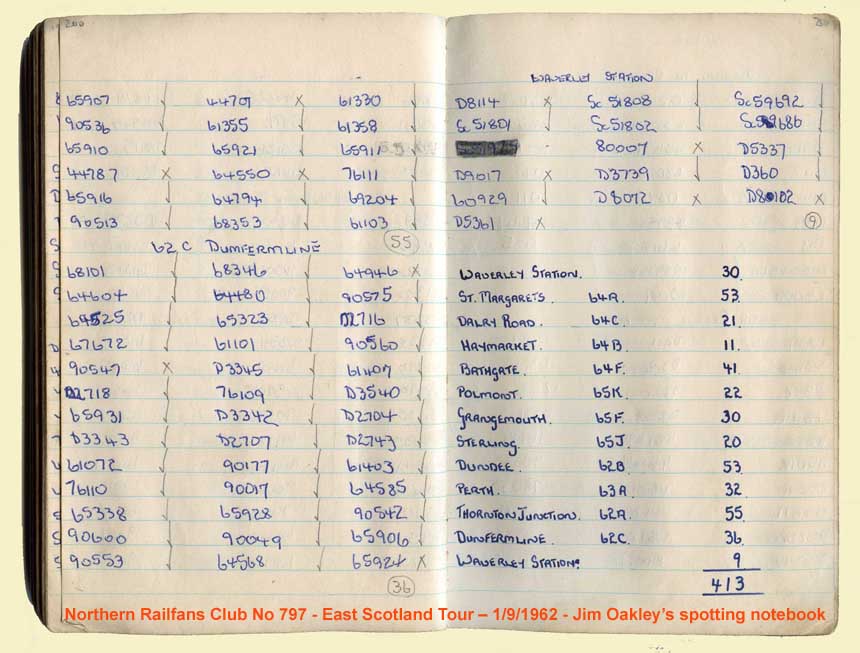
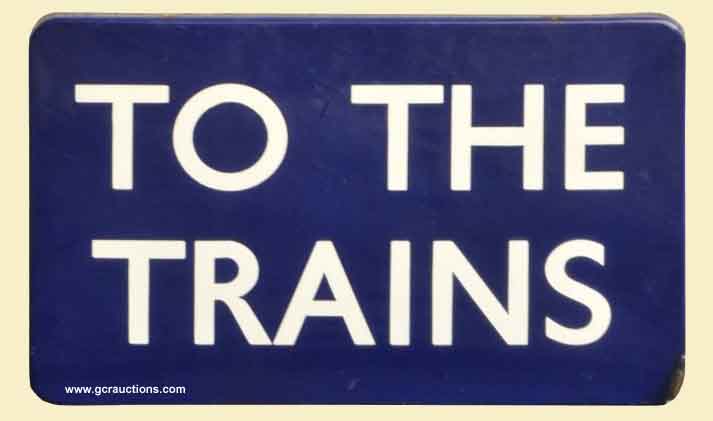
ScR TITLED TRAINS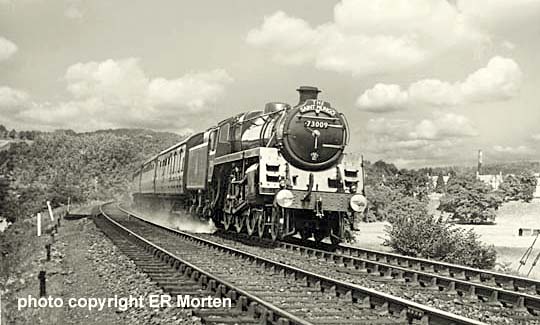
(Above-Below) When the 'Big Four' railway companies were nationalised in 1948, the newly-formed British Railways ScR revived the names of three express trains which operated solely in Scotland - 'The Granite City', 'Saint Mungo' and 'Bon Accord' - although not all were used for the same trains. In 1949, the 10.00am from Glasgow Buchanan Street and the 5.30pm return from Aberdeen once again became the 'Granite City' whereas the 6.25am from Aberdeen to Glasgow and the returning 1.35pm from Aberdeen became the 'Bon Accord', and the title 'Saint Mungo' was conferred on the 9.35am from Aberdeen and 5.00pm return from Glasgow. By the 1956 summer timetable, however, the majority of intermediate stations between Perth and Aberdeen were closed to passenger traffic, and this gave the ScR the opportunity to accelerate the entire express train service between Glasgow and both Dundee and Aberdeen on an even-interval basis. All these trains were normally loaded between seven and nine bogies limited to a maximum of 320 tons tare, including a restaurant or buffet car. The fastest train of the day was the 'Saint Mungo' which was allowed a mere 3 hours sixteen minutes between Buchanan Street and Aberdeen. Here, sporting a Perth (63A) shed plate on its smokebox door, No 73009 heads the southbound 'Saint Mungo' at Bridge of Allan between Dunblane and Stirling on 28th July 1952. (Below) For the most part the ScR's expresses were handled efficiently on the very tight point-to-point timings by the ex-LMS Class 5s; sporting a 63A Perth South shedplate 'Black 5' No 44978 was photographed at St Rollox by Stuart Sanders on 13 September 1955. 
(Inset Right) The titled train 'Granite City' began with the former Caledonian Railway in 1905, its predecessor being the Caledonian Railway's 'Grampian Corridor', a train composed of 12-wheeled corridor stock to aid the CR's competition with the North British for the traffic from Glasgow and Edinburgh to Dundee and Aberdeen. However, this particular 'Granite City' headboard, featuring a painted scroll with the train name 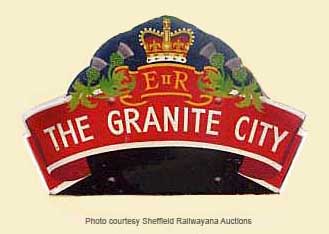 and initials EIIR, and topped by a crown and Scottish thistles, was designed to commemorate the Coronation of Queen Elizabeth ll on 2nd June 1953. The headboard was carried between Glasgow and Aberdeen for a brief few weeks and then put into store; it didn't appear again until Easter Saturday 25th March 1967 for an eye-watering 'Grand Scottish Tour' railtour for both steam and diesel haulage railfans. The 18-coach train was worked by EE Type 4 D368 and Brush Type 4 D1973, departing Edinburgh Waverley at 08.12 for the first leg to Carlisle via Portobello, Millerhill, Hardengreen Jnct, Heriot, Galashiels, St Boswells, Hawick, Riccarton Jnct, Newcastleton and Longtown. From Carlisle the railtour continued via Gretna Jnct, Lockerbie, Beattock, Carstairs, Lanark Jnct, Law Jnct, Motherwell, Mossend Yard, Coatbridge Central, Gartsherrie South Jnct, Greenhill Lower Jnct, Carmuirs West Jnct, Larbert Jnct, Stirling, Dunblane, Hilton Jnct arriving Perth at 13.12. Steam took over the next leg with 'Black 5' No 44997 and A4 No 60009 Union of South Africa continuing via Stanley, Coupar Angus, Alyth Jnct, Forfar, Bridge of Dun, Kinnaber Jnct and Stonehaven to Aberdeen, where Type 2s Nos D5070-D5127 continued the journey via Dyce, Keith, Dufftown, Craigellachie, Aberlour, Knockando, Grantown-on-Spey and Boat of Garten to Aviemore. Here another Type 2 No D5122 was added for the leg between Aviemore - Kingussie - Dalwhinnie - Blair Athol - Pitlochry - Dunkeld - Stanley back to Perth. The final leg was handled by 44997 and 60009 for the return to Edinburgh via Hilton Jnct, Dunblane, Stirling, Larbert, Falkirk Grahamston, Polmont, Winchburgh Junction and Haymarket, arriving at Edinburgh Waverley a little after 22.15 - and all for the princely sum of 50/- …. that's £2.50 in today's money!
and initials EIIR, and topped by a crown and Scottish thistles, was designed to commemorate the Coronation of Queen Elizabeth ll on 2nd June 1953. The headboard was carried between Glasgow and Aberdeen for a brief few weeks and then put into store; it didn't appear again until Easter Saturday 25th March 1967 for an eye-watering 'Grand Scottish Tour' railtour for both steam and diesel haulage railfans. The 18-coach train was worked by EE Type 4 D368 and Brush Type 4 D1973, departing Edinburgh Waverley at 08.12 for the first leg to Carlisle via Portobello, Millerhill, Hardengreen Jnct, Heriot, Galashiels, St Boswells, Hawick, Riccarton Jnct, Newcastleton and Longtown. From Carlisle the railtour continued via Gretna Jnct, Lockerbie, Beattock, Carstairs, Lanark Jnct, Law Jnct, Motherwell, Mossend Yard, Coatbridge Central, Gartsherrie South Jnct, Greenhill Lower Jnct, Carmuirs West Jnct, Larbert Jnct, Stirling, Dunblane, Hilton Jnct arriving Perth at 13.12. Steam took over the next leg with 'Black 5' No 44997 and A4 No 60009 Union of South Africa continuing via Stanley, Coupar Angus, Alyth Jnct, Forfar, Bridge of Dun, Kinnaber Jnct and Stonehaven to Aberdeen, where Type 2s Nos D5070-D5127 continued the journey via Dyce, Keith, Dufftown, Craigellachie, Aberlour, Knockando, Grantown-on-Spey and Boat of Garten to Aviemore. Here another Type 2 No D5122 was added for the leg between Aviemore - Kingussie - Dalwhinnie - Blair Athol - Pitlochry - Dunkeld - Stanley back to Perth. The final leg was handled by 44997 and 60009 for the return to Edinburgh via Hilton Jnct, Dunblane, Stirling, Larbert, Falkirk Grahamston, Polmont, Winchburgh Junction and Haymarket, arriving at Edinburgh Waverley a little after 22.15 - and all for the princely sum of 50/- …. that's £2.50 in today's money!
STEAM DAYS AT BATHGATE by Barry Hilton
Located approximately half way between Edinburgh and Glasgow, Bathgate in West Lothian was once a major railway centre in an area rich in Coal and Shale Oil reserves. Geologically, these reserves developed from the Lower Carboniferous period about 250 million years ago and are known as the 'Coal Measures'. Although coal had been extensively mined for many years, by the time the following photographs were taken in April 1964, the industry was in rapid decline. In 1962 the Government had ceased to support the Scottish Shale Oil Industry and similarly Coal Mines and their rail links where closing all the time.
In 1961, Bathgate had been designated a 'Special Development Area' and the new British Motor Corporation (BMC) Truck and Tractor Division Factory which had been planned for the Midlands was relocated to Bathgate, offering new jobs for the area. This did little to off-set the large unemployment problem caused by the mining closures and it eventually closed in 1986.
The majority of the following photos were taken in the Bathgate area during a memorable week with friends in April 1964 photographing some of the last surviving steam classes still gainfully employed in Scotland. This included the few remaining A4s working the Glasgow to Aberdeen trains which will be shown as a separate feature on this page in due course. A year later, and we were back in Scotland chasing A4s again, by which time there were only four left in service, Nos 60007/9/19/34. On our return south we visited the Bathgate area on the 7th July 1965, the prime objective being to capture on film the few remaining J36 coal train workings.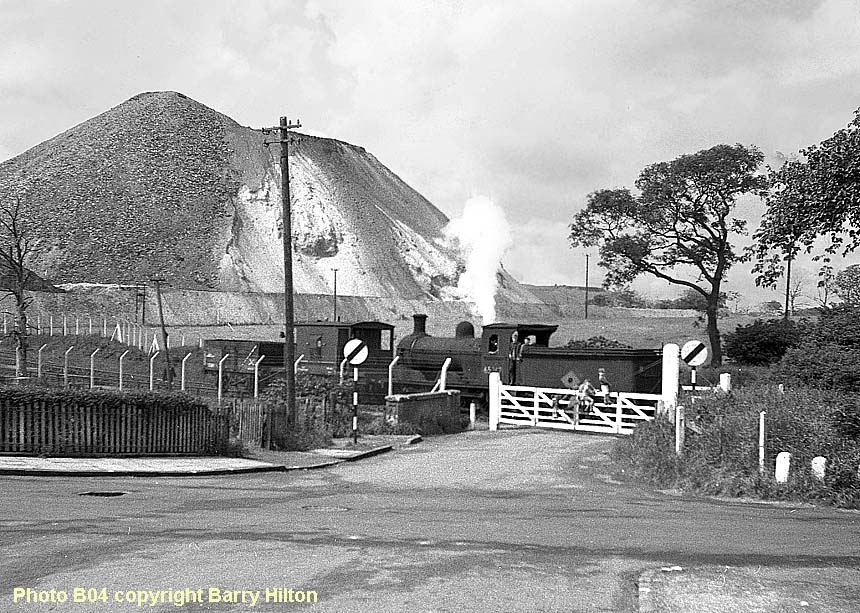
(Above-Below) These shots show the typical landscape of the time, particularly in the first shot (above) portraying a rather idyllic rural picture with the engine driver talking to the two kids on the crossing gate, whilst shunting wagons; yet there's an obvious presence of the coal workings from the large earthen mound behind the train. In the second shot (below) 65267 has now detached and taking a break between duties. The J36 belongs to a class of 0-6-0 tender locomotives introduced in 1888 by Matthew Holmes, then Locomotive Superintendent of the North British Railway 1882-1903. Designated C class by the NBR, in all 168 locos were built between 1888 and 1900 which were later rebuilt between 1913 and 1923 (with slightly larger boiler and new side window cab) and classed J36 by the LNER after Grouping in 1923. A British design, built by Sharpe Stewart at the Cowlairs Works, Glasgow, they were actually the last class of steam engine working in Scotland prior to withdrawal in 1967.
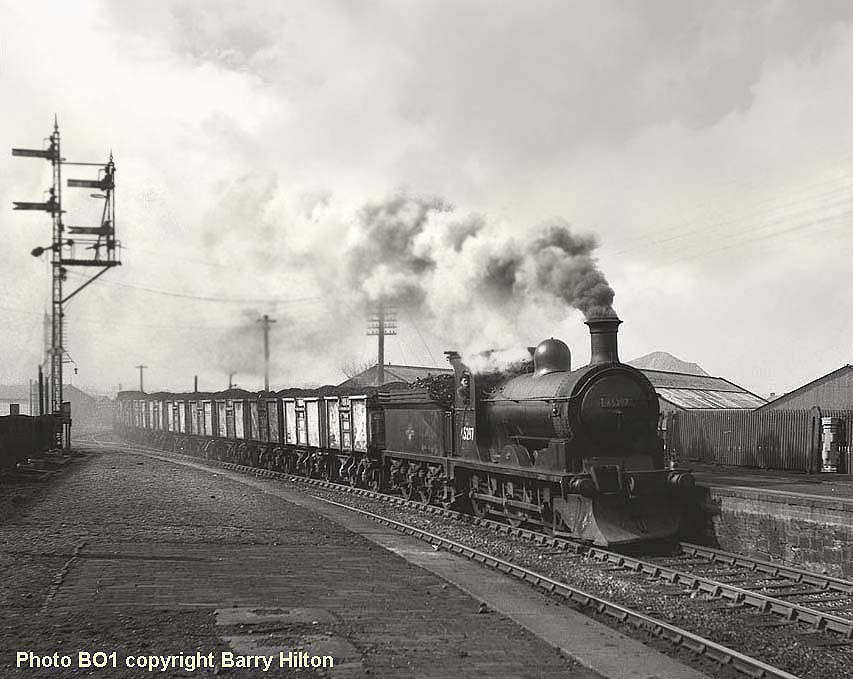
(Above-Below) Ex-NBR Holmes 0-6-0 J36 No 65297 slows through Bathgate (Upper) station hauling a fully laden train of coal possibly from the nearby Easton Hopetown Colliery to the north. It then waits for the 'right away' to proceed. Note the condition of the locomotive even at this late stage of the Colliery workings. It's a fitting tribute to the railway staff. Note also the fitted snowplough. The J36s were regularly used for snow-plough duties and a number were fitted with small ploughs but large ploughs were used during the severest weather to clear deepest snow drifts. They probably also gave extra weight for adhesion on some of the heavy coal trains.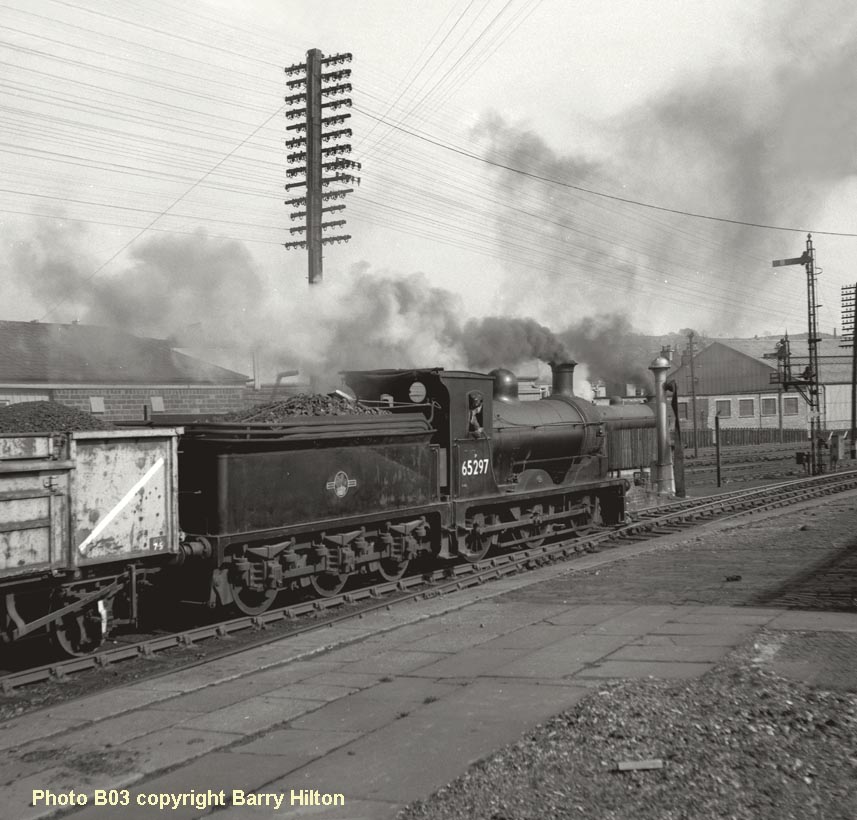
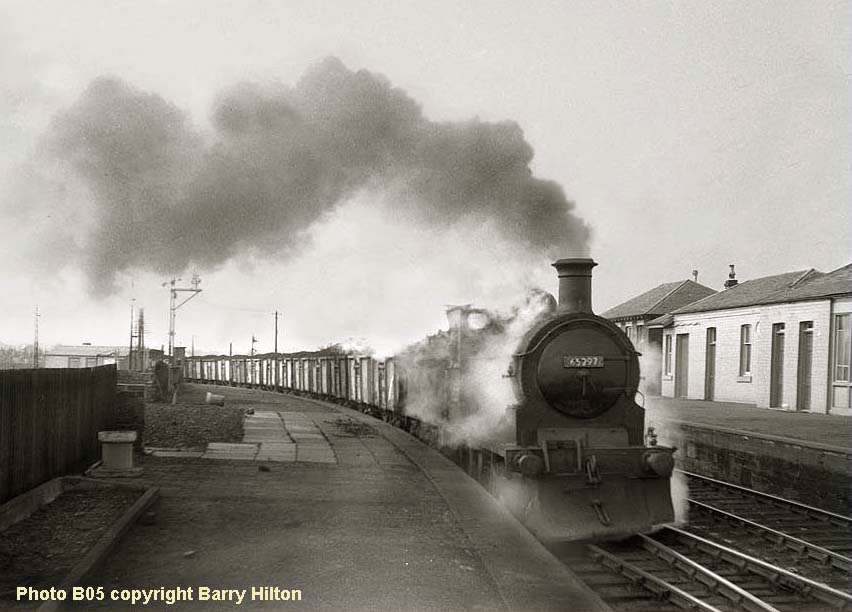
(Above-Below) Following the closure of Bathgate Upper station in 1956, along with the closures of many local mines and the decline of heavy industry, not forgetting the Beeching cuts, the area has benefitted from a certain revival in recent years. In 1986 the Bathgate to Edinburgh line was reopened along with a new station to serve Bathgate and Livingston New Town, the latter having developed a growing Electronics Industry. Also in 2011 the completion of the new Aidrie-Bathgate link line, along with improved services from Edinburgh via Glasgow to Helensburgh and the opening of new stations at Armadale and Blackridge, has seen a wonderful resurgence in the rail services serving West Lothian. Here, Class J36 65297 appears to be running 'wrong line' through the abandoned platforms at Bathgate Upper. This is probably because 'block working' was in use at the time. On double-tracked railway lines, it allowed trains to travel in the same direction as though it were two single tracks, but it was necessary to space trains on the same track far enough apart to ensure that they did not collide. The Tyer's Single Line Block as it was known, had been used in this area until the 1960s. This train could be delivering coal from the Riddochhill Colliery to the south of Bathgate. (Below) 65346 on another loaded coal train pauses just beyond the station. The tall church tower in the background denotes the centre of the town.
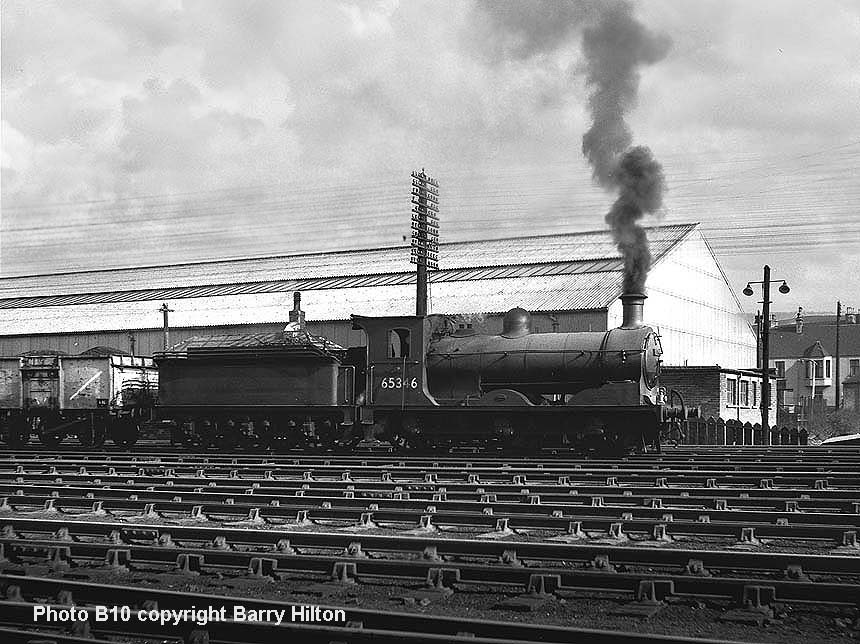
(Above-Below) The second shot of 65346 was taken across the running tracks; Bathgate MPD (64F) is on the North side to the right of the picture. Today only one J36, 673 Maude (LNER number 9673; LNER 1946 number 5243; BR number 65243) has survived; the loco was preserved by the Scottish Railway Preservation Society at the Bo'ness and Kinneil Railway. (Below) Adding to the loco variety at Bathgate is the more powerful superheated J37 64614 seen here crossing the running tracks before reversing back onto its train of loaded wagons. 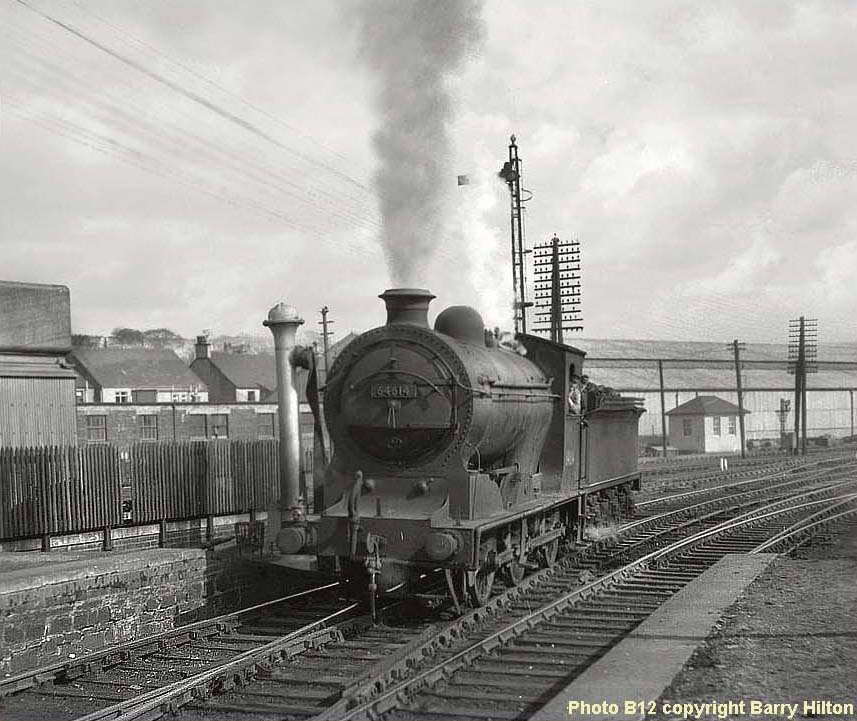
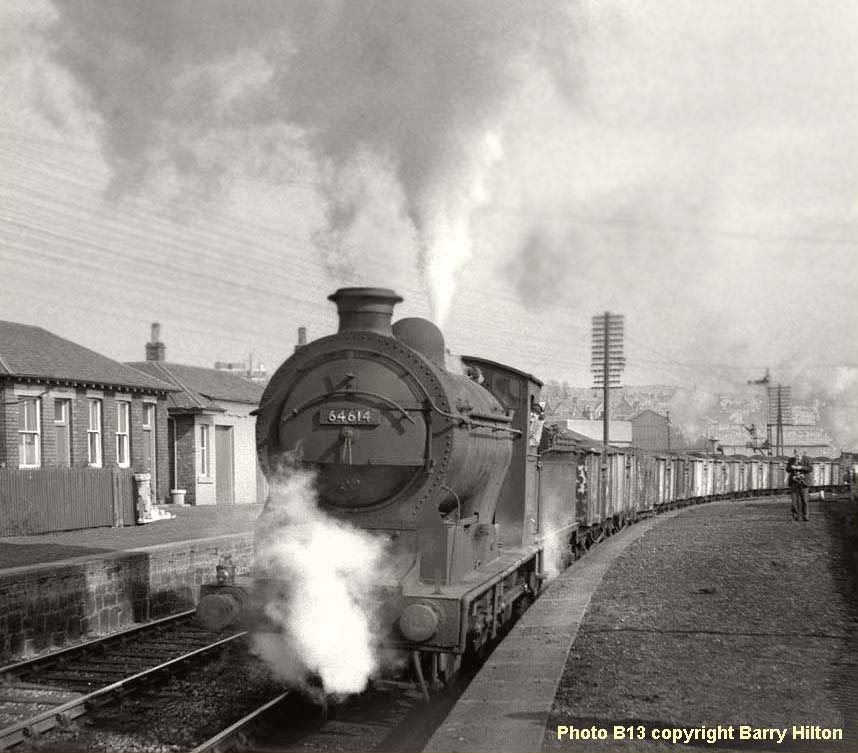
(Above-Below) Minutes later the J37 is captured makes a spirited departure with the train south. On this particular 'Scottish Trip' a group of us travelled in a Mini Cooper which had a carburettor problem; the needle valve was occasionally sticking and starving the engine of fuel. So, before leaving Bathgate and heading North it was decided to call at the BMC Scotland (Glasgow) to see if a new part could be obtained. After enquiring at the main desk, the lady could only say - 'We old make Tractors here, Laddie!' However BMC did arrange for us to collect the part from a garage in Glasgow the next day. (Below) Staying with the J36s, during a visit to Dunfermline MPD (62C) on 2nd April 1964, I took this shot of 65288 there in steam. The other engines on shed that day were: Class B1 61072, Class J37 Nos 64573/99 and 64625, Class J38 Nos 65926/33/4, BR Standard Class 4 Nos 76109/110, WD class Nos 90071/386/534/547, and a solitary diesel shunter D2716.
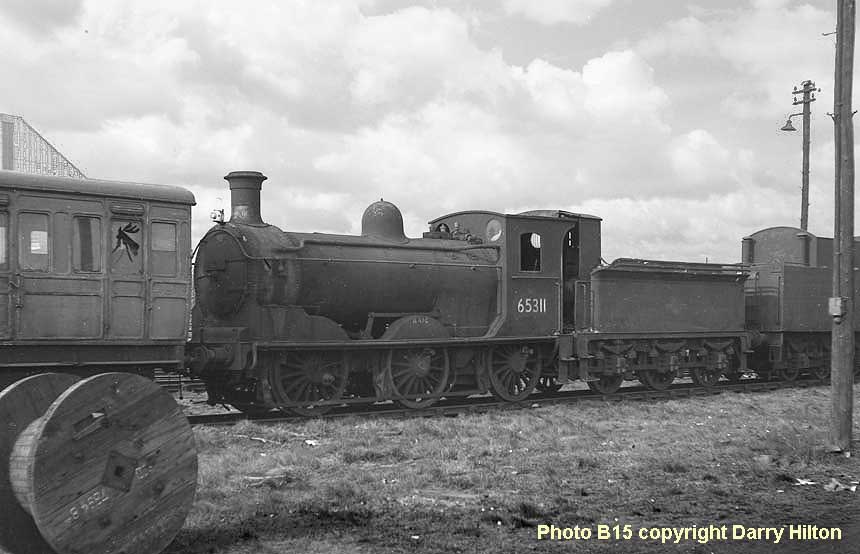
(Above-Below) Two other J36 were photographed during our ScR bash, both engines ostensibly withdrawn from traffic with their rods removed, but I include them here to show some detail differences of the class, specifically the partial and complete tender cabs. The latter is fitted to 65311 (above at Grangemouth) which has the name 'Haig' painted on the middle splasher. Interestingly, twenty five J36s were loaned to the Railway Operating Department (ROD) to aid the war effort in France in 1917. All J36s returned to the NBR two years later, and in recognition of their service overseas the NBR named a number of the class after battlefields and commanders of World War 1. However, it should be noted that 65311 did not actually serve in the conflict overseas. This honour goes to 65226, built in April 1891 and scrapped in April 1951. No 65311 was given the unofficial name of 'Haig' in 1955, thus continuing the NBR's tribute to Field Marshal Douglas Haig, who, as Britain's commander-in-chief during the Battle of the Somme, was severely criticised for his clumsy tactics during the advance of infantry troops on enemy lines which resulted in the loss of 600,000 men. (Below) No 65323 is coupled to a partial-fitted tender at Thornton Junction. 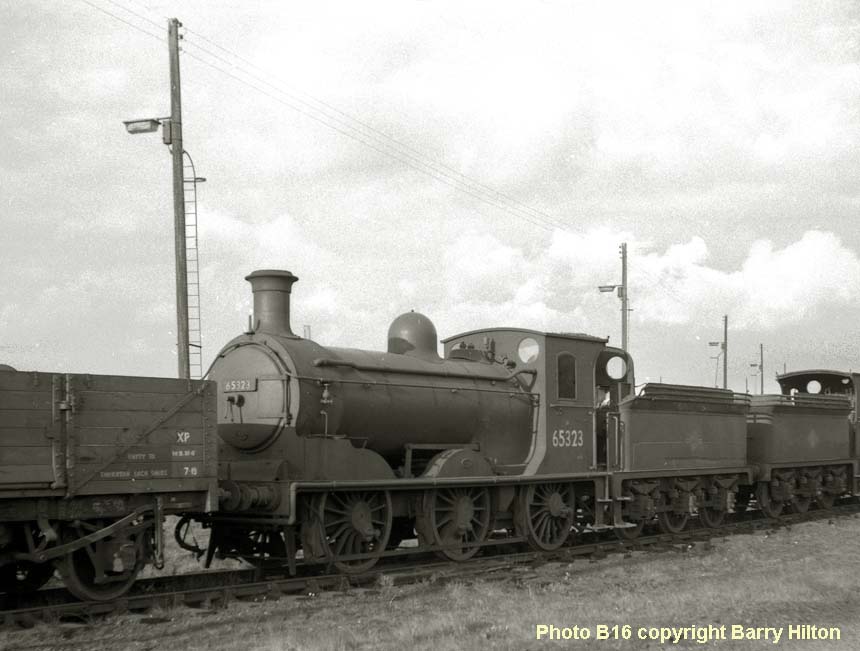
AROUND THE REGION - 1

(Above-Inset) Sir Nigel Gresley was not over enamoured with double-heading. During his spell as CME of the Great Northern Railway (1911-1922) he was greatly influenced by the Doncaster tradition of 'one engine...one train', which remained with him throughout his days in the LNER's CME chair (1923-1941). When he came to tackling the haulage problem on the East Coast route north of Edinburgh, where even the Pacifics struggled to take the heaviest trains, he set about the design of one the most powerful class of locomotives ever to run in Britain - the Class P2 2-8-2s - of which six were built specifically for the service  between Edinburgh and Aberdeen. The first two engines Nos 2001-2002 had an arrangement of smoke deflectors at the front end, whereas the later ones Nos 2003-2006 had the streamlined fronts as proved so successful on the Class A4 Pacifics. (Above) No 2001 Cock o' the North was photographed by Bryce Greenfield at Dundee Shed on 16th August 1936. Click here to visit WB Greenfield's superb photo collection on the North Eastern Locomotive Preservation Group (NELPG) website. Further enquiries and details of WB (Bryce) Greenfield's full catalogue of negatives can be found via this link. (Inset) Class P2 2-8-2 No 2003 Lord President shows the A4-style streamlining applied to the last four members of the class at Dundee Shed.
between Edinburgh and Aberdeen. The first two engines Nos 2001-2002 had an arrangement of smoke deflectors at the front end, whereas the later ones Nos 2003-2006 had the streamlined fronts as proved so successful on the Class A4 Pacifics. (Above) No 2001 Cock o' the North was photographed by Bryce Greenfield at Dundee Shed on 16th August 1936. Click here to visit WB Greenfield's superb photo collection on the North Eastern Locomotive Preservation Group (NELPG) website. Further enquiries and details of WB (Bryce) Greenfield's full catalogue of negatives can be found via this link. (Inset) Class P2 2-8-2 No 2003 Lord President shows the A4-style streamlining applied to the last four members of the class at Dundee Shed. (Inset Left) I have recently been emailed by Mike Hobdell, a member of the Doncaster P2 Locomotive Trust, who are seeking pictures of LNER 2001 Cock O' The North in its post-1938 streamliner form. Can anyone help? The praiseworthy aim of the Trust is to recreate one of the great missing legends of the steam railway age, the magnificent and iconic Cock O' The North. The Trust needs your help, support and commitment to take this fantastic project to the next level. For the latest news, visit the Trust's News page HERE. Meanwhile if anyone has photos of the streamlined 'Cock O' The North' which the Trust can use for publicity purposes, please contact Mike Hobdell at zen231005@zen.co.uk Please note - this is not a 'clickable' mail-to link via Outlook Express; you will have to mail manually..
(Inset Left) I have recently been emailed by Mike Hobdell, a member of the Doncaster P2 Locomotive Trust, who are seeking pictures of LNER 2001 Cock O' The North in its post-1938 streamliner form. Can anyone help? The praiseworthy aim of the Trust is to recreate one of the great missing legends of the steam railway age, the magnificent and iconic Cock O' The North. The Trust needs your help, support and commitment to take this fantastic project to the next level. For the latest news, visit the Trust's News page HERE. Meanwhile if anyone has photos of the streamlined 'Cock O' The North' which the Trust can use for publicity purposes, please contact Mike Hobdell at zen231005@zen.co.uk Please note - this is not a 'clickable' mail-to link via Outlook Express; you will have to mail manually..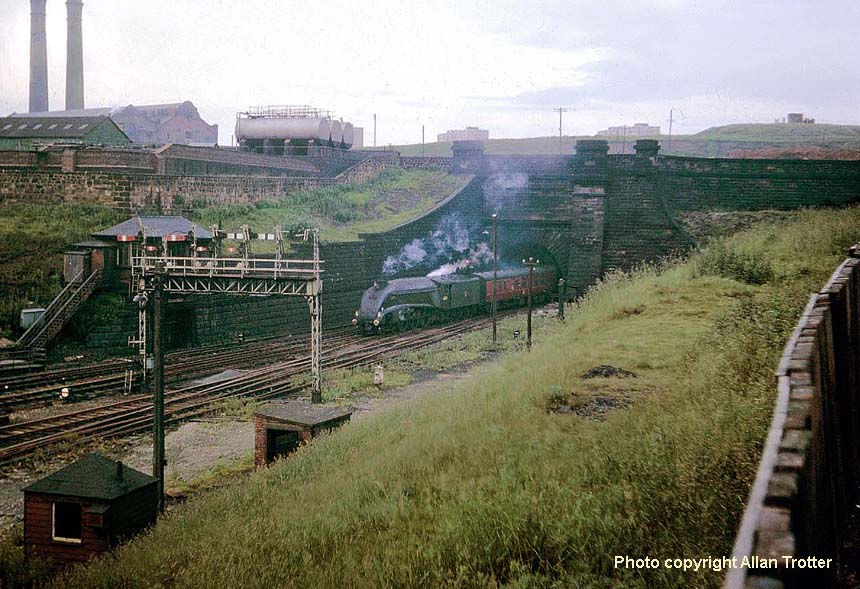
(Above-Below) The Gresley Class A4 is widely regarded as the ultimate development of Pacific technology at Doncaster, and as befits such a distinguished class, no less than eight members have survived into preservation, including No 60019 Bittern seen here approaching Glasgow Buchanan Station with a train from Aberdeen in May 1966. See further colour shots in Allan Trotter's 'Scottish Region Photo Album' featured further down the page...(Below) The ScR-based A4s are also featured on Trevor Ermel's excellent 'Rail Cameraman' page 69. During 1965 monthly reports were appearing in the railway press of the exploits of the A4s between Glasgow and Aberdeen, which prompted Trevor to head north of the border from Gateshead to photograph them. Six went that year and he missed five, leaving a final six at the start of 1966. By 3rd September 1966, only two remained in service, No 60019 Bittern and No 60024 Kingfisher. On Wednesday 31st August, Trevor photographed 60019 entering Buchanan Street Station, then living on borrowed time - the station closed later that year.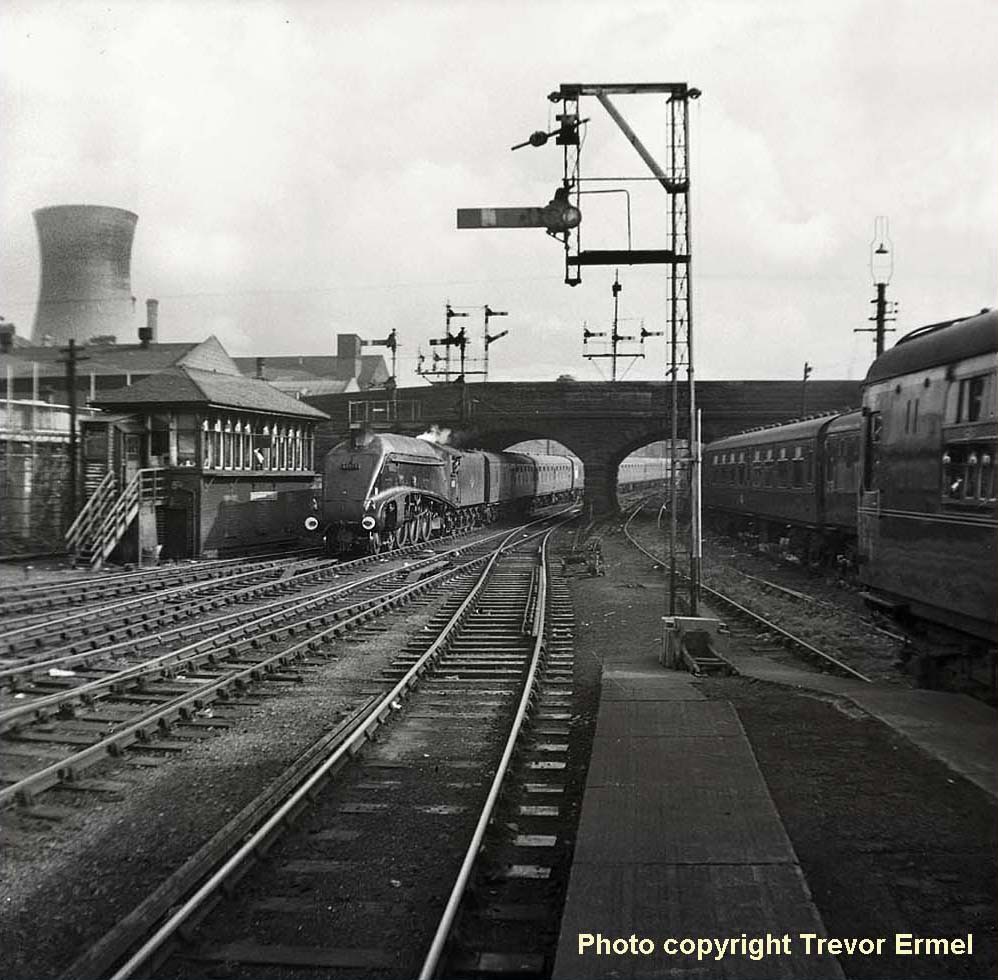


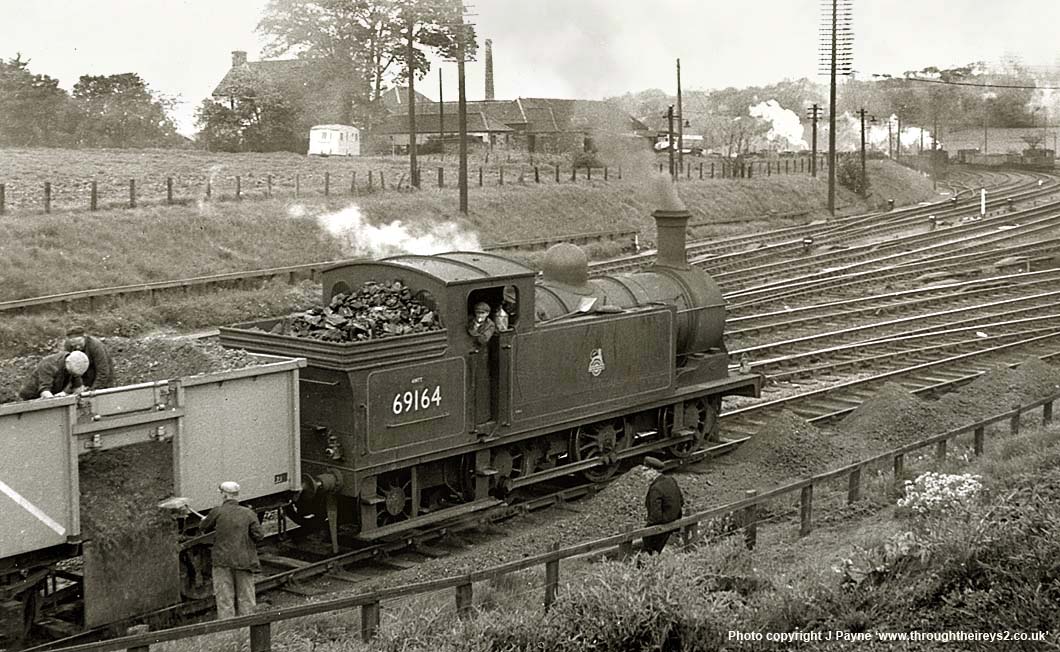
(Above-Below) I've lost count of the number of old railway photographs which get sidelined, not because they are not worth posting on the page, but because there is so little information on them. Perhaps someone can identify the location of this shot of Reid's NBR Class N15/1 0-6-2T No 61964 on a ballast train? All I have to go on is that it was taken in 1957 and is presumably somewhere on the old North British Railway system. (Below) This shot of Class V2 No 60851 was taken at the same time...not much help, I know, but if anyone can identify the location it will be very much appreciated.
Mystery solved! Michael Laing writes: I suspect others may have pointed this out already. The unidentified location is Inverkeithing Central Junction, Fife. The class N15 is standing in the headshunt of the up loop on the main line from Kirkcaldy, while the V2 is coming off the line from Dunfermline, heading 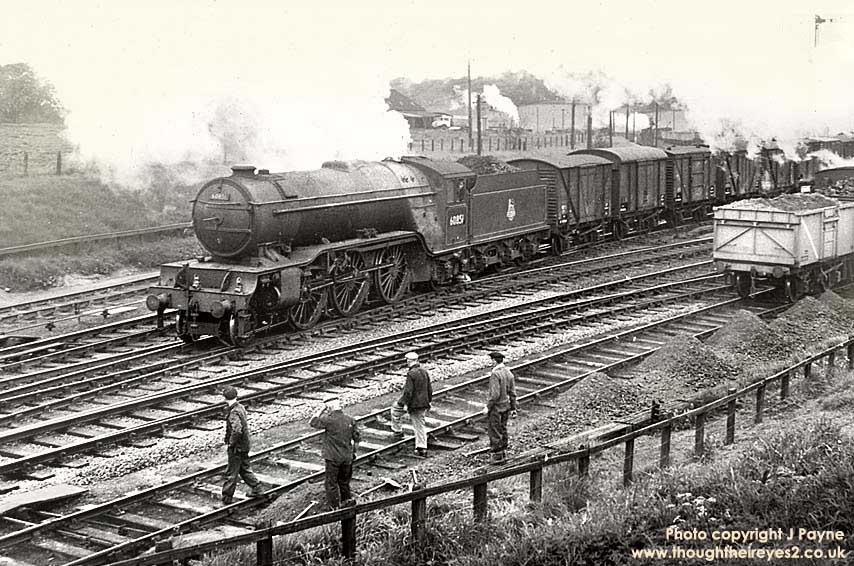

 (Above-Below) I am always grateful for help with captions, and in particular my thanks to Vic Smith of York for not only identifying the location of the two 0-6-0Ts above, but for correcting one or two errors. Vic writes - 'Hello David, I came across the following information whilst researching the NRM archives to find the correct location of the photo. An identical photograph appears in 'The Lauder Light Railway' book by Andrew Hajducki. It gives the location and date as Galashiels shed in July 1950. The photo is attributed to A.G. Ellis/Stevenson Collection.
(Above-Below) I am always grateful for help with captions, and in particular my thanks to Vic Smith of York for not only identifying the location of the two 0-6-0Ts above, but for correcting one or two errors. Vic writes - 'Hello David, I came across the following information whilst researching the NRM archives to find the correct location of the photo. An identical photograph appears in 'The Lauder Light Railway' book by Andrew Hajducki. It gives the location and date as Galashiels shed in July 1950. The photo is attributed to A.G. Ellis/Stevenson Collection.
Also a correction should be made to the loco number in the photo below, which should read 68511 - not 65811.
Now for the really serious technical stuff! Having consulted Yeadons Register, I've found out that Diagram 39 boilers were numbered from 2800 to 2919. No 68492 was fitted with boiler No 2901 in 1943 and became Class J67 with 1000 gallon tank, whilst No 68511 was fitted with boiler No 2837 in 1943 and became Class J67 with 1180 gallon tank.
Following BR's reclassification in March 1950, four sub-classes were formed as follows: (1) J69/1 Diagram 37 boiler, large tank; (2) J69/2 Diagram 37 boiler, small tank; (3) J67/1 Diagram 39 boiler, small tank and (4) J67/2 Diagram 39 boiler, large tank. Therefore the locos at Galashiels (above) were designated as follows:  No 68492 was a Class J67/1 (not J69/1 as stated) and No 68511 was a Class J67/2 (not J69/2).
No 68492 was a Class J67/1 (not J69/1 as stated) and No 68511 was a Class J67/2 (not J69/2).
Yeadon also comments that both LNER and BR records incorrectly recorded 68492 as a J67/1. I expect you will be even more confused now! Regards, Vic…'
(Below) Bill Jamieson points out errors in the captions embedded in the following two shots. First the location of the ER Morten shot of 68511 on the Lauder goods should be 'near Oxton' (not Oxon) and in the photo immediately below it the home shed of No 40906 is of course Corkerhill, not Cockerhill. Incidentally, 60 years ago I would have been able to watch the Lauder goods heading north out of Stow towards Fountainhall from my lounge window. From a rail user's point of view it's great to see 158s and 170s now, even if they do nothing for the railway enthusiast in me!
Thanks to both Vic and Bill for the amendments… 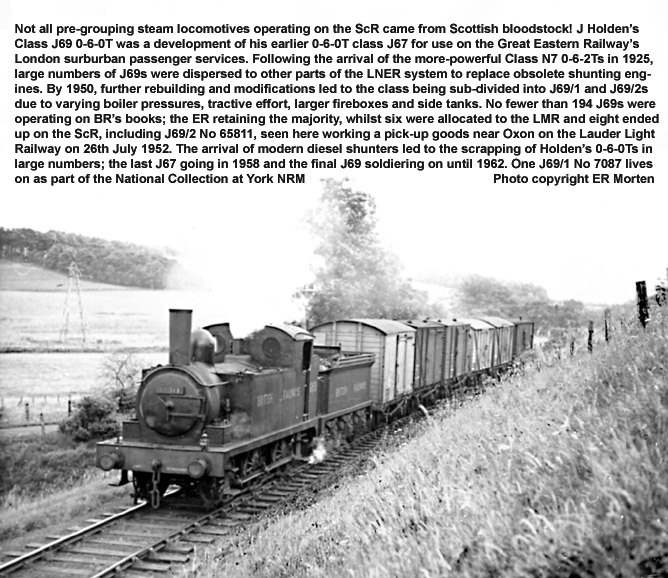
(Above) Situated in delightful Scottish scenery between the villages of Arrochar at the head of Loch Long and Tarbet on the shores of Loch Lomond, the West Highland Line station was opened to passengers on 7th August 1894 by the West Highland Railway. The station came under the auspices of the North British Railway then later part of the London and North Eastern Railway during the Grouping of 1923. The station then passed on to the ScR on nationalisation in 1948. Here, WP Reid's North British standard passenger tank engine - push-pull fitted 2P Class C15 4-4-2T No 67474 - awaits departure with a train for Glasgow in 1957. Correction...Vic Smith drops a line; he writes - 'I have been browsing through the photos again and would like to add a correction to the above image…the two coaches and tail lamp would suggest that this is the Arrochar to Craigendoran push-pull service, which was a regular duty for 67474 and 67460 between 1956 &  1960...'
1960...'
(Inset) Another stunning poster from the NMSI; a collaboration between the London and North Eastern Railway and London Midland and Scottish Railway led to this poster - 'Loch Lomond' - painted by J MacIntosh Patrick, depicting a view of the Loch and surrounding countryside.
(Below) Another shot of Arrochar station, this time in the opposite direction, showing Reid's superheated 5F Class J37 0-6-0 No 64580 (introduced in 1914) awaiting Class K1 No 62038 in the distance.


(Above-Below) Seeking to identify the location of Black 5 No 44968 I contacted Ian McKellar, who writes - 'The island platform has a Swiss chalet-style building, which together with the backdrop of mountains tells me that this is the West Highland line. The sidings and coach in the background draw me to either Ardlui, Arrochar or Crianlarich Upper. However the station at Crianlarich is more extensive and the mountains are too close for Bridge of Orchy, while Rannoch and Corrour are far too bleak, therefore I suggest Ardlui station. The Black 5 is heading a train for Glasgow. The topography looks right.' (Below) Another collaboration between the LNER and LMSR's campaign 'Scotland for Holidays' led to this stunning poster by W Smithson Broadhead, depicting a red deer stag being stalked in the mountainous highland landscape. The text reads - 'Deer-stalking in the Highlands by W. Smithson Broadhead. Its's quicker by rail. Travel information from any LMS or LNER Station or agency.' Just discernible above the ridge on the right are two men taking aim to shoot - a great picture, but the subject matter leaves me stone cold. Who would have the heart to kill such a beautiful animal?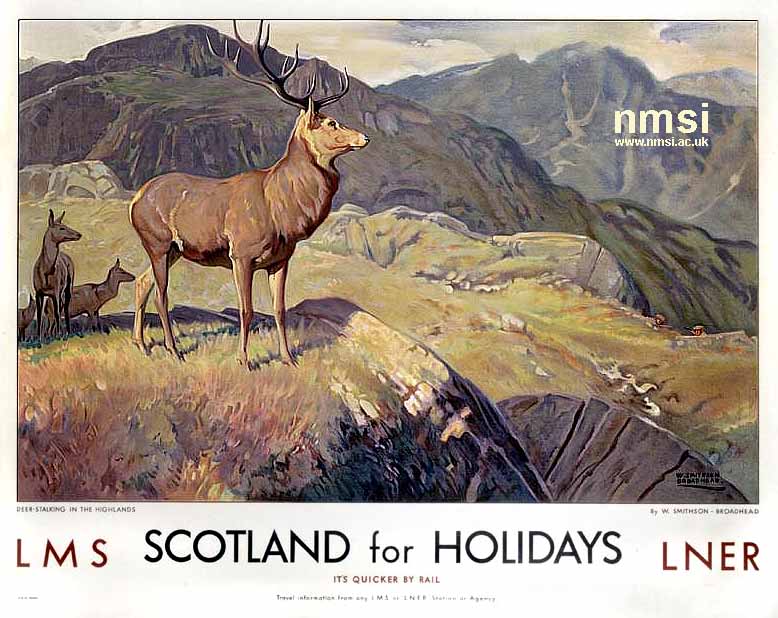
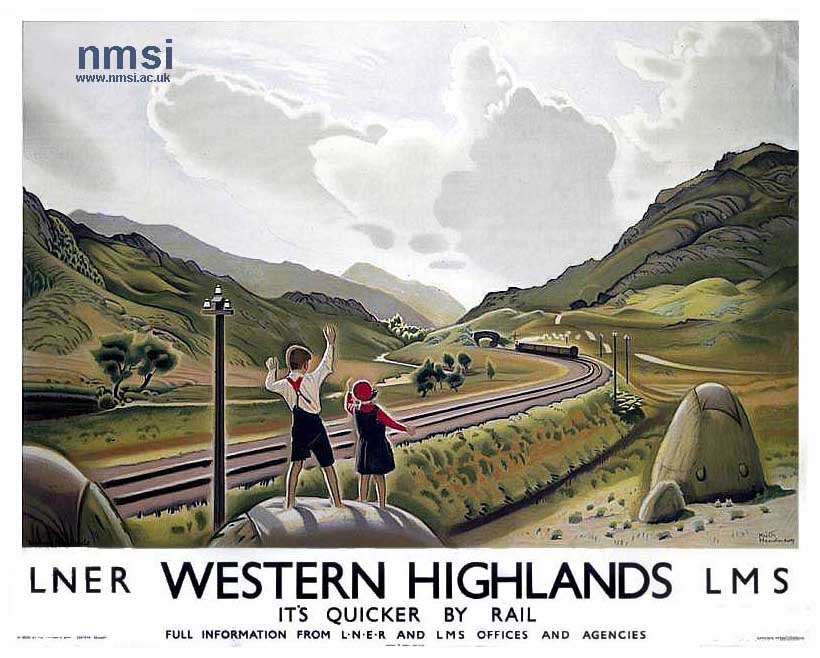
(Above-Inset) Visiting the fabulous NMSI Collection online makes a refreshing change from so many other websites...a visit is highly recommended. It's huge! Click HERE to view the NRM's collection of railway posters. There is  something comforting and satisfying in scrolling through the poster images; it feels like you're floating in some sort of cultural bubble, exploring a bygone age in glorious colour! Let's not forget that the London North Eastern Railway and London Midland Scottish Railway were formed during Grouping in 1923 and colour photography was still in its infancy, therefore much of our railway history was recorded in black & white; at least the NMSI collection shows something of what has gone before in colour, albeit through artists' eyes. I just love this painting! The LNER and LMRS poster - 'Western Highlands' was painted by Keith Henderson in 1938. It shows a boy and girl standing on a stack of hay waving to a train heading away to the West Highland mountains. (Right) This British Railways (Scottish Region) poster - 'The Highlands, Monessie Gorge' - was painted by Terence Cuneo in 1955, and depicts the view from the brake van of a passenger train rounding a curve through Monessie Gorge on the West Highland line from Glasgow to Fort William and Mallaig. I wonder how many posters were actually signed by the artist?
something comforting and satisfying in scrolling through the poster images; it feels like you're floating in some sort of cultural bubble, exploring a bygone age in glorious colour! Let's not forget that the London North Eastern Railway and London Midland Scottish Railway were formed during Grouping in 1923 and colour photography was still in its infancy, therefore much of our railway history was recorded in black & white; at least the NMSI collection shows something of what has gone before in colour, albeit through artists' eyes. I just love this painting! The LNER and LMRS poster - 'Western Highlands' was painted by Keith Henderson in 1938. It shows a boy and girl standing on a stack of hay waving to a train heading away to the West Highland mountains. (Right) This British Railways (Scottish Region) poster - 'The Highlands, Monessie Gorge' - was painted by Terence Cuneo in 1955, and depicts the view from the brake van of a passenger train rounding a curve through Monessie Gorge on the West Highland line from Glasgow to Fort William and Mallaig. I wonder how many posters were actually signed by the artist? 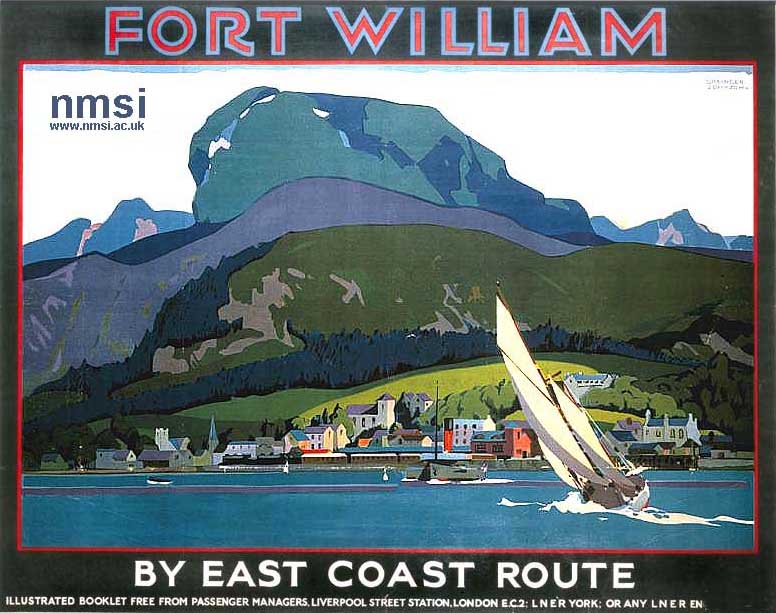
(Above-Below) This London and North Eastern Railway poster - 'Fort William by East Coast Route' - was painted by Grainger Johnson, and depicts a yacht sailing in the foreground with hills in the background. In the middle distance is what looks suspiciously like a double-header awaiting departure from Fort William station with a rake of Gresley teak coaches sporting white roofs. (Below) This classic ER Morten shot of Fort William Station in the early Fifties would make an ideal subject for a painting.
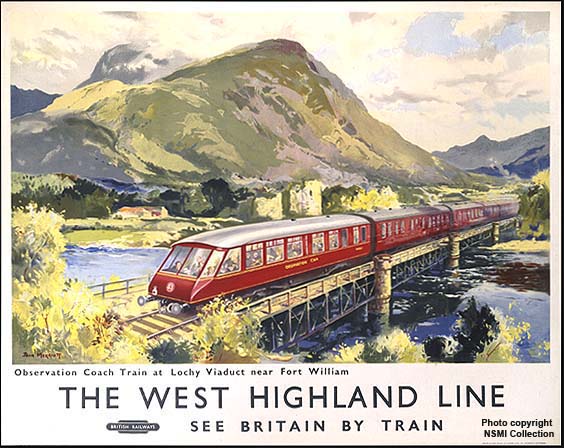
(Above-Inset-Below) Staying with the West Highland line, a superb view of Crianlarich Lower Junction looking east in 1957; the line to the left goes to Crianlarich Lower station and on to Callander, while the line climbing to the right goes to the present Crianlarich station joining the line from Fort William and so to Craigendoran and Glasgow. Crianlarich station opened concurrently with the West Highland Railway in 1894. In 1953 British Rail added the suffix 'Upper' to the station's name in order to distinguish it from the  nearby station on the Callander and Oban Line which then became known as Crianlarich Lower. Following the Beeching cuts in 1965, the Callander and Oban Line east of Crianlarich was abandoned and trains to Oban were rerouted up the West Highland Line as far as Crianlarich Upper station where they joined the remaining part of the Oban line by means of the link line; when Crianlarich Lower station closed in 1965 the Upper station's name reverted to Crianlarich. (Inset) A legacy of the West Highland Line is this BR(Sc) enamel running in board 'Crianlarich Upper' which went under the hammer for £900 at a Sheffield Railwayana Auction on 15th December 2012. (Below) This view of Crianlarich Lower Junction is looking west towards Oban. My thanks to Allan Trotter of Eastbank MRC for help with the captions.
nearby station on the Callander and Oban Line which then became known as Crianlarich Lower. Following the Beeching cuts in 1965, the Callander and Oban Line east of Crianlarich was abandoned and trains to Oban were rerouted up the West Highland Line as far as Crianlarich Upper station where they joined the remaining part of the Oban line by means of the link line; when Crianlarich Lower station closed in 1965 the Upper station's name reverted to Crianlarich. (Inset) A legacy of the West Highland Line is this BR(Sc) enamel running in board 'Crianlarich Upper' which went under the hammer for £900 at a Sheffield Railwayana Auction on 15th December 2012. (Below) This view of Crianlarich Lower Junction is looking west towards Oban. My thanks to Allan Trotter of Eastbank MRC for help with the captions.
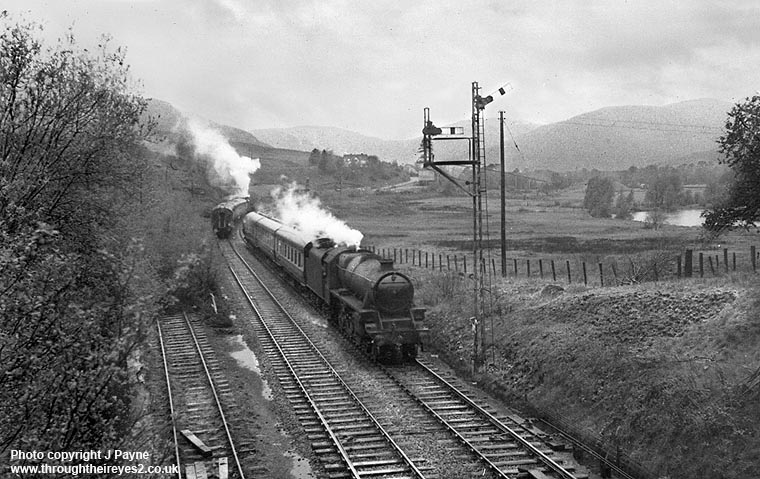
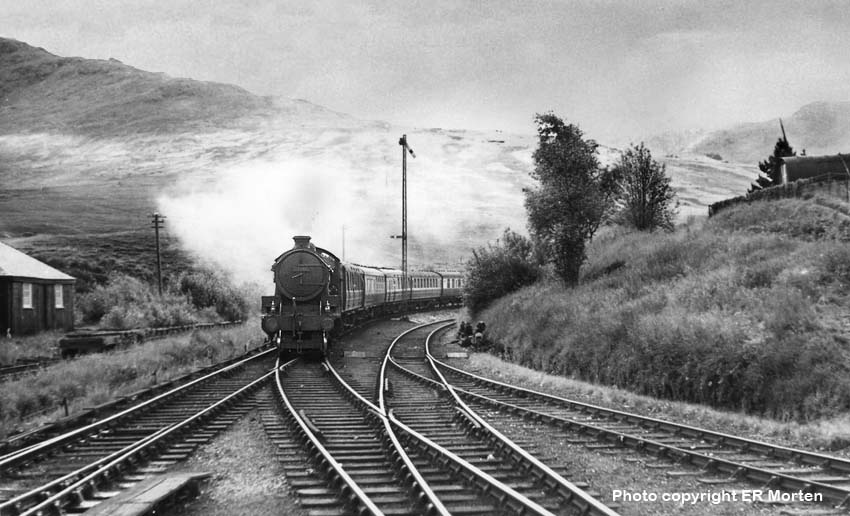
(Above-Below) More West Highland line memories from BR steam days! Panoramic shot of Class B1 No 61180 arriving at Crianlarich with a Fort William-Glasgow train on 24th July 1951. (Below) Northbound train at Bridge of Orchy 24th July 1951. An email address dealing with enquiries regarding ER Morten's photos can be found at the top of ER Morten's 'Rail Cameraman' Page 52 here
(Above-Below) A classic shot of steam days at Edinburgh Waverley station in 1957. M Holmes's NBR 2F Class J38 0-6-0T introduced in 1900 for light freight and station passenger pilot duties at Waverley station - the Waverley pilots had Westinghouse brakes, later dual-fitted. Here No 68474 looks pretty as a picture! (Below) This is yet another stunning poster from the NMSI collection - 'Edinburgh - North British Hotel, Waverly Station' painted by Fred Taylor. It shows a view of the famous hotel with Calton Hill in background. Opened in 1902, the North British Hotel became a prominent landmark at the east end of Princes Street. Built for the North British Railway Company adjacent to Waverley station, the architect W Hamilton Beattie was greatly influenced by the traditional Scottish baronial style of architecture that you associate with Medieval castles and French Renaissance châteaux of the sixteenth century; it somehow gives the hotel a grand sense of entitlement amongst the historical buildings around it; indeed the 190ft high clock tower is visible from some distance away in Edinburgh's city centre. The hotel was renamed the Balmoral Hotel in the 1980s - why? What possessed the new owners to dump such a great railway name? Perhaps I'm old-fashioned, but some things should be left alone. It's as if today's maverick high flyers are hell-bent on burying this country's centuries-old traditions. 

(Above-Below) The start of a Scottish bash back in the Sixties. (Below) Built at Darlington North Road Works in February 1928, Gresley's Class D49/1 4-4-0 No 62713 Aberdeenshire was one of 28 D49/1s fitted with piston valves, Walschaerts valve gear and derived motion - but by the time this photo was taken she is not long for this world! No 62713 has the dubious distinction of being the first of the D49/1 class to be  withdrawn from traffic on 9th September 1957 from Thornton Junction shed; she was cut up at Darlington North Road Works at the end of the following month. (Inset Right) A locomotive nameplate 'ABERDEEN-SHIRE', from the LNER D49 'Shire' Class 4-4-0 No 249 built at Darlington in February 1928, recently appeared at the famous Great Central Railwayana Actions. The loco was renumbered 2713 in 1946, later becoming 62713 during BR days when it was allocated to Dundee Tay Bridge and Thornton Junction. The original nameplates fitted to this loco had the name as a single word without the hyphen. The hyphenated plate (right) must be a replacement which was probably fitted when the loco visited Cowlairs Works and the original nameplates were found to be badly cracked, hence new plates were cast with the hyphen which the Cowlair Works hierarchy considered to be more correct, perhaps comparing it with the likes of Peebles-shire or Inverness-shire, which always carried hyphened nameplates. The plate measures 56" long, with the letters and border lightly polished. This Lot sold for £6,200 at Great Central Railwayana Auctions in April 2009. Click here to visit the fascinating GCR Auctions website.
withdrawn from traffic on 9th September 1957 from Thornton Junction shed; she was cut up at Darlington North Road Works at the end of the following month. (Inset Right) A locomotive nameplate 'ABERDEEN-SHIRE', from the LNER D49 'Shire' Class 4-4-0 No 249 built at Darlington in February 1928, recently appeared at the famous Great Central Railwayana Actions. The loco was renumbered 2713 in 1946, later becoming 62713 during BR days when it was allocated to Dundee Tay Bridge and Thornton Junction. The original nameplates fitted to this loco had the name as a single word without the hyphen. The hyphenated plate (right) must be a replacement which was probably fitted when the loco visited Cowlairs Works and the original nameplates were found to be badly cracked, hence new plates were cast with the hyphen which the Cowlair Works hierarchy considered to be more correct, perhaps comparing it with the likes of Peebles-shire or Inverness-shire, which always carried hyphened nameplates. The plate measures 56" long, with the letters and border lightly polished. This Lot sold for £6,200 at Great Central Railwayana Auctions in April 2009. Click here to visit the fascinating GCR Auctions website.

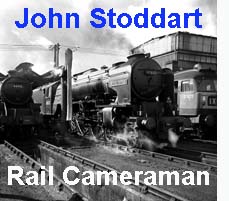 | 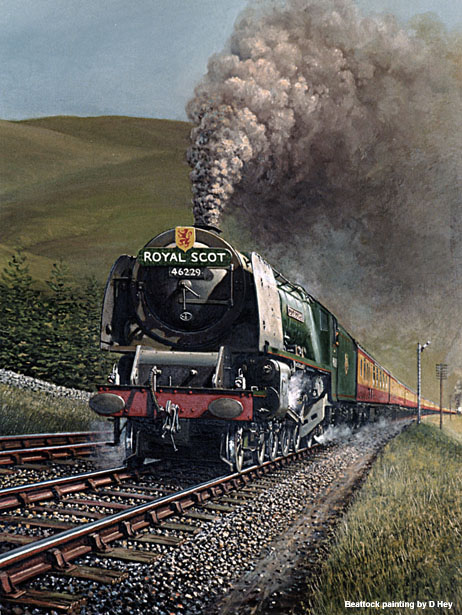 |
(Above Left-Right, Below) John Stoddart's Scottish bash back in 1964 will evoke memories of the ScR long forgotten. In the late summer of 1964, John bought a Scottish Railrover pass, valid from Carlisle north - and armed with a box camera, a 1959 Ian Allan Combine and a Scottish Region Timetable, planned to travel behind the gaggle of Gresley A4s reported to be working the Glasgow-Edinburgh three-hour expresses. At that time, just about every ScR branch line north, east and due west of Inverness was under Beeching threat, and the Railrover pass gave John a chance to do some last minute branch line bagging before time ran out. Click on photo-link for 'Rail Cameraman' page. (Above Right) painting of 'down' 'Royal Scot' on Beattock. (Below) A pair of 'Old Timers' await their next turn of duty at Inverness Loco shed in 1957: Class 2P 0-4-4T No 55236 introduced in 1915, one of Pickersgill's locos with detailed alerations to the original McIntosh Caledonian '439' class tanks introduced in 1900. Next to it is an earlier Caledonian Pug 0-4-0ST No 56038 introduced in 1885. 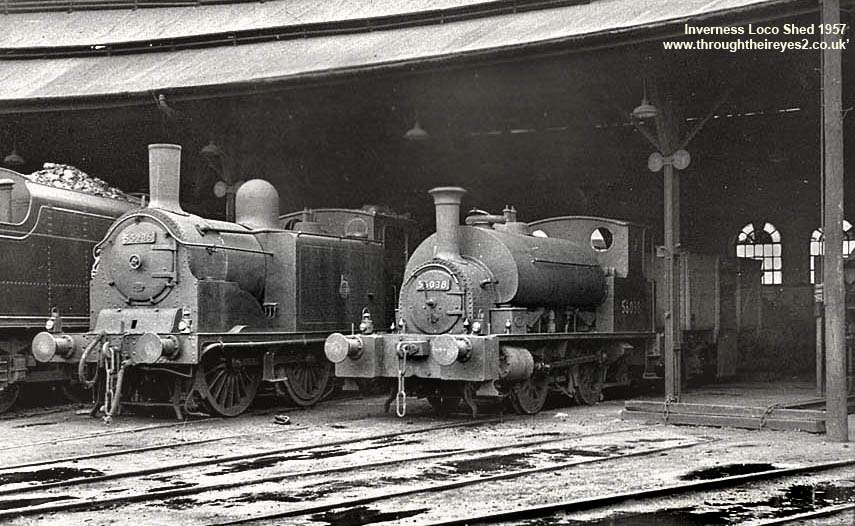


(Above-Below) A panoramic view of Inverness Loco (cobbled together from two individual photos) showing the line up of locos inside the roundhouse...you will have to click once then again to see the full view. (Below) In direct contrast is this splendid 1957 view of Blair Atholl showing 'Black 5' No 44796 awaiting departure with a mineral train, while BR Standard 2-6-4T No 80126 and Fairburn 2-6-4T No 42169 are in residence on shed.



BR's Scottish Region inherited a network of lines built by companies best known prior to grouping in 1923. For example, the LMSR was made up of the Caledonian, the Glasgow & South Western and the Highland Railway, whereas the LNER was comprised of the North British and Great North of Scotland Railway. All lines north of the border were amalgamated to form the new ScR, and the gallery shows some of the former pre-grouping company's engines that entered British Railways stock. For further information on this subject you'll find all you need to know on the LNER Encyclopedia website - it's a cracking site listing all LNER locomotive classes from A to Z!
ScR GALLERY

(Above-Below) Class D30 4-4-0 No 62417 seen on Glasgow Eastfield shed. (Below) Class V2 No 60933 emerging from The Mound Tunnel with a westbound train from Edinburgh Waverley.
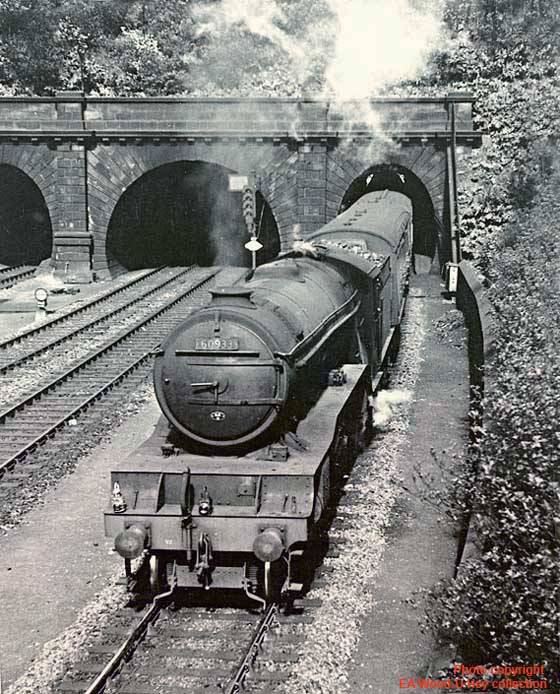
THE BR STANDARD CLASS LOCOMOTIVES
In 1948, the Railway Executive of the British Transport Commission (BTC) announced its preference for developing future steam power rather than dabbling with new, untried diesel traction. This led to the Locomotive Interchange Trials, supervised by RA Riddles, then member of the BTC's Railway Executive who was responsible for mechanical and electrical engineering. He was assisted by ES Cox, then executive member of the British Transport Commission for design - both ex-LMSR men, who doubtless had in mind their well intentioned plan for evaluating the relative performance of former companies engines in normal operating conditions. However it came as no great surprise that out of the twelve new BR standard classes (numbered in the 70-80,000s and 92,000s) many designs incorporated the latest features taken from LMSR practice.
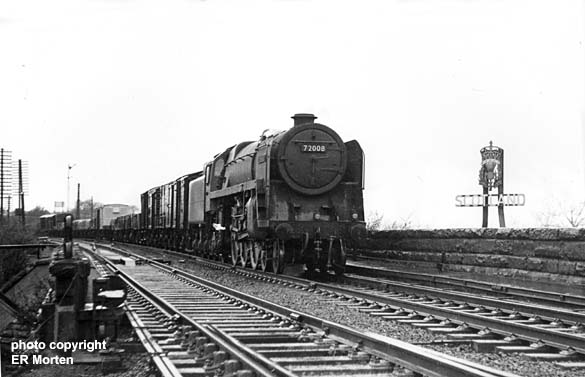
(Above-Inset) Out of the ten BR Standard Class 6MT Clan Pacifics built at Crewe between 1951-52 Nos 72000-4 went to Polmadie (Glasgow) and Nos 72005-9 were assigned to Carlisle (Kingmoor) for duties previously worked by the Jubilee and Patriot classes in Scotland. However, their performance was hardly  distinguished and withdrawal of the Polmadie five began as early as 1962, long before the withdrawal the ex-LMS types they had intended to replace. Here, sporting a Carlisle Kingmoor (12A) shed code on the smokebox door, No 72008 Clan Macleod shows its true mixed traffic capabilities heading a loose-couple freight for Carlisle Kingmoor off the Glasgow & South Western line at Gretna Junction on 14th April 1953. The train is crossing the River Sark, marking the Anglo-Scottish border, which is represented on the Scottish side by a sign displaying a Thistle above a Crown. (Inset) Another shot of 72008 Clan MacLeod, this time heading the 09.25 Crewe-Perth at Crawford on 22nd April 1965. Introduced to traffic in September 1952, No 72008 had a relatively short life...the loco was scrapped in April 1966.
distinguished and withdrawal of the Polmadie five began as early as 1962, long before the withdrawal the ex-LMS types they had intended to replace. Here, sporting a Carlisle Kingmoor (12A) shed code on the smokebox door, No 72008 Clan Macleod shows its true mixed traffic capabilities heading a loose-couple freight for Carlisle Kingmoor off the Glasgow & South Western line at Gretna Junction on 14th April 1953. The train is crossing the River Sark, marking the Anglo-Scottish border, which is represented on the Scottish side by a sign displaying a Thistle above a Crown. (Inset) Another shot of 72008 Clan MacLeod, this time heading the 09.25 Crewe-Perth at Crawford on 22nd April 1965. Introduced to traffic in September 1952, No 72008 had a relatively short life...the loco was scrapped in April 1966.
(Above) Although fractionally less powerful than the Class 6MT Clan Pacifics, the new BR Class 5MT, numbered 73000-73171 in the series, were a more useful addition to the BR fleet. The Class 5 was a direct descendant of the well-known LMS 'Black 5' and, on the grounds of utility and proven excellence in service the BTC might well have been justified in adopting the Stanier design as one of the standard engines.
(Above-Below) Yet another direct derivation of a former LMS engine is the 'BR4' 2-6-4T which came from the Stanier and Fairburn Class 4MT 2-6-4Ts introduced in 1945. The 'BR4' retained the familiar Stanier tapered boiler, trapezoidal-shaped smokebox and other detailed designs, but the cylinders had a smaller diameter, and the coupled wheels were also fractionally smaller. This gave a higher tractive effort of 25,100lb than the 24,670lb of the Stanier engines. Several of these engines were allocated new to Kittybrewster for use on the Aberdeen-Inverness service. Here, No 80111, is seen on the turntable at Inverness Shed in May 1961. In the roundhouse are three Type 2 Bo-Bos awaiting their next turn of duty - a BRCW Co numbered in the D53XX series; one of the temperamental North British Loco Co Type 2s numbered in the D61XXs and a BR/Sulzer Type 2 Bo-Bo with the message 'GO' in its route indicator panel.
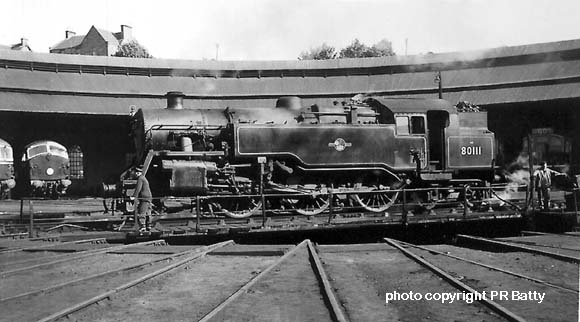
STEAM ACTION ON BEATTOCK BANK 
Steam enthusiasts will remember the transition from steam north of the border with mixed emotions. The high point was the relocation of seven Gresley A4 Pacifics to Scotland and their final fling on the 3hr schedule Glasgow-Aberdeen expresses, two in each direction, the last hauled by No 60019 Bittern on 3rd September 1966. Another highlight was the amazing sight of preserved engines from the GNSR, NBR, Caledonian and Highland Railways, decked out in their respective pre-grouping liveries for hauling steam 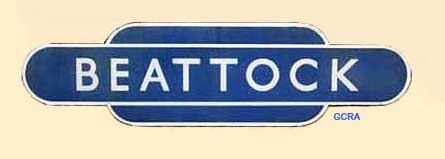 specials on the main line.
specials on the main line.
The downside was the Beeching cuts which had a devastating effect on the ScR's rail network. (Inset Right) For example, a ScR light blue totem sign from Beattock Station on the former Caledonian Railway's Carlisle to Glasgow main line. The station was once the junction for the short branch to Moffat, and its closure in 1972 produced the country's longest section of line without a station between Carstairs and Lockerbie. Okay, perhaps it isn't the most densely-populated region in the country, but the closure of other major routes such as the line between Aviemore and Forres; Dunblane to Crianlarich; Dumfries to Stranrear - and, of course, the Waverley route between Edinburgh and Carlisle was typical of Beeching's excesses. Miraculously, despite proposals for the complete closure of the Far North line from Inverness to Wick and Thurso, and the Skye line from Inverness to Kyle of Lochalsh, both routes remained stubbornly intact.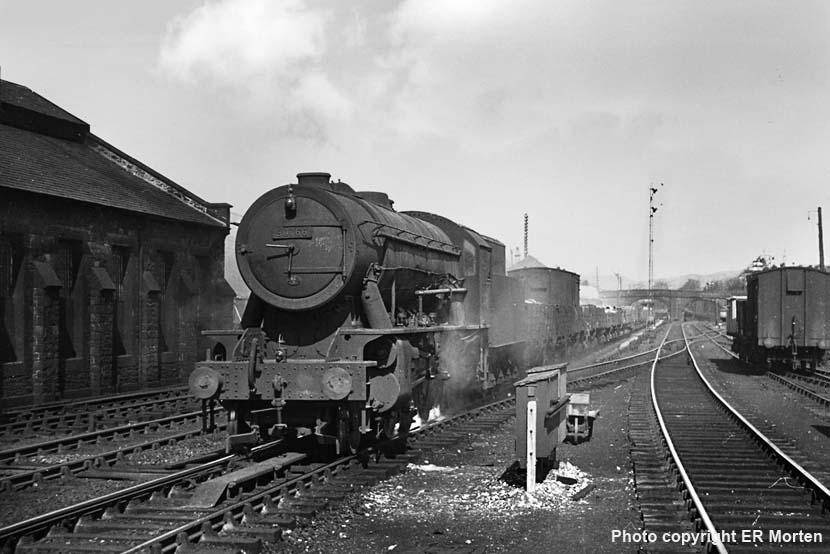
(Above-Below) A cracking shot from the ER Morten shows sparks flying (and smoke billowing) from the brake blocks of this WD 2-10-0 No 90766 heading a southbound express freight at the bottom of Beattock Bank on 14th April 1953. (Below) In 1961 Stuart Sanders of Hitchin in Northamptonshire travelled north of the border to photograph steam action on the ScR; this lovely shot of Duchess of Buccleuch approaching Beattock station with a southbound express on 31 May 1961 will doubtless be of interest to modellers; the detail in the stonework of the loco shed (68D) and general trackside paraphernalia can be clearly seen. With the introduction of more modern diesel traction in the late 1960s, the importance of Beattock's allocation of banking locomotives to assist heavy northbound trains on the 10 miles of 1 in 74 gradient was no more; today both engine shed and station have long since gone, and the site is now occupied by engineer's sidings and passing loops. 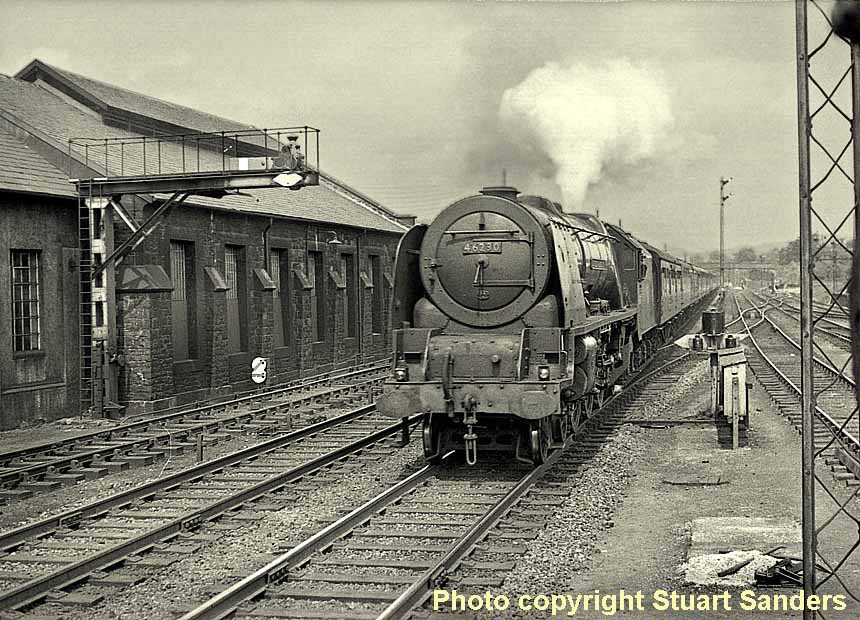
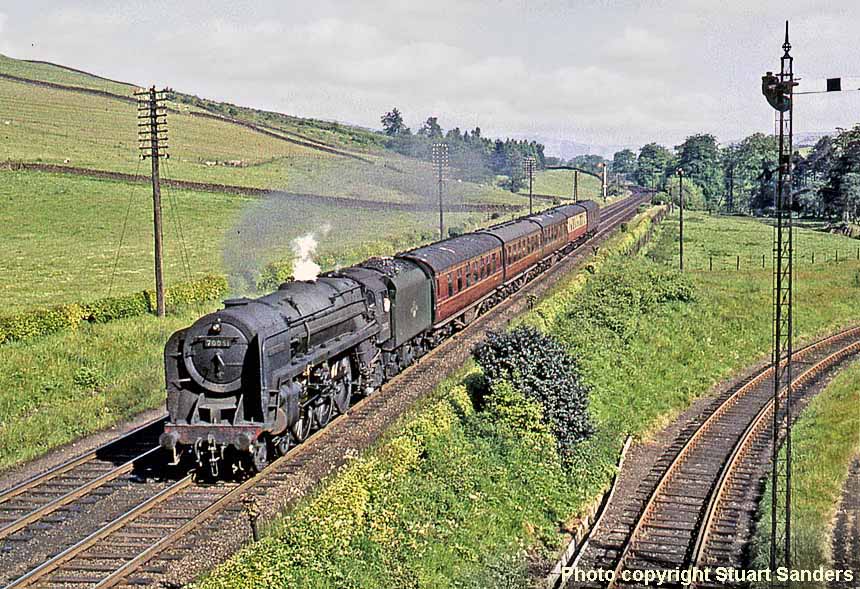
(Above-Below) From the river flats of the lower Annan valley, the landscape changes graphically with altitude during the ten mile climb of Beattock bank to the high watershed of the Annan and Clyde rivers. Dropping off the bottom of Beattock bank amidst pleasant countryside, BR Class 7MT No 70051 Firth of Forth slows for its stop at Beattock on 31 May 1961; the ex-Caledonian lower quadrant signal on the right controlled the 2 mile-long single-line branch from Moffat trailing in from the east. The branch lost its passenger service in 1954 and finally closed to freight in 1964. (Below) The rolling hills become more spacious as the line climbs higher; trees are fewer and airy open spaces dominate the landscape beyond Greskine. Here 'Black 5' No 44969 is three-quarters of the way up the bank at Harthorpe on 31 May 1961.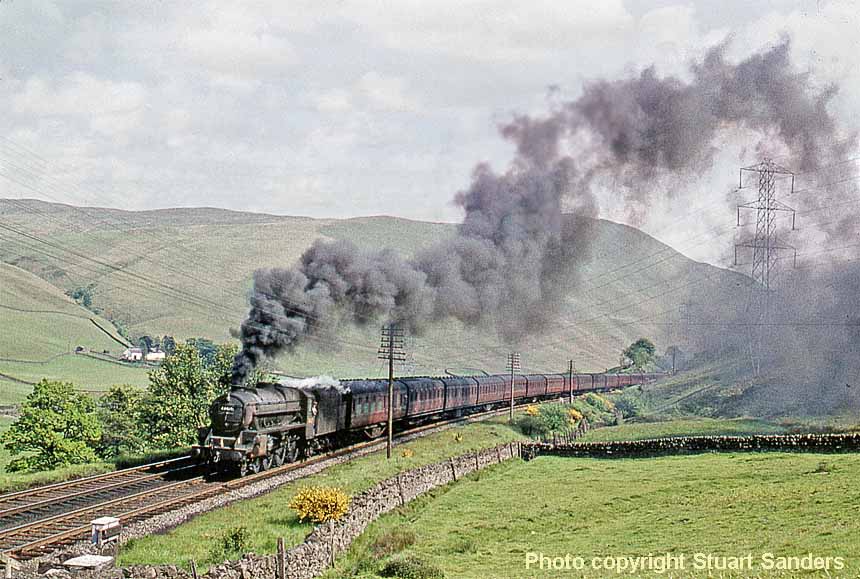
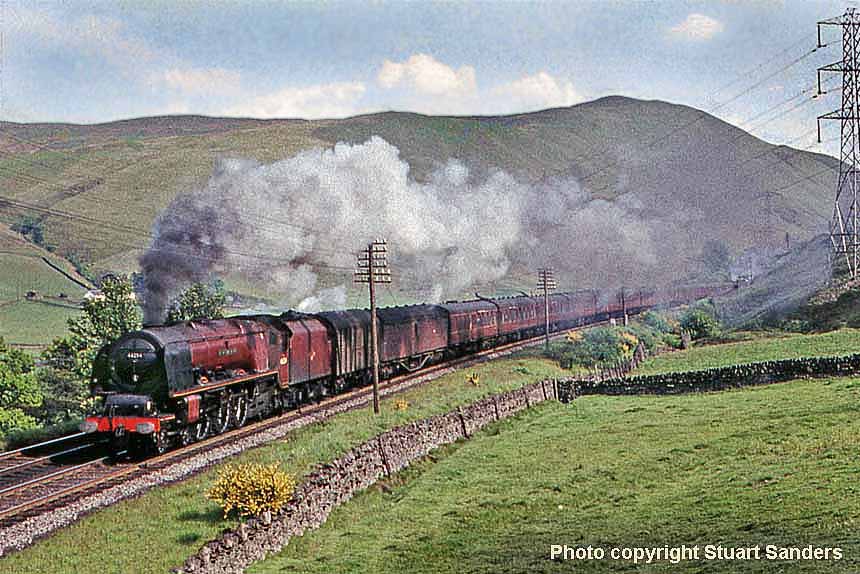
(Above) Stuart spent nearly all day waiting to photograph a red duchess, a rarity at this time, and so with evening approaching he crossed beneath the main line in order to be on the correct side for the sun, but as sod's law would have it, whilst under the bridge a red Duchess pounded north above him - an event surely all enthusiasts have experienced! But he was later rewarded when a second red 'Duchess' appeared, and this is the picture - No 46254 City of Stoke on Trent at the head of a northbound express. 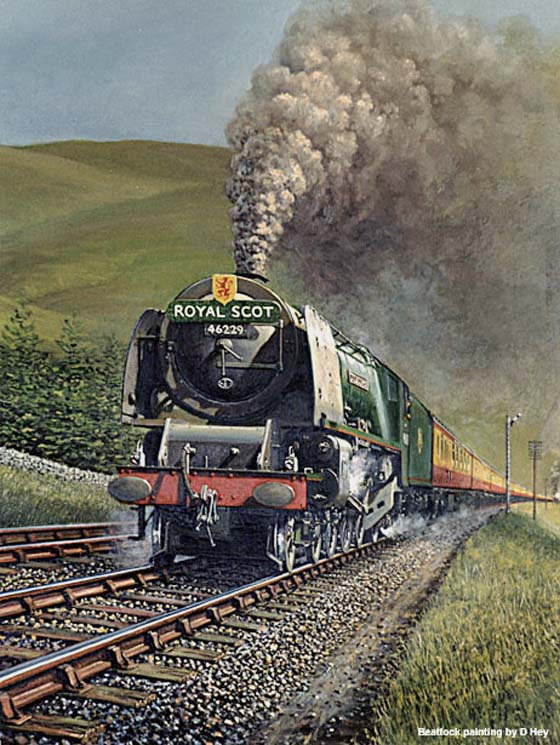
(Below) The heavily wooded slopes to the west of Beattock bank, planted by the forestry Commission, can be clearly seen in this shot of 'Jubilee' class No 45696 Arethusa coasting downhill between Harthorpe Viaduct and Greskine box. For the record, the West Coast Main Line between London and Glasgow was electrified in stages between 1959 and 1974. The Crewe-Manchester line was the first stretch to be electrified on 12 September 1960, followed by the line between Crewe and Liverpool on 1 January 1962. Electrification was then extended southwards to London, with the full electric service starting on 18 April 1966. However, it wasn't until May 1974 that electrification of the final section north of Crewe (between Weaver Junction and Glasgow Central) was completed.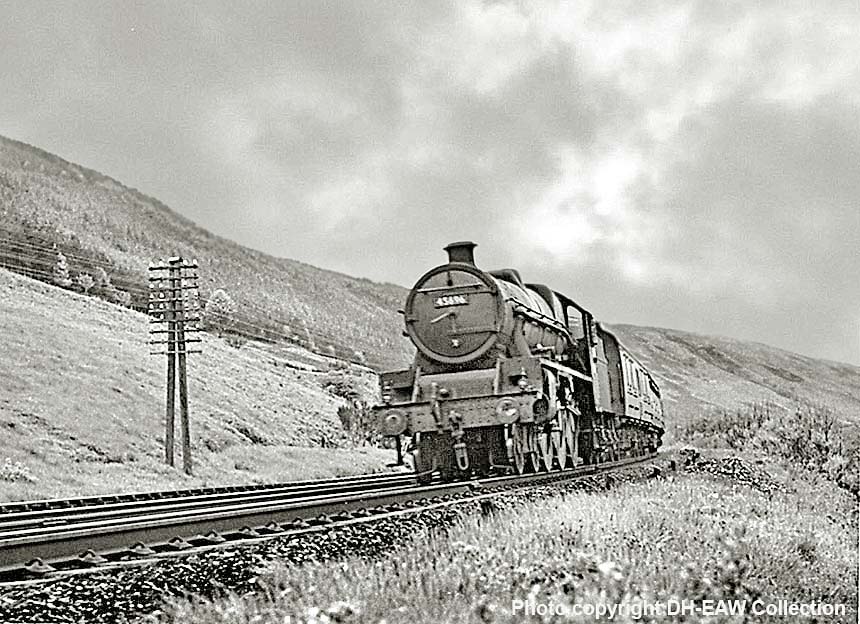
ALLAN TROTTER'S SCOTTISH REGION ALBUM.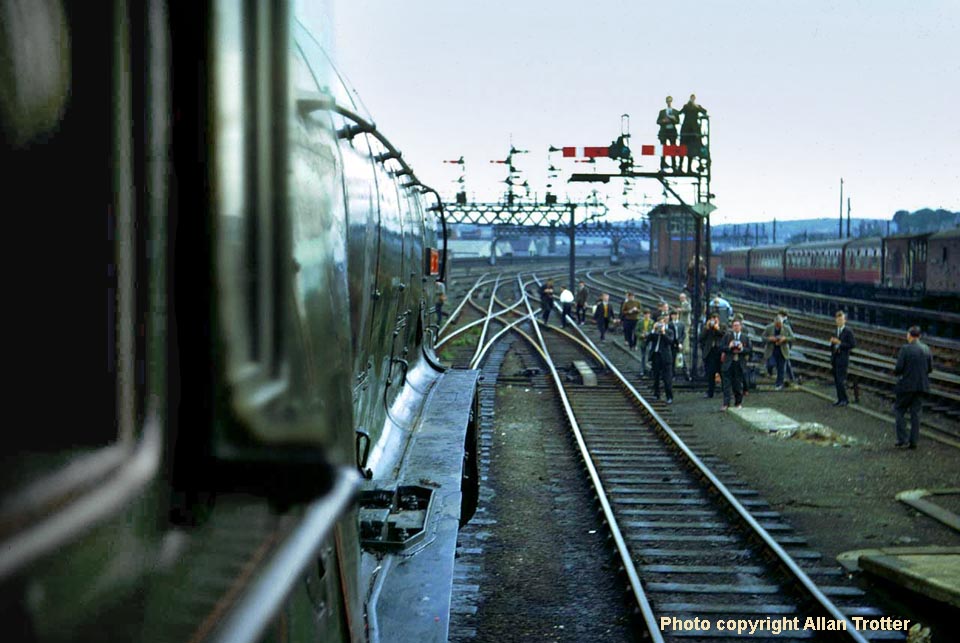
(Above-Below) Allan Trotter of Eastbank MRC (link bottom of page) has trawled his collection of old slides of ScR steam for inclusion on this page. I am delighted to feature Allan's shots of the last public run of Class A4 No 60019 Bittern on the Glasgow Buchanan Street-Aberdeen special which took place on Saturday 3rd September 1966...almost 50 years ago! Unbelievable how time flies! Allan's scans include a photo taken from the cab of Bittern and another showing an overall view of enthusiasts gathering at Aberdeen station from the lofty heights of the signal post...imagine trying to take a picture like that today!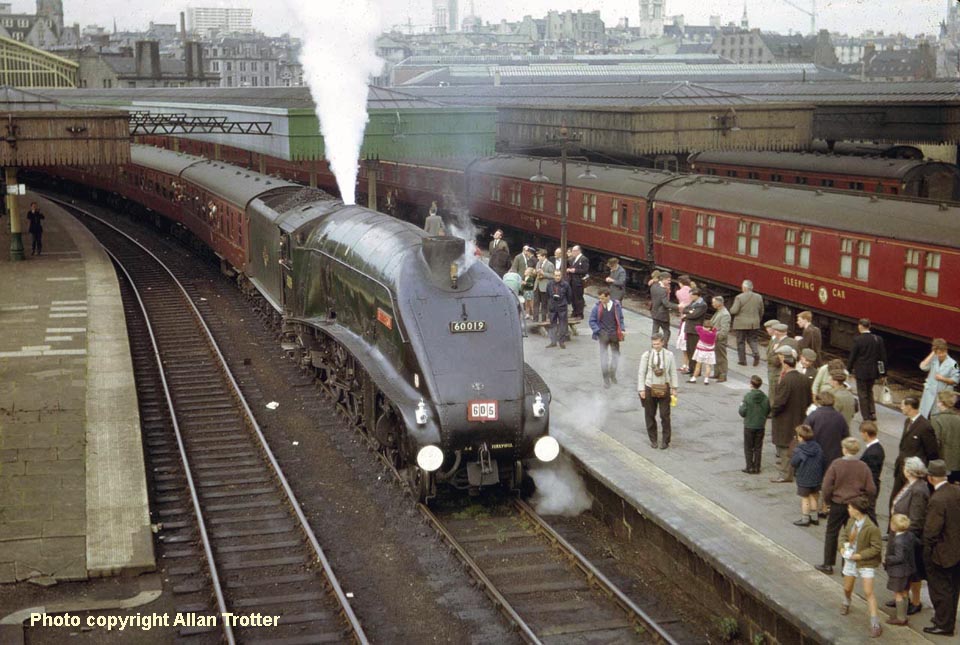

(Above-Below) Class A4 No 4464 Bittern emerged from the famous Doncaster 'Plant' in 1937 painted in the LNER Garter Blue livery. Allocated initially to Heaton shed, Bittern was transferred to Gateshead on in March 1943, but with the outbreak of World War 2, austerity measures led to Bittern losing her garter-blue for a dull wartime black livery. During the Second World War ECML expresses were inevitably cut back and the A4  fleet was called upon to perform duties such as heavy passenger and freight work. A combination of heavy loads and poor maintenance finally took their toll and by the end of the war the A4s were in a poor state. Following nationalisation in 1948, the A4s saw something of a revival on the ECML during the Fifties and Bittern was transferred to St Margarets in 1963. However, with the new diesels making major inroads, the A4s reign on express passenger services was short-lived. After a short period in storage Bittern was moved to Aberdeen Ferryhill shed in November 1963. (Inset) An Aberdeen Ferryhill shedplate 61B (as used from nationalisation in 1948 to February 1967). This joint shed was used by the Caledonian and NBR but perhaps most famously remembered for its 1960s allocation of 14 Gresley A4s performing their main line swan song on the Glasgow expresses. The final two A2s also worked from this depot. It had an allocation of 40 locos in 1950, dwindling to just 5 during its final few months by which time all the Pacifics had gone. Allan Trotter's superb colour shots give us a glimpse of the last A4s in public service, No 60024 Kingfisher and 60019 Bittern, being prepared by shed staff at Ferryhill, thus bringing the curtain down on 30 years of service. After the last steam-hauled Glasgow to Aberdeen special, Bittern was withdrawn from British Railways service on 5th September 1966 and subsequently bought by Geoff Drury three days later.
fleet was called upon to perform duties such as heavy passenger and freight work. A combination of heavy loads and poor maintenance finally took their toll and by the end of the war the A4s were in a poor state. Following nationalisation in 1948, the A4s saw something of a revival on the ECML during the Fifties and Bittern was transferred to St Margarets in 1963. However, with the new diesels making major inroads, the A4s reign on express passenger services was short-lived. After a short period in storage Bittern was moved to Aberdeen Ferryhill shed in November 1963. (Inset) An Aberdeen Ferryhill shedplate 61B (as used from nationalisation in 1948 to February 1967). This joint shed was used by the Caledonian and NBR but perhaps most famously remembered for its 1960s allocation of 14 Gresley A4s performing their main line swan song on the Glasgow expresses. The final two A2s also worked from this depot. It had an allocation of 40 locos in 1950, dwindling to just 5 during its final few months by which time all the Pacifics had gone. Allan Trotter's superb colour shots give us a glimpse of the last A4s in public service, No 60024 Kingfisher and 60019 Bittern, being prepared by shed staff at Ferryhill, thus bringing the curtain down on 30 years of service. After the last steam-hauled Glasgow to Aberdeen special, Bittern was withdrawn from British Railways service on 5th September 1966 and subsequently bought by Geoff Drury three days later. 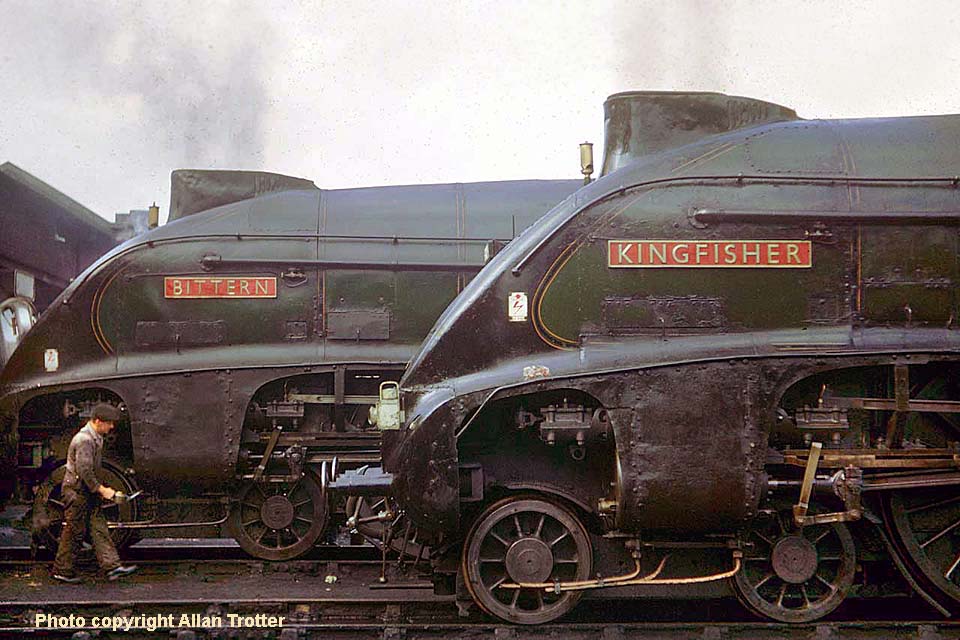

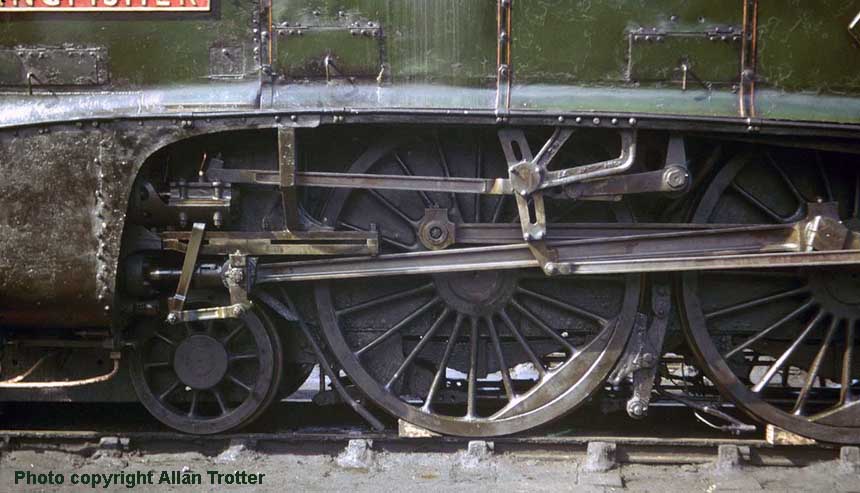
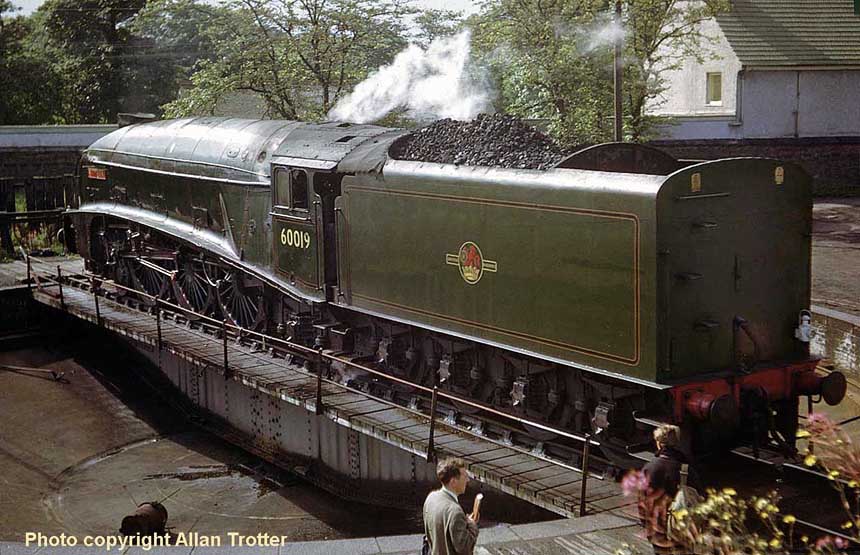

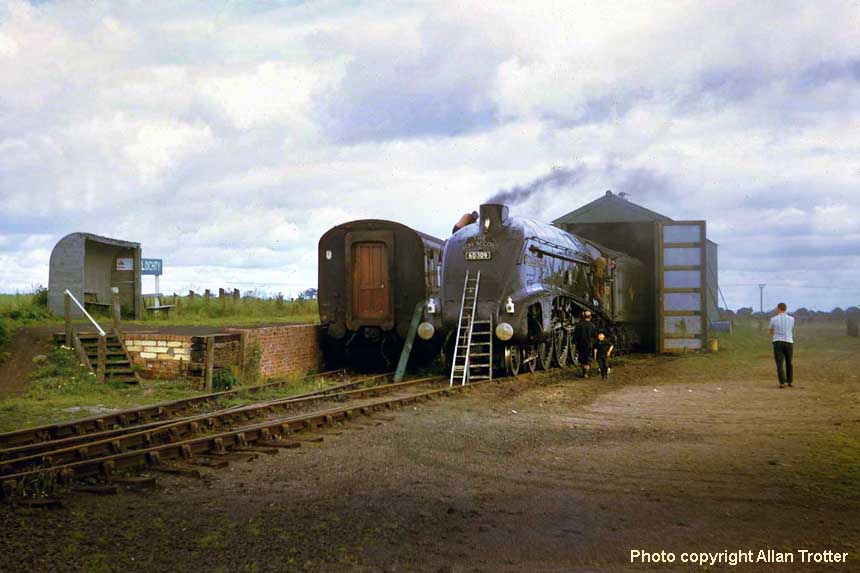
(Above) Another Class A4 with a long ScR association is No 4488 Osprey built at Doncaster Plant in April 1937, perhaps better known as 60009 Union of South Africa, the first of five Class A4s Nos 60009-13 to be named after countries of the British Empire. The springbok plaque on the side of the locomotive was donated in 1954 by a Bloemfontein newspaper proprietor. Following withdrawal, 60009 was purchased by John Cameron for preservation on the newly-formed Lochty Private Railway in Fife, Scotland.
(Right) A locomotive badge measuring 10" x 12½" depicting a Kingfisher perched on a log with a fish in its beak, as carried on the LNER A4 Class 4-6-2 No 60024, went under the hammer for £6,600 at a Great Central Railwayana Auction on 14 April 2012. This was one of a pair of plaques previously carried by 'HMS Kingfisher', a Royal Navy L70 Patrol Vessel and lead ship of the Kingfisher-class sloops. The Kingfisher 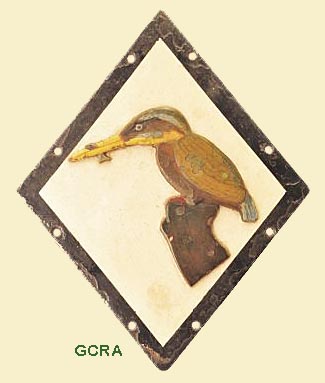 badges were presented to British Railways by the Royal Navy on 21st October 1954 and fitted in a central position on each side of the boiler casing of 60024 at Haymarket shed. The Gresley A4 Pacific No 60024 was built at Doncaster Works in December 1936, renumbered 585 in March 1946 and then No 24 in May 1946 before eventually becoming 60024 in June 1948. The loco was allocated new to Haymarket and spent most of its working life there apart from brief spells at Kings Cross and Doncaster and, at the end, Dalry Road, St Margarets and Aberdeen Ferryhill from where it was withdrawn in September 1966 to be cut up at Hughes Bolckow Ltd at North Blyth in February 1967.
badges were presented to British Railways by the Royal Navy on 21st October 1954 and fitted in a central position on each side of the boiler casing of 60024 at Haymarket shed. The Gresley A4 Pacific No 60024 was built at Doncaster Works in December 1936, renumbered 585 in March 1946 and then No 24 in May 1946 before eventually becoming 60024 in June 1948. The loco was allocated new to Haymarket and spent most of its working life there apart from brief spells at Kings Cross and Doncaster and, at the end, Dalry Road, St Margarets and Aberdeen Ferryhill from where it was withdrawn in September 1966 to be cut up at Hughes Bolckow Ltd at North Blyth in February 1967.
(Below) The Lochty Private Railway in Fife occupied the abandoned trackbed of the former East Fife Central Railway, a fifteen mile-long freight only branch built to serve the coal pits and agriculture in the area. After closure in 1965, a shed was built to house the newly-acquired A4 and 3-4 mile of track was relaid; one pair of points and one line leading into the shed, the other to the old loading bank which was modified to serve as a platform. Every Sunday afternoon during the summer No 60009 was steamed up and down the line for the benefit of the many photographers and public spectators. Here we feature another great shot by Allan Trotter of 60009 in August 1971. Two years later the lifting of BR's steam ban led to 60009 moving back to BR metals at the end of January 1973. Two routes were allocated in Scotland for the running of steam special trains and it was most fitting that 60009 hauled the first stream trip after the ban was lifted. The A4 proved she was more than capable of handling nine coaches at speeds of up to sixty miles per hour over the difficult Edinburgh-Dundee main line. Alas, the Lochty Private Railway closed in 1992...

(Above) Peppercorn's Class A2 was a redevelopment of Thompson's six Class A2/2s (rebuilt P2s) with a shorter wheelbase. The A2s initially hauled expresses along the length of the ECML, but the swansong of the class came in eastern Scotland with some quite memorable performances over the Aberdeen road during the early 1960s. This LNER Peppercorn A2 'Tudor Minstrel', originally numbered E528, was built at Doncaster in February 1948. Later renumbered 60528 in June 1948, it was allocated new to Gateshead but was transferred to Dundee Tay Bridge in 1949. It remained a Scottish Region engine for the rest of its working life, with spells at Perth, Dundee and finally Aberdeen Ferryhill (61B). Withdrawal of the class began in 1962, the last three being No 60528 Tudor Minstrel, No 60530 Sayajirao and the now-preserved No 60532 Blue Peter from 62B Dundee Tay shed. Withdrawn in June 1966, Tudor Minstrel spent a period in store at Dundee Tay Bridge before it was cut up at McWilliams, Shettleston the following December. The engine takes its name from the horse owned by Mr JA Dewar, which won the 2000 Guineas by 8 lengths in 1947. This unrestored nameplate is 71" long, and in common with other members of the class has the names of other LNER locos visible on the back. The nameplate went under the hammer for £14,600 at a Great central Railwayana Auction in July 2009. (Below) Despite a wet miserable day, a sodden Allan Trotter was rewarded with this shot 60528 adjacent to Dundee Esplanade Station in May 1965.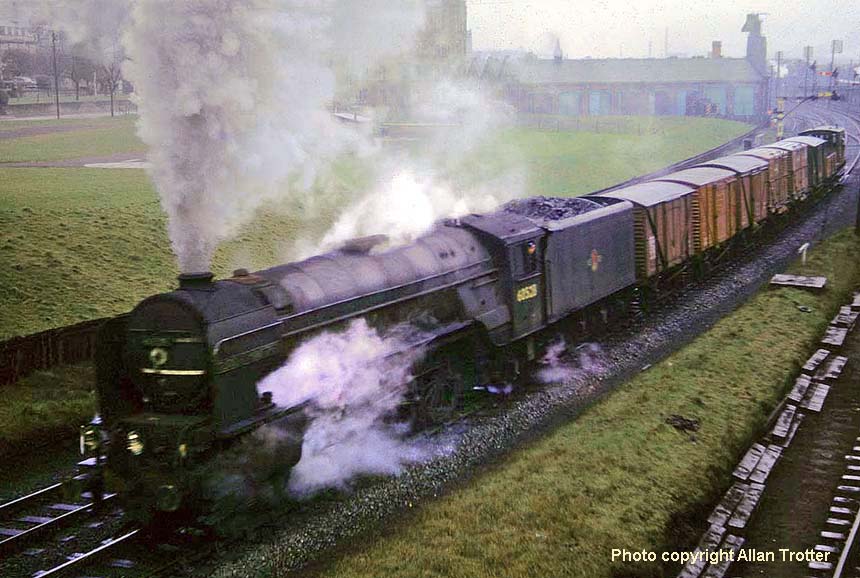
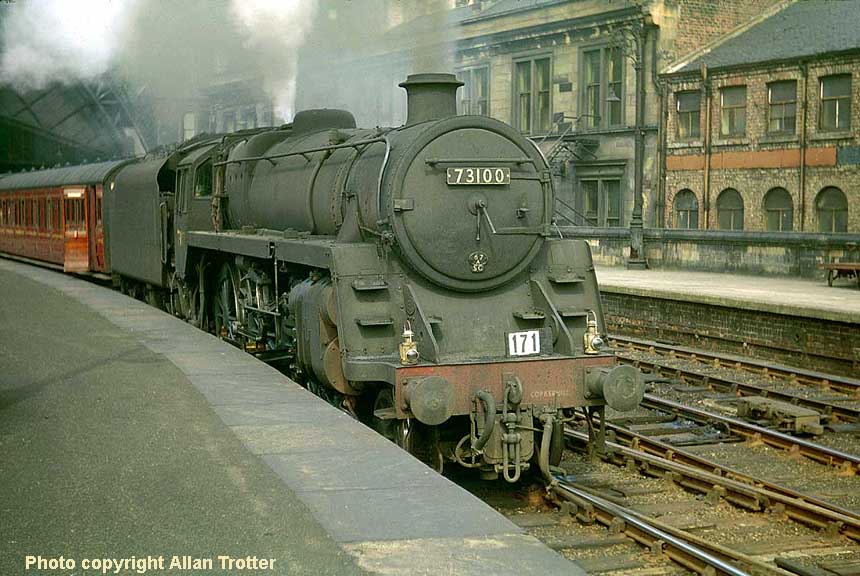
(Above-Below) The BR Standard Class 5MT 4-6-0 was built by British Railways during the 1950s. In all 172 locos were constructed, with a few variations; the class essentially being a development of the Stanier Black Five. New to traffic on 31st October 1955 No 73100 became a Corkerhill Glasgow (67A) loco all its life. This fine shot shows No 73100, sporting stencilled Corkerhill lettering on the bufferbeam, awaiting departure from Glasgow St Enoch in May 1966. Within twelve months 73100 was scrapped by Motherwell Machinery & Scrap at Winslow on 31st January 1967. (Below) BR Standard 5MT No 73064 heads a westbound train through Arkleston Cutting, near Paisley in June 1966.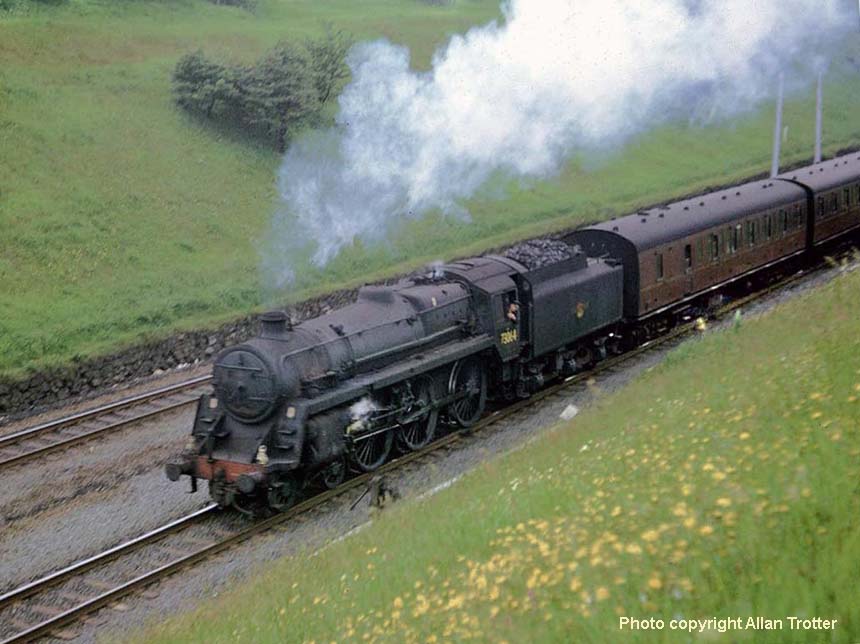

(Above-Below) Stanier Black 5s, one in each direction, pass through Arklestone cutting in May 1966. Originally the Glasgow Paisley Joint Line (CR and G&SWR) was comprised of four lines in its entirety. During the early 1960's the two fast lines were removed and overhead electrification masts installed in the centre. In some cases, however, the poles were erected before the track was removed. The cutting is situated just east of Arkleston Junction where the four tracks remained towards Paisley Gilmour Street Station, but even this section was reduced to two running lines, retaining just two loops. With the recent upsurge in rail traffic, it has now been found that the removal of the centre lines and subsequent reduction in capacity was an error and reinstatement has become necessary. But it was stated that it would be impossible to reinstate the four lines as there was insufficient space...no doubt due to some Health and Safety zealot's decree! Therefore only one new line has been installed.

(Above-Below) A Class 105 DMU approaches Paisley Gilmour Street on a service to Gourock or Weymss Bay in July 1967. The electrification has now been completed, the diesels will soon be redeployed and services to the Clyde Coast will be handled by the ubiquitous Class 303 Blue Trains. (Below) New to traffic at the beginning of March 1960, EE Type 4 D264 was among the first of two batches of Class 40s allocated new to Haymarket shed (64B). Here D264 (later Class 40 40064) is seen passing Newton Station on a mineral train in January 1968. At the time electrification was in place awaiting the full Electric Scots service which would commence in 1974. The only electric trains passing here were the Class 303 on the service between Glasgow Central to Motherwell via Kirkhill. D264 was transferred from Haymarket to Longsight in September 1981 and scrapped in April the following year...a further selection of Allan's diesel photos can be found on the 'BR Scottish Region Diesels' page 25.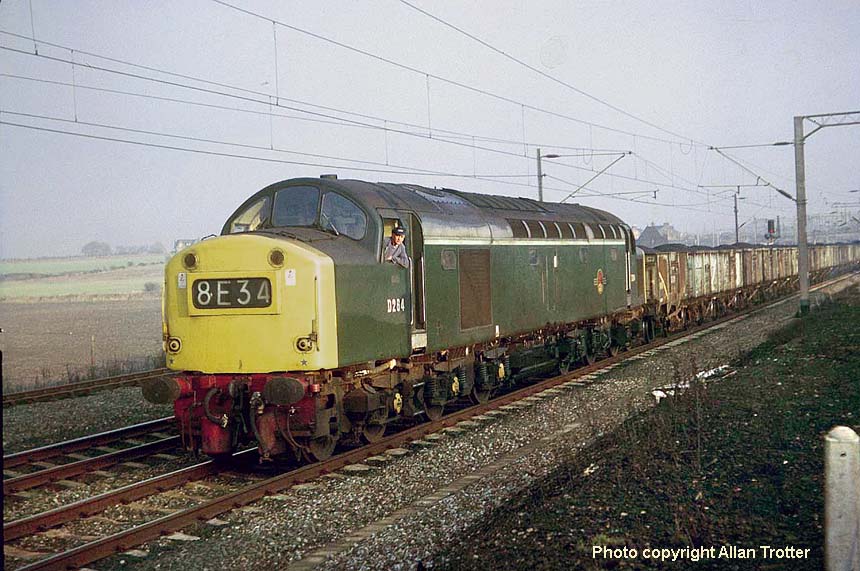
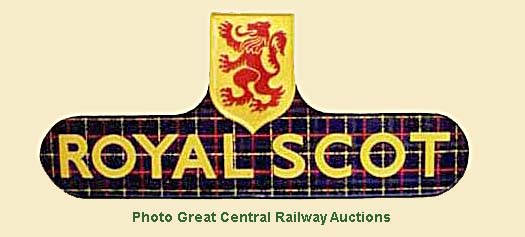
(Above-Below) A cast aluminium locomotive headboard 'Royal Scot' measuring 69" x 25½", with yellow lettering on a tartan background crowned by a heraldic shield displaying a red lion rampart from the Royal Banner of Scotland, sold for £6,400 at GCR Auctions on 25th April 2009. (Below) This extravagant 'Caledonian' locomotive headboard was used on the Anglo-Scottish express train introduced in June 1957 between Euston and Glasgow Central. The service ran until September 1964. This ex-loco condition headboard measures 59" long crowned by a pair of heraldic shields displaying the white sulture representing St Andrew, the patron saint of Scotland and and the cross of St George, the patron saint of England. This lot sold for £4,000 at Great Central Railwayana Auctions on 18th July 2009.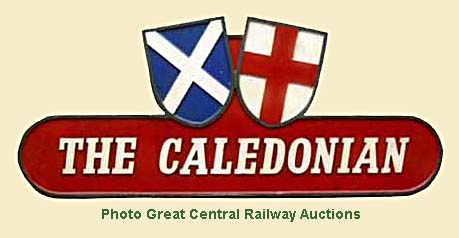

(Above-Below) The celebrated Drummond 'Standard Goods' Class 2F 0-6-0 of the Caledonian Railway was introduced in 1883, upon which both J Lambie and JF McIntosh later made additions and modications. I include this ER Morten shot of 57354 heading an Ayr-Girvan freight on 23rd July 1951 for good reason; quite apart from it being a great photo it is the first I have ever seen a locomotive carrying a shedcode above its numberplate on the smokebox door. Now I'm not sure if anyone can throw any light on the subject…it just might be a one off! (Below) A spirited effort by 'Black 5' No 44763 on the climb out of Girvan on 23rd July 1951. Built at Crewe Works in October 1947 and allocated new to Crewe North (5A) the loco ended its days on the ScR from where it was withdrawn in September 1965 and scrapped at Cashmores, Great Bridge in the December. 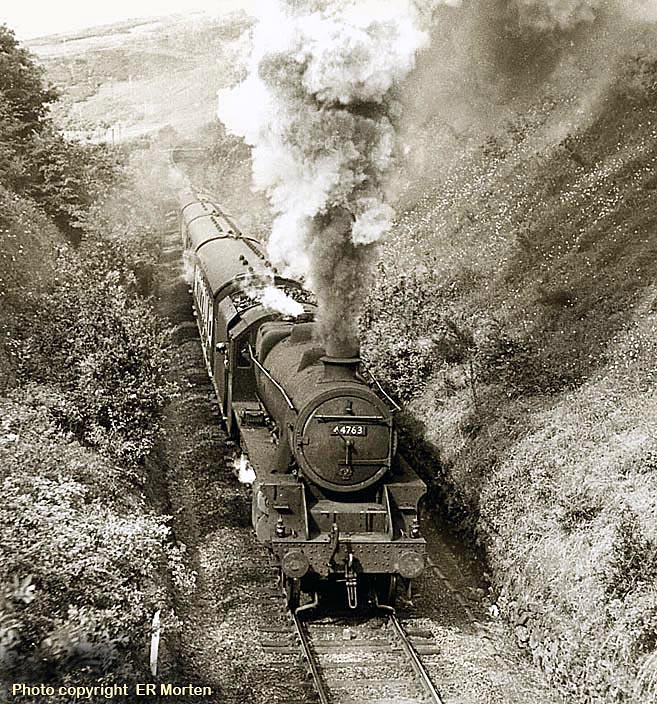
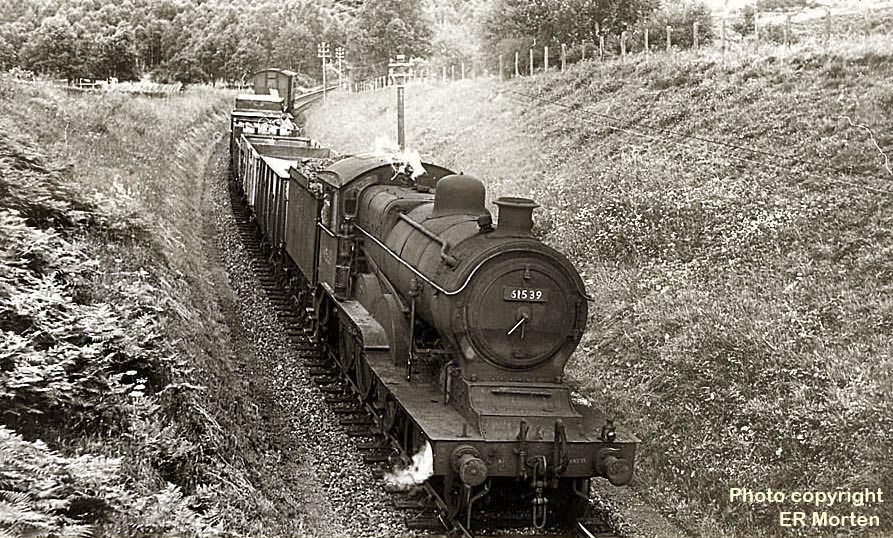
(Above-Below) Introduced in 1911, SD Holden's orginal superheated B12 4-6-0's were built to handle the heavy continental boat trains from Liverpool Street to Harwich (Parkeston Quay). They very quickly proved themselves capable of some fine performances in the hands of the link of drivers at Parkeston Quay working the Hook of Holland boat expresses. Rebuilt by Gresley from May 1932, many of the class migrated north of the border to work services on the former Great North of Scotland line between Aberdeen and Elgin, and on the fish trains from the Buchan ports. Here, No 61539 heads a goods for Aberdeen near Balchory on 21st July 1954. (Below) Stanier 'Black Five' No 44798 departs from Garve with the 9.05 Inverness-Kyle of Lochalsh on 10th September 1951.
Footnote: Ian Cranna has pointed out two typos of place names (bracketed) in the original captions: B12 61539 is near Banchory (not Balchory) on the Deeside line, and the Black Five 44798 is leaving Garve (not Girvan), as can been seen on the signal box sign in the right foreground. Girvan is indeed in Scotland but more than 100 miles to the southwest in Ayrshire - and definitely not a calling point for Kyle to Inverness trains! Thanks Ian.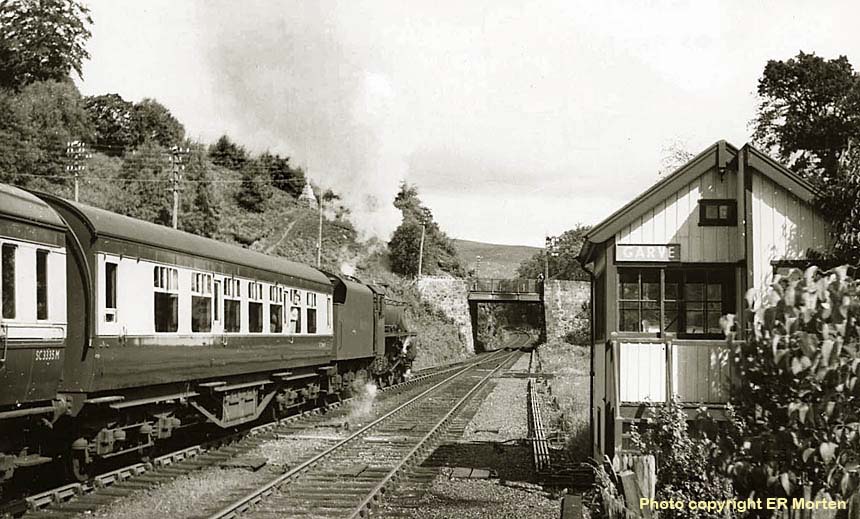
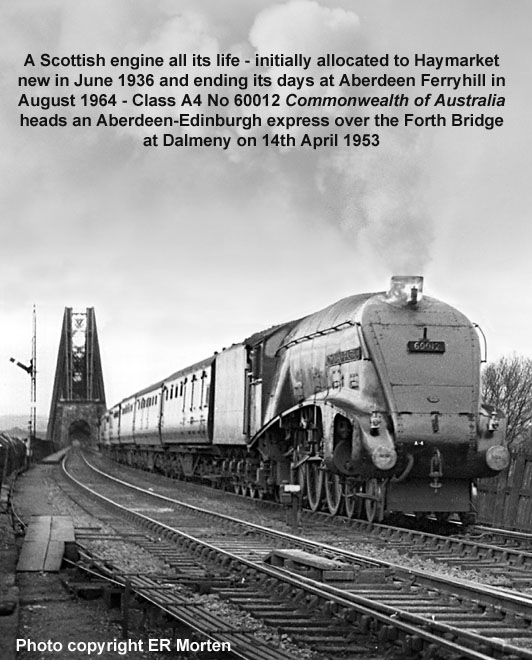
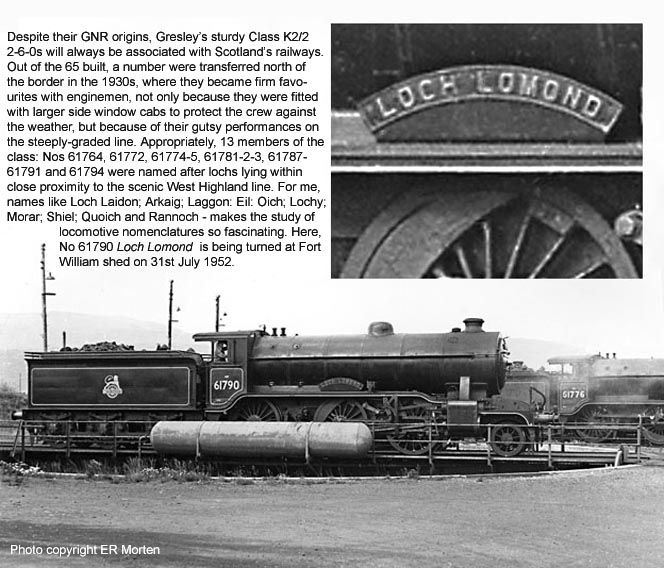
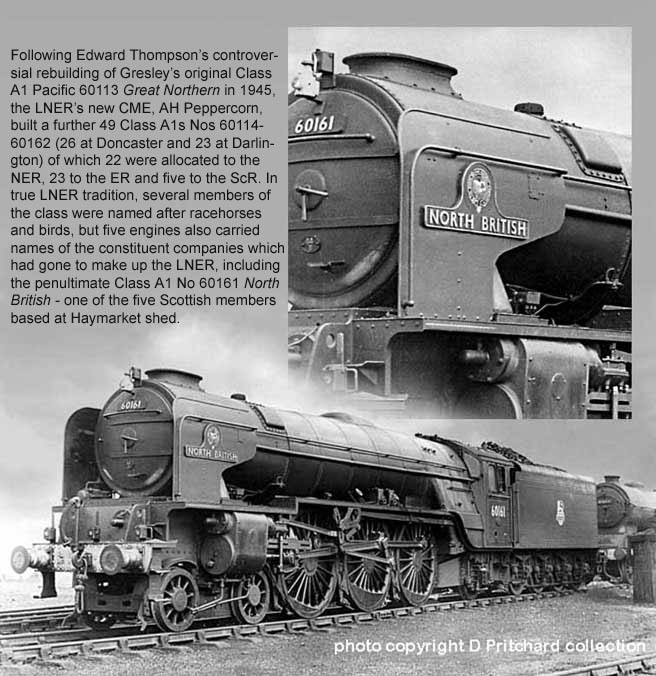
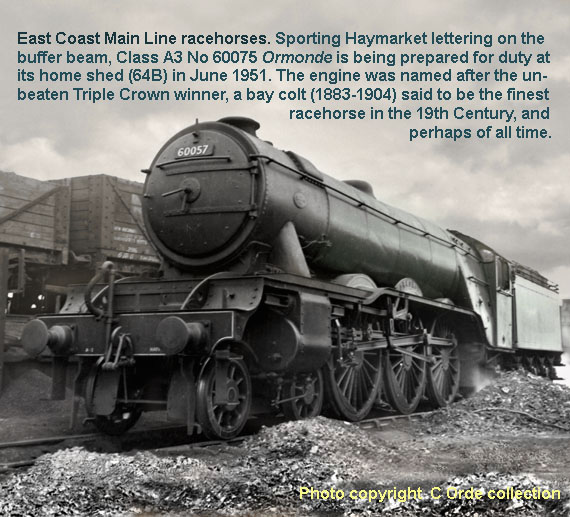

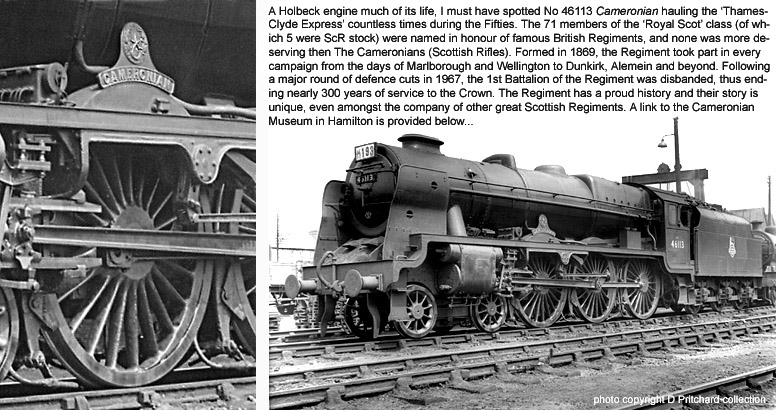
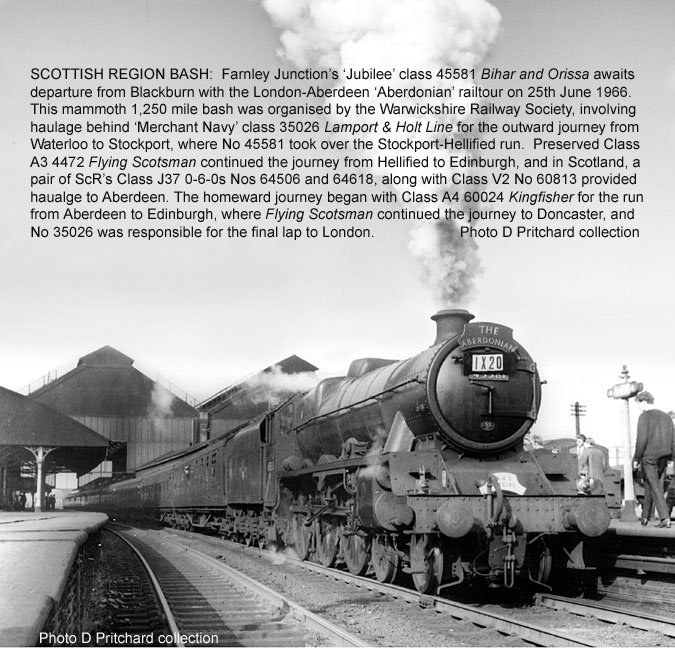
TRANSITION FROM STEAM
During the early 1960s, the rank and file of steam classes were in a poor state and it became increasingly difficult for the operating department to find a suitable steam locomotive with a power classification relative to its train formation; either being too heavy or too light for the purpose.
The introduction of a new fleet of diesel multiple units offered a practical solution to this problem as the engines of several railcars could be coupled together to meet varying traffic needs, hence the power available became proportional to the length of the train.
Now I must confess that my experience of ScR diesel multiple units is somewhat limited, and so my sincere thanks to Allan Trotter of Eastbank Model Railway Club for providing some background detail.
SWINDON-BUILT DMUs IN SCOTLAND
Observations by Allan Trotter of Eastbank Model Railway Club
There were three distinct variants of Swindon built diesel multiple units used in Scotland and a great deal of misconception still seems to exist as to where each of the three types operated. The types of Swindon DMU used on each route may at first appear to be similar but by no means were they identical. I attempt to offer my understanding as to the differences and the enclosed photos should illustrate further.
The three routes employing Swindon DMU cars were:
1. Edinburgh Waverley to Glasgow Queen Street.
2. Aberdeen to Inverness.
3. Glasgow St Enoch and Glasgow Central to Ayr and Stranraer.
EDINBURGH - GLASGOW (EH-GW)
The first units built in 1956-57 were for the Edinburgh-Glasgow route. These trains generally ran in a semi constant formation of six vehicles but vehicles could be substituted. A typical formation would have the leading vehicle as a Driving Motor Brake Second (79091-94, 79096-111), which had a full width cab and a small guard's van immediately behind the cab and seating for 52. Vehicle two was an Intermediate Driving Motor Brake Second (79083-90, 95) and also had a small guard's van immediately behind the cab. This vehicle was gangwayed at both ends and also had seating for 52. Alternatively, the second vehicle was an Intermediate Driving Motor Second with seating for 64 (79155-68). Depending on which way around the train was oriented, the third vehicle would be a Trailer Buffet First (79440-47), which had three compartments with a total seating for 18 and an additional 12 seats in the buffet. Vehicle four was a Trailer Corridor First (79470-82) with seven compartments and 42 seats or a Trailer Composite Corridor (59402-12) with seating of 18 first and 24 second. Vehicle five would be similar to vehicle two and the last vehicle was the same as the first. The route indicators on the cabs were of the stencil type. These trains remained in service until superseded by the Class 27/1's, 27/2's and dedicated sets of Mk. 2 coaches in the early 1970's. After removal from the Edinburgh Glasgow route, all but two of the Edinburgh Glasgow Swindon motor vehicles were withdrawn from service in the UK. The exceptions were Class 126/2 Intermediate Driving Motor Brake Second (79088) with 52 seats and Class 126/1 Intermediate Driving Motor Brake Second (79168) with 64 seats. Also two of the Class 188 Trailer Corridor First cars remained in service throughout the 1970's and at least one was reclassified to a Composite. These four vehicles transferred to service on the Ayrshire line...one Trailer Buffet car survived into preservation.
ABERDEEN - INVERNESS (AB-IV)
On the Aberdeen Inverness route the 1959 built Swindon cars were made up into three car sets consisting of a Driving Motor Brake Composite (51781-7) which had a full width cab and first class accommodation for 18 located behind the cab and a further 16 seats in second. The centre car was a Trailer Buffet Second (59679-85) with seating for 60 and 4 seats in the buffet. The last vehicle was a Driving Motor Second, again with full width cab (51788-94) and seating for 68. The route indicators on the cabs were of the roller blind type. The motor vehicles were Class 120/1 and the trailer buffet cars Class 179.
GLASGOW - AYR & STRANRAER (AY-GW)
The line from Glasgow to Ayr and Stranraer employed the third variant of the Scottish Swindon units. These were also built in 1959. These were formed into three car sets consisting of a Driving Motor Brake Second with a full width cab with the guard's van being located at the opposite end of the vehicle, gangwayed at this end only (51030-51), seating for 52 and classified Class 126/2. The centre car was either a Trailer Corridor First with seating for 42 (59391-400) or a Trailer Corridor Composite with seating for 18 first and 24 second (59402-12). Towards the end of service of the units the centre cars were reclassified to Trailer Corridor Second configuration. The trailers were originally designated Class 189 but around 1980 this was altered to Class 126, the same as the motor cars. The third vehicle was an Intermediate Driving Motor Second and gangwayed at both ends (50936, 51008-29), seating for 64 and classified Class 126/1. Again the route indicators on the cabs were of the roller blind type. Towards the end of their service the cab end gangway on the Intermediate Driving Motor Seconds was removed and plated over. As mentioned before, one unit was formed to include ex-Edinburgh & Glasgow 1956-7 built Intermediate Driving Motor Brake Seconds (79088 and 79168). This made it the only unit on the Ayrshire line that was gangwayed through both ends. At least one of the regular Swindon Class 126 units lasted in service until 1983 as one was used on the last day of service on the Glasgow Central to Kilmacolm line in January 1983...one three-car Ayrshire Swindon unit survived into preservation.
(Below) In 1959 the BTC placed an order with BR Swindon Works for seven 3-car sets for the ScR's Aberdeen-Inverness service. With Motor brake composite SC51781 leading, a Class 120 3-car set arrives at Elgin with a train for Aberdeen in April 1968. Note the line of boxed steps along the platform edge to assist passengers; alignment by the driver needed to be pretty accurate!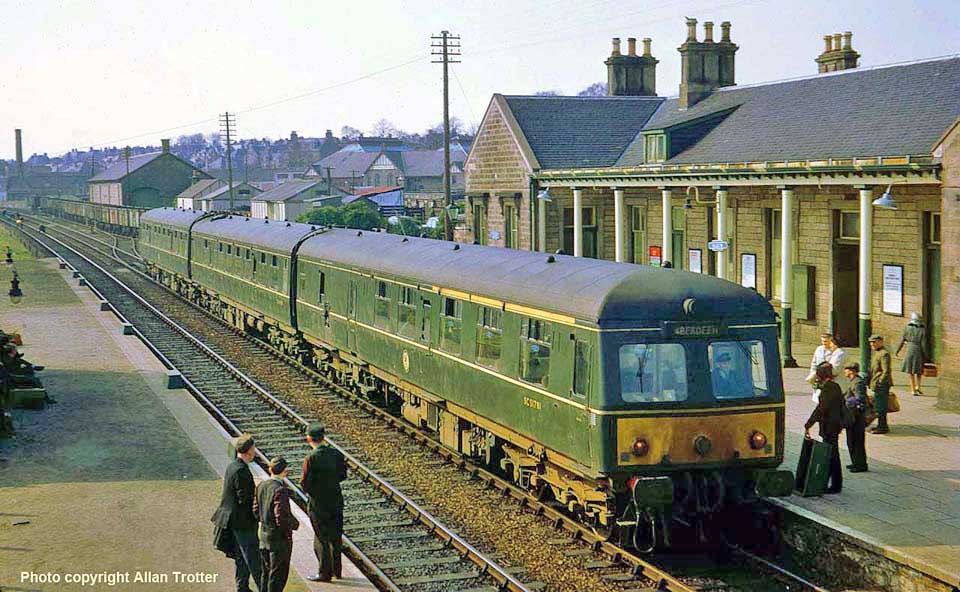
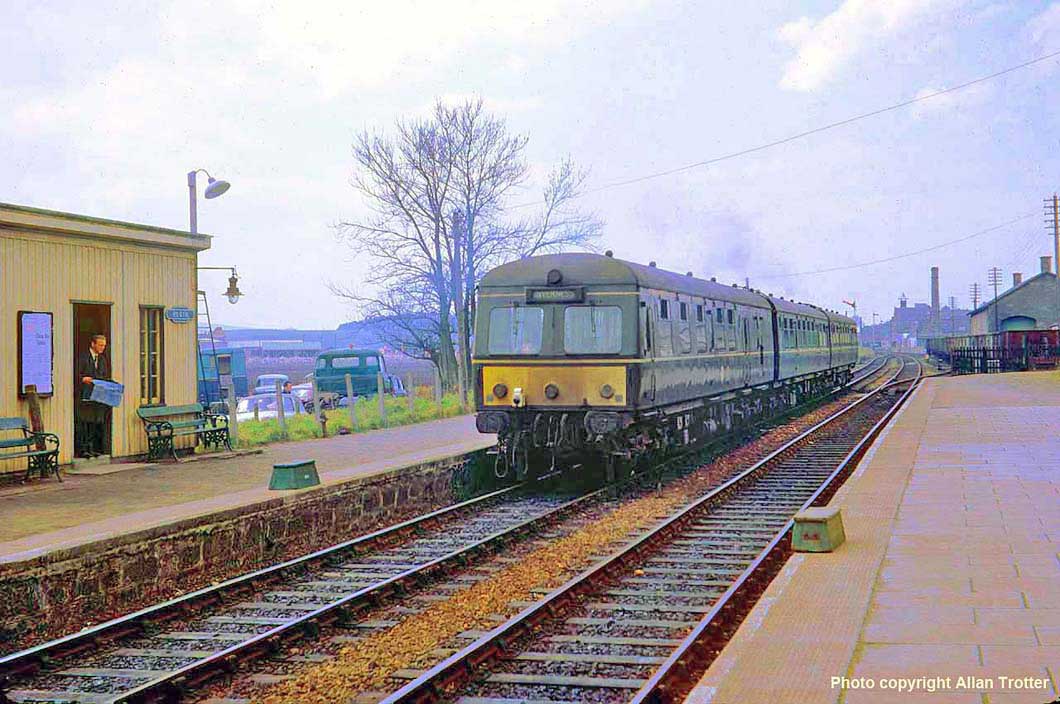
(Above-Below) A Class 120 3-car set departs from Elgin on the Aberdeen-Inverness service in April 1968. (Below) The Class 120 power-cars were fitted with two AEC 150hp underfloor engines with mechanical transmission giving a maximum speed of 70mph. In Allan Trotter's third shot at Elgin in April 1968, the leading vehicle of this 3-car set is sporting its original green livery with straw lining, while the trailing cars are in the new BR blue…note the single-line tablet catcher inset on the vehicle on the left, and the 'Blue Square' coupling code symbol visible on the rectangular warning panel. There is plenty of detail here for the discerning modeller to absorb, including the station nameplate perched precariously on the post in the bottom right hand corner.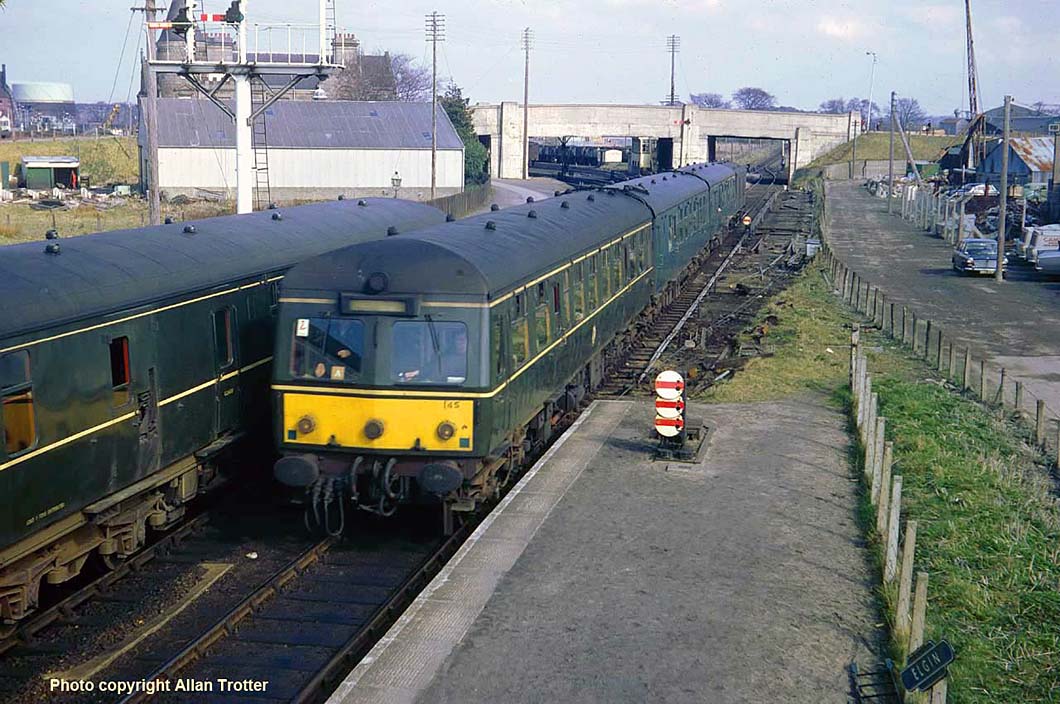
(Above-Below) When designing the Swindon-built Class 126s, pragmatism - rather than aesthetics - was the main item on the agenda, for the 70mph Inter-city 3-car sets had two front ends - a full-width cab and a half-cab incorporating a central gangway connection which allowed through access within a 6-car set for use on cross-country services. These 'Inter-City' vehicles were constructed on a longer 64'6" underframe, hence the resemblance to Mk1 loco-hauled coaching stock. Each power car produced its own control air supply and was equipped with a unique multiple-working 'White Circle' control system making them incompatible with any other dmu. Sporting full yellow ends, a 6-car set was photographed on an Edinburgh-Glasgow service at Woodilee near Lenzie in December 1970. (Below) Allan's photo collection also includes this shot of a Class 120 3-car set between Arkleston Junction and Paisley Gilmour Street.

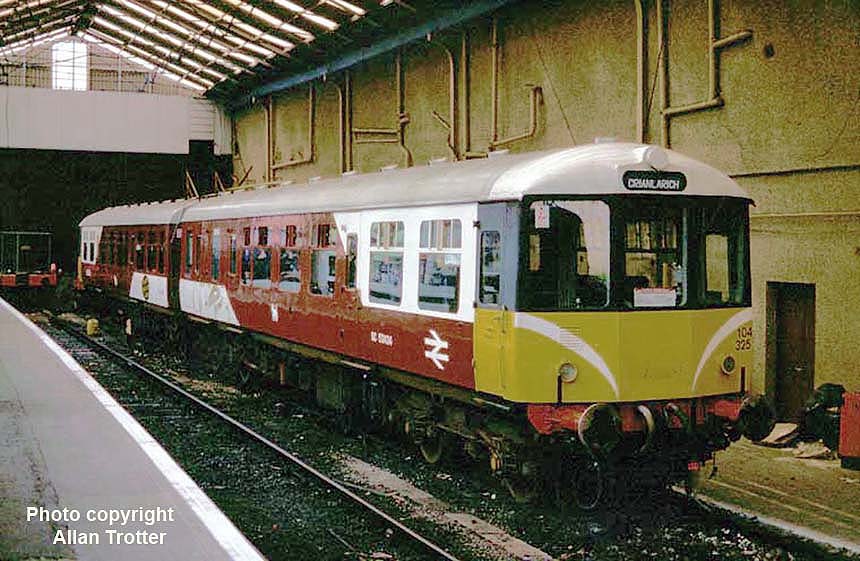
(Above-Below) Two more classic shots from Allan Trotter's collection is this one of 'Mexican Bean' in Glasgow Queen Street station. The second shot (below) was taken at Kilwinning; two things are unusual about this one. Firstly the leading coach is an ex-Edinburgh-Glasgow Swindon Intermediate Motor Brake Second with stencil headboards and not the regular Ayrshire Motor Brake Second with roller blind type. Secondly, check out the station nameplate totems. Now this is Scottish Region so why is the background in LMR maroon and not blue? Kilwinning station is on the ex-G&SW line between Glasgow and Ayr. The Swindon DMU is on the Ayr-Stranraer service and the line in the background branching off to the left goes to Ardrossan and Largs. The wrong coloured nameboards are a bit of a mystery. Date of photo is late 1970s.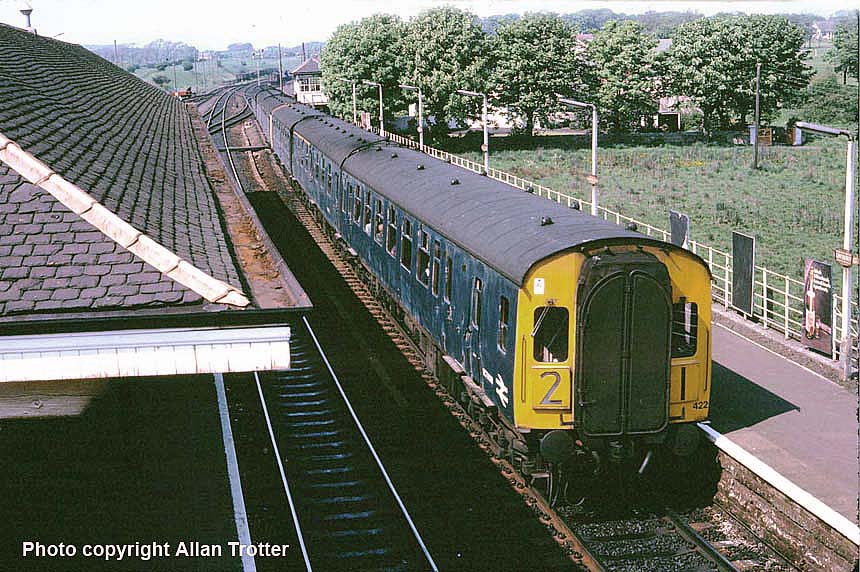
The Eastbank Model Railway Club's Website has an interesting page on the North British Type 2 Class 21 and 29 diesel electrics plus a page featuring the overnight Fort William-London Euston 'Caledonian Sleeper' service and a page on the Clydeside Class 303 and 311 'Blue Trains'...all in all the site is well worth a visit. My thanks to Allan Trotter who generously provided the above information on the ScR dmu fleet. (Below) In an attempt to rationalise the use of different diesels in different areas, the ten North British Loco Co's pilot-scheme Type 2 Nos D6100-9 (allocated initially to Hornsey for working Kings Cross suburban services) were transferred to the ScR in April 1960. They were accompanied by the BRCW's ten pilot-scheme Type 2s D5300-D5309, joining the first production models which had arrived on the ScR during May the previous year for working Edinburgh-Aberdeen services. During manufacture of the NBL Co Type 2, the makers utilised some original tools and aluminium castings devised for the company's earlier pilot-scheme 'Warship' class A1A-A1A's Nos D600-D604, which led to the rather odd front-end shape of the D6100s - odd, because the driver's visibility was impaired by the accentuated curve of the cab windows which were designed to accommodate the central gangway door in the nose end (as stipulated by the BTC to allow crew movement between locomotives when working in multiple). Eventually all the NBL Type 2s were transferred to Scotland. No D6149 at Kittybrewster shed, Aberdeen. Ken Mumford of Abergavenny & District Steam Society recently requested a photo of a North British diesel locomotive D61xx type (in the first BR livery) for use in the Society's quarterly magazine - 'The Coal Tank' - of which he is Editor. He wanted a suitable photo to go with a snippet he came across whilst wading through several railway books and magazines. One snippet concerned a quote from a St Rollox depot engine driver, who, when asked - 'What's the best thing about these NBL type 2s,' he replied, 'The fire extinguisher! I use it more often than the throttle!' (Inset Right) Close up of the tablet catcher referred to below.
(Below) In an attempt to rationalise the use of different diesels in different areas, the ten North British Loco Co's pilot-scheme Type 2 Nos D6100-9 (allocated initially to Hornsey for working Kings Cross suburban services) were transferred to the ScR in April 1960. They were accompanied by the BRCW's ten pilot-scheme Type 2s D5300-D5309, joining the first production models which had arrived on the ScR during May the previous year for working Edinburgh-Aberdeen services. During manufacture of the NBL Co Type 2, the makers utilised some original tools and aluminium castings devised for the company's earlier pilot-scheme 'Warship' class A1A-A1A's Nos D600-D604, which led to the rather odd front-end shape of the D6100s - odd, because the driver's visibility was impaired by the accentuated curve of the cab windows which were designed to accommodate the central gangway door in the nose end (as stipulated by the BTC to allow crew movement between locomotives when working in multiple). Eventually all the NBL Type 2s were transferred to Scotland. No D6149 at Kittybrewster shed, Aberdeen. Ken Mumford of Abergavenny & District Steam Society recently requested a photo of a North British diesel locomotive D61xx type (in the first BR livery) for use in the Society's quarterly magazine - 'The Coal Tank' - of which he is Editor. He wanted a suitable photo to go with a snippet he came across whilst wading through several railway books and magazines. One snippet concerned a quote from a St Rollox depot engine driver, who, when asked - 'What's the best thing about these NBL type 2s,' he replied, 'The fire extinguisher! I use it more often than the throttle!' (Inset Right) Close up of the tablet catcher referred to below.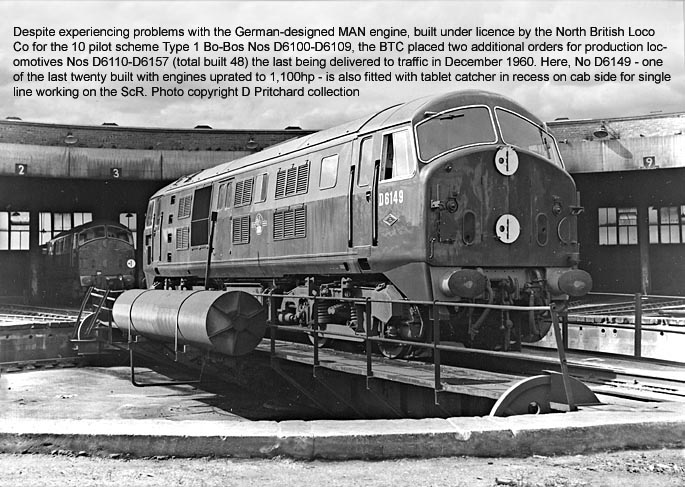
(Above-Below) Such was the success of the ten pilot scheme EE Co Type 4s for the Eastern Region, that by the time the last was outshopped in September 1958, no fewer than five orders were placed for a further 190 machines - the Vulcan Foundry constructing all but 20 of the fleet at the Newton-in-Willows erecting shops. During their early years on the ER, NE, LMR and ScR, the EE Co Type 4s gave a good account of themselves, proving to be a sturdy and reliable machine on express passenger services. The first production EE Co Type 4s destined for the LMR's West Coast Main Line were delivered between May and November 1959. The LMR's first twenty five EE Co Type 4s, Nos D210-D235 (with the exception of D226) received names taken from famous ships belonging to the Canadian Pacific, Cunard and Elder Dempster Lines - all three companies being associated with sailings from the port of Liverpool. Here, three shots of the transition from steam showing EE Co Type 4s working Anglo-Scottish expresses on the WCML at Lamington - a typical ex-Caledonian country station set in the delightful rolling hills of Upper Clydesdale. Today, all traces of the station have been removed. Photos © DP Rowland.
(Above-Below) EE Co Type 4 departs Edinburgh Waverley Station at 05.40hrs. (Below) The earliest candidate in the BTC's pilot scheme orders was the EE Co's 1,000hp Type 1 Bo-Bo Nos D8000-D8019. The production fleet outlived most of its contemporaries. The modest size of the company's 'K'-type engine enabled the makers to construct a 'hood' type locomotive with the bodyside inset along the length of the running plate. Although less glamorous than its larger EE Co relatives in the Type 3-5 power range - Class 37, 40 and 55 Deltics - the Type 1 Bo-Bo was an attractive piece of engineering design. However, the BRB's concern over the poor visibility from the cab of a single 'hood' type unit led to the introduction of the Clayton Type 1s for use of the ScR, but without the benefit of prototype trials the Clayton machines proved to be one of BR's worst buys.
(Below) Scotland's BRCW 1,160hp Type 2s (Class 26).
(Below) Class 27 at Strathyre
(Below) Forth Railway Bridge

(Below) EE Co Type 5 Co-Co (Class 55).

(Above-Below Forth and Tay Bridges...some of the diesel colour photos featured on this page were provided by 'Through their eyes.org.uk' and are available on a DVD containing 2,700 high resolution scans produced from original negatives, slides and photos. Click here for link to this interesting site. I am not affiliated in any way with the sale of DVD's.

(Below) Transition from steam at Edinburgh Waverley
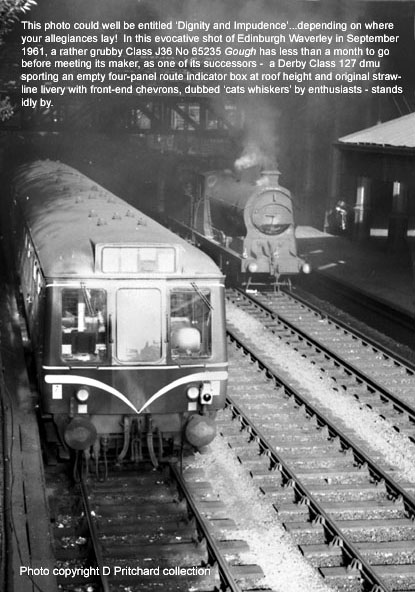
Footnote to above photo: Comments regarding accuracy are always welcome...Ian Cranna from Edinburgh points out that the grubby steam loco at Waverley (Ian's old stamping ground) is definitely not a J36, so it can't be 65235 Gough. The locomotive in question is a J37, a later, superheated version of the J35, the immediate successor to the J36. You can tell by the much larger boiler, its higher position and shorter chimney. The J37s were much more powerful, mixed-traffic locos - hence its appearance at Waverley. A J36 would not have been employed on passenger duties in the 1960s, unless it was an enthusiasts' special. Ian also points out that the unmentioned location for the photo of D6149 on the turntable is Kittybrewster shed in Aberdeen.
Michael Laing has also commented on the above photo: Hi David, I've noticed a minor error in the caption to the photo at Waverley Station, the DMU is a class 107 3-car set. At first I thought it might have been a 108 as there is a photo in 'The Edinburgh Suburban and South Side Junction Railway' by A.A. Maclean of one of those at Morningside Road station in the same livery. However, on the 108s, the lower lining band passed below the handholds under the cab windows whereas on the 107s, the band was level with the handholds. This was due to the 107s and 108s having different body-structures, with the bodyside windows positioned higher on the 107s than the 108s. As for the Class 127s, they never worked in Scotland as far as I'm aware...
Thanks to both Ian and Michael for taking the trouble.
(Below-left and right) A fine study of Brush Type 4 No D1577 at Berwick-on-Tweed in June 1964. In the background is the graceful 28-arch Royal Border Bridge which carriesthe ECML across the Tweed estuary. The viaduct was designed by Robert Stephenson and opened by Queen Victoria in 1850. Berwick station was built on the site of the former Royal Castle and part of the outer walls can still be seen adjacent to the sidings. Berwick is the most northerly town in England, though the actual Anglo-Scots border is situated at Marshall Meadows, some three miles north of the town. (Below right) EE Co Type 4 No D362 passes the British Railways Anglo-Scottish border sign with a northbound express.
 | 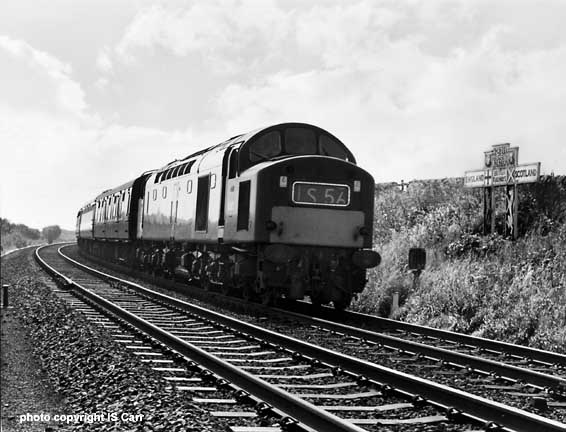 |
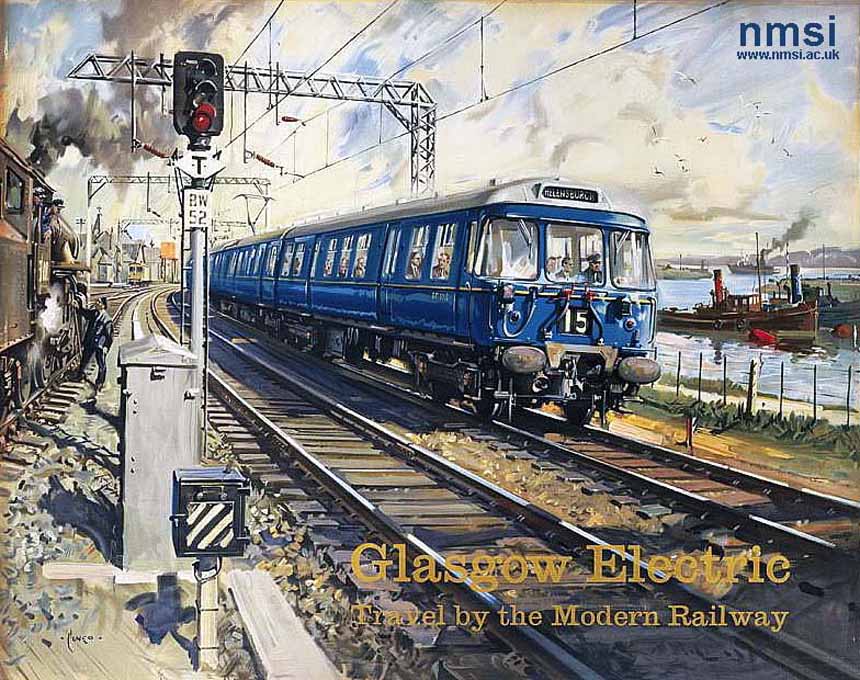
(Above-Below) Another stunning image from the NMSI Collections Online, which is a marvelous website displaying countless thousands of objects, including a range of railway travel posters. This British Railway Scottish Region poster - 'Glasgow Electric, Travel by the Modern Railway' - was painted by Terence Cuneo in 1960 and shows a 'Blue Train' AM3 class electric multiple unit (later Class 303) passing a signal gantry and a steam train alongside the River Clyde at Bowling harbor enroute to Helensburgh. (Below) The introduction of the new AM3 3-car 'Blue Trains' (Class 303) on the 25kV electrified Glasgow Suburban services was most welcome, however this can't be said for the troublesome NBL Type 2 and Clayton Type 1s, as both classes became early candidates for withdrawal. But then, there was a huge swing towards road haulage in the Sixties and the nature of work for which the early diesels had been designed (hauling light medium freight) was in rapid decline and the demise of both classes was inevitable.
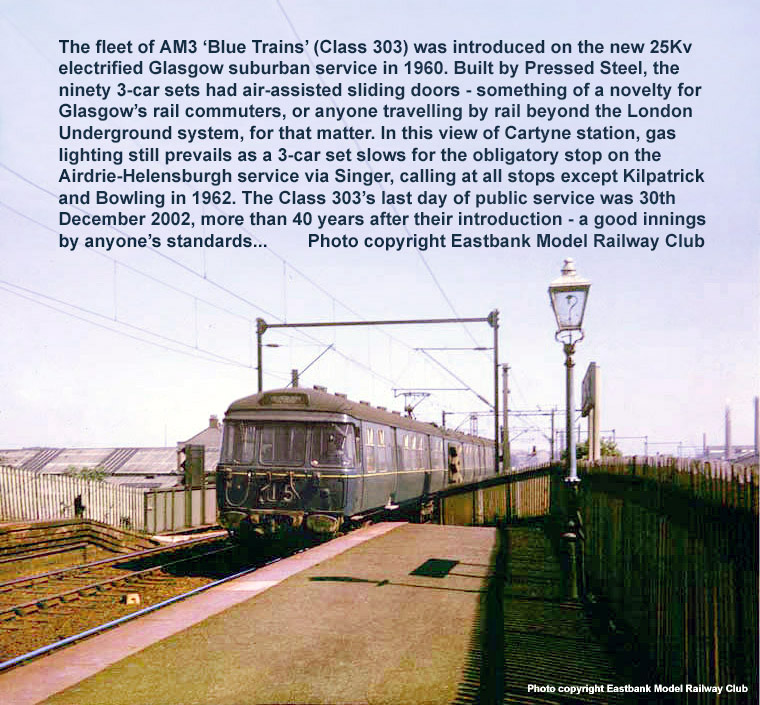
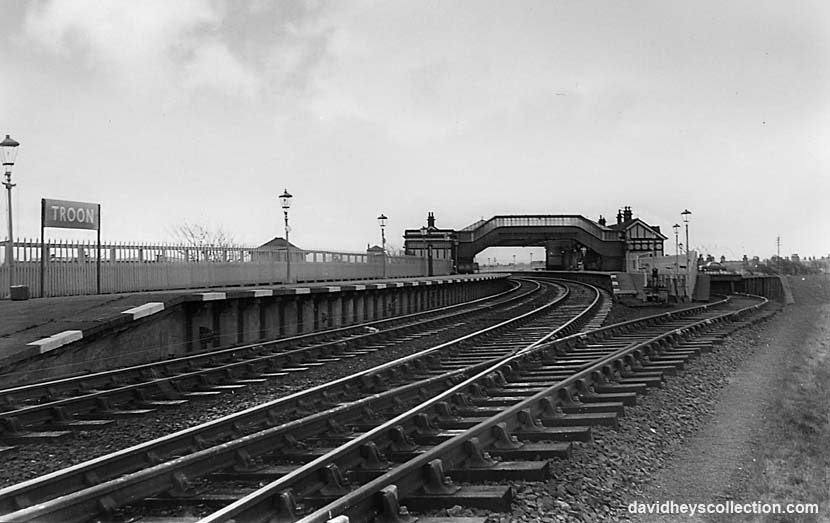
MYSTERY PHOTOS - SOLVED! I recently came across three old railway photos of stations that have been gathering dust at the bottom of a drawer for more than twenty years. The first photo (above) was easily identified as Troon station in Ayrshire; the stove enamelled 'running in' board (ScR's light blue background with white Gill Sans letters) indicates British Railways days. However the station (below) remained a mystery, so I posted an appeal for help and was contacted by Allan Trotter...see caption below. Thanks Allan.
(Above) This photo shows a railway station somewhere on the ScR; the design of the footbridge, numbered '19', is the same as the one at Troon. Just visible in the shadows of the station building is a BR totem (the station name is made up of two words, but it is impossible to read…at a guess the first word could be 'West'?). Also the home signal at the end of the platform is mounted on a typical lattice post. Result! Allan Trotter, who maintains the excellent Eastbank Model Railway Club's website (link at bottom of the page) contacted me - Hi David, I have just been looking at your web site, fascinating! I think I can help in identifying one of your pictures. I have attached it along with one of my own taken in June 1977 with an unusual visitor (Class 40) on the Largs line. Location is West Kilbride. Hope this is of interest. With best wishes, Allan Trotter 
(Above) A lattice signal appears in the third photo This view shows a footbridge in the middle distance spanning the main line plus an expanse of abandoned track either side of it, but the biggest clue is the domed roof of the building on the right. Result! Chris Dobson has identified the 3rd photo as the original Troon station (Troon Old) on the Glasgow, Paisley, Kilmarnock and Ayr Railway. It closed to passengers in 1892 on the opening of the new loop line to the west and the new Troon station nearer the town centre. The building in the right background is Marr College, a well known local landmark. Best wishes, Chris. (Left) Meanwhile I've received a letter from Frank McKee, who writes - 'Many thanks for allowing Aiden Keane to publish your photo Troon station on 'Jeanie's Jotter' this week. I lived in the station house for around 12 years until 1962, and the platform and scrap yard on the left were my playgrounds. I mentioned in an issue of the 'Jotter' that I used to watch the Clan Pacifics flying by, to and from Stranraer, but it must have been about thirty years later when I saw a photo in a magazine that I realised they were painted green. I never ever saw a clean engine, and just presumed that they were black! Some crews used to chuck off huge chunks of coal on to the platform for our fireplaces...' Photo of present-day station site at Troon attached (above left)
(Left) Meanwhile I've received a letter from Frank McKee, who writes - 'Many thanks for allowing Aiden Keane to publish your photo Troon station on 'Jeanie's Jotter' this week. I lived in the station house for around 12 years until 1962, and the platform and scrap yard on the left were my playgrounds. I mentioned in an issue of the 'Jotter' that I used to watch the Clan Pacifics flying by, to and from Stranraer, but it must have been about thirty years later when I saw a photo in a magazine that I realised they were painted green. I never ever saw a clean engine, and just presumed that they were black! Some crews used to chuck off huge chunks of coal on to the platform for our fireplaces...' Photo of present-day station site at Troon attached (above left)
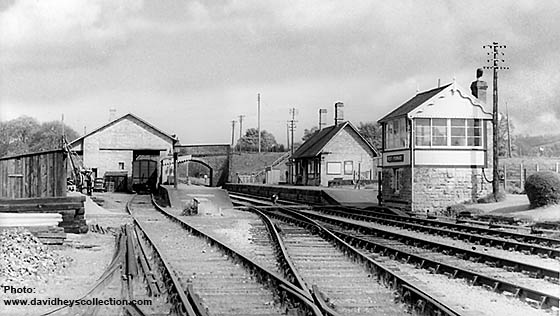
NO IT ISN'T! After posting Ian's photo I was contacted via the Guest Book Page by Chris Maughan, who writes - 'May I kindly suggest that the Scottish Region mystery photograph is not New Cumnock. Indeed, I do not believe it is Scottish. As a young volunteer at Midsomer Norton South station, the signal box looks like Somerset and Dorset Railway architecture and the box that has been rebuilt at MSN (South). As the name on the signal box appears to have two words, may I suggest this could be West Pennard on the line from Evercreech to Highbridge...'
Well, hat's off to Chris. He is absolutely correct and I am more than happy to rectify the mistake. My thanks to everyone for their help.
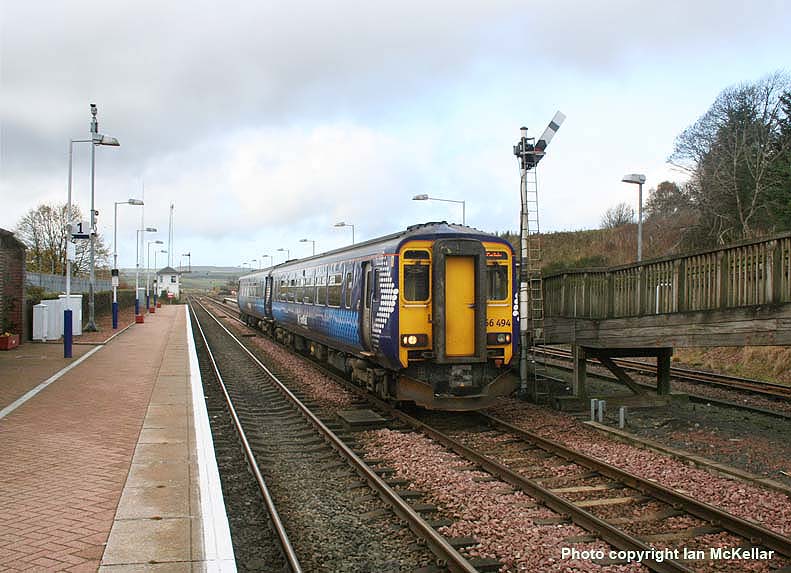
LINKS BELOW TO RAILWAY SITES WITH A SCOTTISH CONNECTION
The Scottish Railway Preservation Society (SRPS) was founded in 1961 to preserve and display Scotland's Railway heritage. The Society's Core Collection - recognised by the Scottish Executive as one of national significance - can be found on the Bo'ness and Kinneil Railway, just west of Edinburgh, on the southern shore of the Firth of Forth.
The Eastbank Model Railway Club's Website includes an interesting page on the North British Type 2 Class 21 and 29 diesel electrics; another page about the overnight Fort William-London Euston 'Caledonian Sleeper' service, and a page on the Clydeside Class 303 and 311 'Blue Trains'. The site is maintained by Allan Trotter
The Waverley Route Heritage Association (WRHA) is intending to reopen part of the Waverley route, built by the North British Railway Company from Edinburgh to Carlisle through Midlothian and the Scottish borders. The first section from Edinburgh to Hawick was opened in 1849 and the Carlisle to Hawick section opened in 1862. The entire line fell victim to the Beeching axe in 1969.
It should be pointed out that some of the photos on this page are reproduced courtesy of Jim Payne's excellent CD from www.throughtheireyes2.co.uk I am not affiliated with the sale of CDs in any way, merely reproducing what I think are interesting images of Scottish Region steam.
Polite notice: All text and photographs are protected by copyright and reproduction is prohibited without the prior consent of the © owners. If you wish to discuss using the contents of this page the email address is below. Please note - this is not a 'clickable' mail-to link via Outlook Express. You will have to email manually
dheycollection@ntlworld.com



